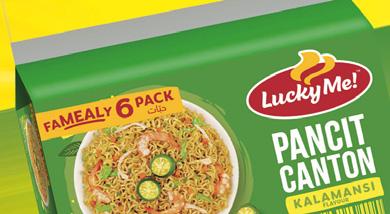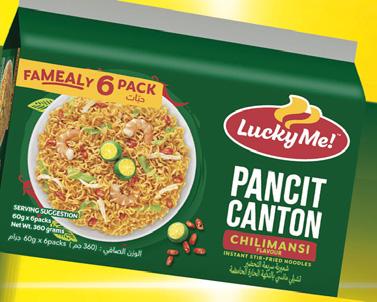





FRUITS
DURIAN, POMELO, MANGOSTEEN, RAMBUTAN AND MORE EXOTIC

Meet Kooya’s chef JP Filipino food
MAY/ JUNE 2025
DHS/SAR 10 (inclusive of VAT)







DURIAN, POMELO, MANGOSTEEN, RAMBUTAN AND MORE EXOTIC

Meet Kooya’s chef JP Filipino food
MAY/ JUNE 2025
DHS/SAR 10 (inclusive of VAT)
More than 80 recipes from Asia’s most delicious destinations






























































This edition of Nourish is inspired by the East – from Japan to the Philippines, China to Singapore – vast regions that are bursting with flavour, creativity and culinary heritage. From matcha and boba to pimped-up noodle pots, bao and Korean BBQ, we’ve packed in more than 80 recipes to inspire you.
Come along as we travel to Vietnam, from Dalat’s cool-climate Fuji melon farms to The Fruit Republic’s exotic orchards in the south where Medusa-like dragon fruit trees, pink and white pomelos, jackfruit and limes thrive.
(Pro tip: lime juice and sunshine don’t mix – I came home with a jellyfish-shaped burn. My accidental travel tattoo!)
In Thailand, we journeyed all over with our partner Soonthorn from Blue River, visiting small-scale farmers and tasting our way through an astonishing variety of mangoes. We watched durians being expertly lanced from towering trees and cracked open jewel-like mangosteens in shaded groves. Along the way, we had to make a detour to meet TikTok star Moo Deng, the baby hippo with a cult following. Look out for our travel vlog on YouTube to learn more about her!
Looking to book your summer holiday break? Escape to Chiang Rai for luxury bubble-tent camping, rescued elephants and incredible Thai food; Koh Samui for a White Lotus-style stay – no drama, just bliss; or a leisurely boat cruise down the Mekong in Laos.
We hope you love this issue as much as we did putting it together.
Until next time

Nourish by Spinneys brings you engaging conversations, fresh ideas and hopefully the inspiration to help you eat and live well. Available on Spotify, Apple Podcasts and Anghami. by
THIS MAGAZINE IS PRODUCED BY
CEO SUNIL KUMAR
GENERAL MANAGER OF COMMERCIAL TOM HARVEY
GENERAL MANAGER OF MARKETING WARWICK GIRD
CREATIVE AND CONTENT DIRECTOR TIFFANY ESLICK tiffany.e@finefarefood.com
DEPUTY CONTENT EDITOR KAREN D’SOUZA
DESIGNERS
COLEEN ESTOQUE, EMILY EVANS & FRANCIS GACER
DIGITAL MARKETING MANAGER ANKIET GULABANI
DIGITAL CONTENT MANAGER LYNN SOUBRA
SOCIAL MEDIA MANAGER RASHA EL SALEH
CONTENT ASSISTANT DIANNA ACIBAR
CONTRIBUTORS
LEEN AL ZABEN, KATELYN ALLEGRA, MICHELLE CLEMENTS, DEVINA DIVECHA, JORDAN FARRELL, AASIYA JAGADEESH, STEPHEN PHELAN, LINDSAY TRIVERS, & CASSANDRA UPTON
PUBLISHED ON BEHALF OF SPINNEYS DUBAI LLC BY
Spinneys Dubai LLC and the publishers regret that they cannot accept liability for error or omissions contained in this publication, howsoever caused. Readers are advised to seek specialist advice before acting on information contained in this publication, which is provided for general use and may not be appropriate for the readers’ particular circumstances. No part of this publication or any part of the contents thereof may be reproduced, stored in a retrieval system or transmitted in any form without written permission.
THE CUT
09 WORD OF MOUTH
New products, the latest trends, events and foodie news
10 7 OF A KIND
Discover the savoury magic of umami — the fifth taste — with Asian pantry staples like kombu, nori, soya sauce and more
13 DRINKS
15 RESTAURANT ROUND-UP
Savour a variety of East Asian flavours at these new restaurants in Dubai
16 THE SOUL OF FILIPINO FOOD
At Kooya Filipino Eatery in Dubai, chef JP Anglo is doing more than just cooking food. Rather, he’s rewriting the narrative around Filipino cuisine, one dish at a time
18 MARBLED TO PERFECTION
Step inside the world of wagyu with Tokyo’s legendary butcher-chef ‘Boss’ Tanaka, where precision, patience and pedigree shape every unforgettable bite

20 QUIET ELEGANCE
In a century-old Tokyo townhouse, soba becomes a meditative ritual – pure buckwheat, handmade daily, revealing Japan’s quiet culinary poetry
22 USE IT UP
Don’t discard leftover spring onions, radish, turnips and red chillies. Instead use them to make fried rice, pickled veggies and a fiery chilli paste
24 READ, WATCH, LISTEN Cookbook, podcast and streaming recommendations
27 Our seasonal highlights include mangoes, rhubarb, lotus root, strawberries and durian
34 We work closely with the Isle of Wight company in the UK to bring in an array of premium-quality tomatoes that surpass other varietals in terms of appearance, flavour and texture
40 EASTERN PROMISES
Jackfruit, dragon fruit, pink pomelo… Spinneys sources premium Vietnamese fresh produce through The Fruit Republic. On a visit to the Mekong Delta and beyond, we learn how the company is investing and innovating in that country’s extraordinary agriculture
44 FRUIT OF THE ROYAL FAMILY TREE
Beloved by many but a new discovery for others, the Japanese muskmelon is making its way around the world from a special farm in Vietnam where only the best is selected…
48 THE SWEETEST TREES IN THAILAND
From mango and lychee orchards to durians that grow high above the forest floor, the Blue River company cultivates the best Thai tropical fruits on small farms across the nation
53 Whip up vibrant East Asian curries, rich in spices and regional flavours
62 OODLES OF NOODLES
From smoky char kway teow to refreshing oroshi soba, these vibrant dishes celebrate bold flavours, textures and techniques from across Asia’s diverse culinary landscape
68 INSTANT GRATIFICATION
Turn cup noodles into fun, flavour-packed meals with our creative twists. From spicy broths to crunchy cheese toasties, these pimped-up pots and packs are pure comfort
74 LETTING OFF STEAM
Steaming traditions from across the East inspire these flavour-packed recipes, from Thai nam jim fish to Japanese chawanmushi and spicy galbi jjim
82 TAKE A BAO
Try these favourite fluffy buns with recipes from Korea, China and Japan. Plus, master the art of making them from scratch at home
88 HUG IN A BOWL
Deeply flavourful and aromatic, these soups and broths from Vietnam, The Philippines, Thailand and China are nourishing and heart-warmingly satisfying
94 RICE, RICE BABY
As a staple ingredient across Asia, this grain features in bold dishes that are full of history
100 STREET STYLE
From smoky sate ayam to spicy tteokbokki and lace dumplings, here’s our take on Asian street food dishes that are all ideal for sharing, snacking or relaxed weeknight meals
108 SIDE HUSTLE
Explore the delicious world of banchan – Korean BBQ’s essential accompaniments. From pickled salads to pancakes, these flavour-packed dishes are just as vital as the meat
114 CRUNCH TIME
It’s time to indulge in dishes offering that perfect crackle and snap... these recipes are here to deliver the ultimate crunch factor
5


120 SIP & SAVOUR
Floral, fruity and deeply aromatic, these drinks embrace trending flavours –pansy blossom tea, strawberry lemon milk, cherry cloud latte and sesameinfused coffee jelly
124 GAME, SET, MATCHA
Master matcha with our ultimate guide. From understanding grading to brewing to making cookies, sandos and drinks –discover just how versatile it can be
130 TRENDY TREATS
You’ve seen them all over your social feeds – now it’s time to bring them to your kitchen. From viral sensations to modern takes on beloved favourites, these desserts are here to become your next obsession. Are you ready to take a bite?
137 Kids will love assembling these bento boxes filled with pandas, chicks, bunnies and more
144 WILD LUXURY
At Anantara Golden Triangle Elephant Camp & Resort, Tiffany Eslick finds sky-high experiences, soulful encounters with gentle giants and delicious northern Thai flavours – all wrapped in adventure, thoughtful sustainability and some of the most imaginative stays in Southeast Asia
148 A WHITE LOTUS AFFAIR
Even without the theatrical ensemble cast, a getaway to the Anantara Lawana Koh Samui is one you won’t soon forget

152 GO WITH THE FLOW
A river cruise is a great way to explore the countryside near Luang Prabang, a UNESCO World Heritage Site in Laos that still carries an air of old-world charm and an appreciation for slow living
157 KOREAN PERFECTION
All you need to know about the three K-beauty brands recently launched in stores

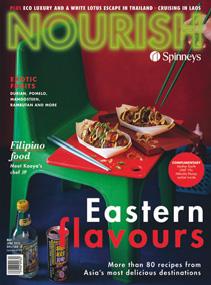














































































Food, restaurant and product news that we think is worthy of being on the list

the 16-ingredient










Just as the temperature starts climbing, we’re bringing the A-game to you with a brand-new range of Spinneysfood frozen treats. Think of silky tiramisus, indulgent chocolate profiteroles and gooey molten lava cakes – all ready in your freezer for when those cravings strike. If you’re more into fro-yo and something tangy, then you’re in luck, too. Our Spinneysfood Luxury Greek-Style Full-Fat Yoghurt is also making its way to shelves soon – in flavours like strawberry, lemon curd and blueberry. This is just perfect for those who like their desserts a little lighter, but just as satisfying.



The first half of May will mark the final stretch for two much-loved Dubai venues –Global Village and Ripe Market – before they wrap up for the season.
The 29th season of Global Village will close on 11 May. If you haven’t made your way there yet, now is the time to check out the many wonders from across the world, snack your way through more than 200 eateries (don’t miss the Floating Market!) and shop for everything from
clothes to handmade crafts and souvenirs. Meanwhile, Ripe Market at Dubai Police Academy Park will also be winding down for the summer, with May serving the last opportunity to check out its many delights. While you’re there, you can shop for fresh produce, grab a bite from a local food truck or pick up goodies from homegrown brands. It’s a great way to spend a weekend morning with the family or friends.
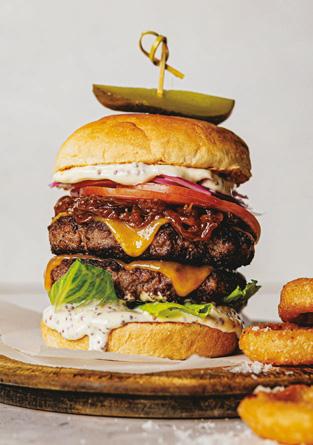
Mark your calendars because May and June are packed with delicious international food days that are worth celebrating. Whether you’re marking International Hummus Day (13 May), Burger Day (28 May), or the International Day of Potato (30 May), we can help you lean into your cravings.
Want to join in? All you need are a few great ingredients – and Spinneys has you covered. Celebrate Burger Day with a build-your-own party using Spinneysfood burger patties (plant-based included) paired with our famous Spinneysfood Brioche Burger Buns. For Potato Day, we highly recommend snapping up the Spinneysfood Baby Potato Roasting Kit for perfectly seasoned spuds.
And when it comes to Hummus Day, why stop at just one? Scoop into a tub (or four) of Spinneysfood Hummus – pick from classic, red pepper, peri peri and jalapeño and lemon. Here’s a fun fact for you: the word ’hummus‘ comes from the Arabic word for ‘chickpeas’. And really, it’s more than just a dip... it’s a staple. So go ahead and celebrate these days, and make your everyday meals a little more fun.

Nori or dried seaweed is made from red algae. Thin and crisp with a delicate briny flavour, nori can be eaten as is, or rehydrated in soups and salads, or most recognisably as the wrap that holds sushi together.
A rice-based condiment that’s a staple ingredient in Japanese cuisine, mirin imparts a subtle sweetness coupled with mild acidity to mains such as teriyaki salmon, ramen and donburi as well as to marinades and sauces.
The main ingredient in any dashi is katsuobushi or dried bonito flakes. These flakes are made from skipjack tuna, which undergoes a process of cutting, boiling, smoking, drying and shaving. This can take anywhere from five months to two years. Bonito flakes taste mildly fishy with a deep savoury and umami flavour as a result of the smoking stage.
Light, dark and all purpose, soya sauce is available in three forms with varying degrees of saltiness. This condiment is produced by fermenting cooked soya beans with cooked wheat grains in a brine, which is then pressed to extract the sauce. Light and dark soya sauce are not interchangeable, with the former being used to add saltiness to dishes, minus the colour and strong soya flavour which the dark sauce delivers. All purpose soya sauce can be used in place of the light variety.
Being heat-aged in a carefully controlled humid environment caramelises garlic pods or individual cloves into inky black, sweet pockets of rich umami flavour. Black garlic has a flavour that’s been likened to aged balsamic vinegar as well as liquorice.

Discover the savoury magic of umami – the fi fth taste – with Asian pantry staples like kombu, nori, soya sauce and more
Dark and rich red miso, also known as aka miso, is made with a higher proportion of soya beans to koji rice. Its fermentation period can range from six months up to five years, which results in colour variations from reddish brown to black. The deep, intense flavours of this miso make it ideal for hearty meat-based dishes, stews and oily fish such as mackerel and salmon.
When sea kelp is harvested, cut and left to dry in the sun, an amino acid called glutamine rises to its surface. Dried sea kelp or kombu gets its flavour from this amino acid which appears as a white powder that is packed with umami flavour. Use it in soups or broths for a salty, umami hit.

A refreshing Thai cooler with basil, red chillies and lime served in a fresh coconut or glass

Refrigerate the coconut ahead of time if you plan to drink this cooler straight out of the coconut rather than a glass.

Thai cuisine is known for its balance of flavours – sweet, sour, spicy and aromatic. The coconut cooler we’ve created sticks to those principles while incorporating classic Thai ingredients, creating a refreshing and health-boosting beverage that feels like a tropical escape in every sip.
One of the key influences behind this drink is nam manglak, a traditional Thai beverage that uses basil seeds for their cooling and digestive benefits. We’ve enhanced the health properties further by incorporating fresh coconut water, which is rich in electrolytes and hydration-enhancing nutrients. Coconut water is also known for supporting skin health and promoting digestion, making this drink not only delicious but also nourishing.
However, health isn’t the only focus here, this drink is all about flavour. The brightness of Brazilian lime and the fragrant Thai syrup, infused with fresh lime leaves and lemongrass, together with the gentle heat from the red chilli, make this drink both refreshing and exciting for the palate. Whether you choose to serve it over ice or straight from the coconut shell, this cooler is a must-try for those who love Thai flavours and crave a refreshing beverage.
Prep time: 15 minutes (plus soaking time)
Cook time: 5 minutes
Serves: 1
For the Thai syrup
6 Blue River Fresh Lime Leaves
1 stem organic lemongrass
200g Spinneysfood Extra Fine Caster Sugar
250ml Spinneysfood Bottled Drinking Water
For the cooler
½ tbsp basil seeds
3 tbsp water
2 Thai red chillies
1 Grando Coconut
1 Brazilian Lime
44ml Thai Syrup
1 To make the syrup, bruise and roughly break up the lime leaves and lemongrass. Add them to a pot with the sugar and water and place over a medium heat. Bring to a gentle simmer, stirring for approx. 1 minute until the sugar dissolves. Turn off the heat and allow the mixture to cool to room temperature. 2 Strain the syrup into a bottle, then seal and store in the fridge for up to 2 weeks. 3 To make the cooler, soak the basil seeds in the water for at least 3 hours before making the drink. 4 Remove the seeds from one chilli and roughly chop. Open the coconut and pour the water into a large bowl. Squeeze in the lime juice, add the syrup, chopped chilli and basil seeds. Let the mixture sit for 10 minutes. Strain the drink back into the coconut shell or into a tall glass filled with ice. 5 Decorate with the whole chilli, if using a glass, and serve.
EARTH’S FINEST ORGANIC
KING COCONUT WATER
This has been extracted directly from Sri Lankan king coconuts, handpicked from organically certified farms. earths-finest.com
COCOFLY SPARKLING
COCONUT WATER
Enjoy all the naturally hydrating qualities of still coconut water but with a bubbly twist. cocofly.life
INNOCENT COCONUT WATER
Quench your thirst with 100 per cent pure coconut water from three coconuts, without any additives. innocentdrinks.co.uk






















































Savour a variety of East Asian flavours at these new restaurants in Dubai










1Perched within the serene St. Regis Gardens, Palm Jumeirah, HANU offers a contemporary take on Korean cuisine, led by chef Kyung Soo Moon. You might have seen this on your socials: chicken nuggets topped with caviar. Well, you’ll find them at HANU and the unlikely pairing works surprisingly well. The kimchi arancini with quail egg and chilli pickle is inspired by chef Kyung’s mother’s kimchi rice and is a hearty appetiser. For a refined take on Korean BBQ, the restaurant’s ‘Meat Me at the Grill’ experience is a must-try. Each table features a charcoal grill and should you choose this option, the team prepares four cuts of meat to your liking, right at your table. We tried the Wagyu rib-eye, Japanese A4 Wagyu striploin, oyster blade and the Korean shortrib galbi. This is complemented by fermented and pickled condiments (banchan), green leaves, salad and a truffle egg custard. Worth the wait is the sweet surprise at the end: diners leave with a taste of hodugwaja, which are bite-sized cookies filled with red bean paste and walnuts.
2
Chef Akmal Anuar’s latest venture at Wasl 51, Harummanis is a personal, heartfelt tribute to his roots and the culinary heritage of Singapore’s Malay community. Named after the family’s 32-yearold nasi padang hawker stall in Singapore, and the fragrant Harumanis mango, this warmly lit space fuses nostalgia, storytelling and innovation in equal measure. “Our cuisine is indigenous,” says Akmal, proudly showing me wing beans, coconuts, fistfuls of ginger
and buah keluak, a fruit native to Southeast Asia that falls to the ground when ripe, and is poisonous if not properly prepared. Don’t be put off by the latter, the result is a menu grounded in tradition, elevated with beautiful flavours. Start with kinilaw – seabass ceviche in a coconut-lime dressing with ginger and chilli – clean, vibrant and full of zing. The ayam masak putih, a coconut-based chicken stew, is grilled over charcoal for a smoky depth, served with charred corn. And the beef cheek rendang is a standout: deeply aromatic, fall-apart tender and made with over 20 ingredients simmered for six hours. For a healthful interlude, the jamu – traditional medicinal drinks made from roots, seeds and leaves – offer earthy, restorative notes. Dessert impresses, too: the Harumanis mango curd with kaffir lime, meringue and edible flowers is a bright, textural revelation while Sarang Semu – a bitter keluak chocolate mousse with honeycomb cake and honey ice cream – is rich, bold and beautifully balanced.
3Newly opened in April 2025 at Vida Emirates Hills, Kasumigaseki is setting out to share high-quality Japanese food with its diners. The spacious and stylish venue puts the kitchen centre stage – you can opt to sit at the high chairs along the kitchen counter for a chef’s table experience or sink back into the comfortable booths dotting the restaurant. With both a la carte options and two tasting menus, you’ll be spoiled for choice, and we went with the Toriwake sharing menu. The Kaisen salad was a welcome start, with salmon, shrimp and mussels dotting the fresh


CLOCKWISE, FROM TOP LEFT: HANU’s Meat Me at the Grill experience; Harummanis mango curd with keffir lime, meringue and edible flowers; the interiors of HANU include nods to Korean culture; the fresh strawberry shortcake mochi with whipped cream and freeze-dried strawberry at Kasumigaseki is surprisingly delightful.
leaves, paired with chunks of fig. The freshness and quality of the seafood shone through, especially with the plate of sashimi that graced the table. We can’t resist fried chicken and Kasumigaseki’s karaage, made with chicken thighs, was juicy within and perfectly crispy on the outside – as it should be. All the dishes delighted, but perhaps none more so than the sweet finale: fresh strawberry shortcake mochi with whipped cream and freeze-dried strawberry. Let’s just say we wouldn’t have said no to seconds.

At Kooya Filipino Eatery in Dubai, chef JP Anglo is doing more than just cooking food. Rather, he’s rewriting the narrative around Filipino cuisine, one dish at a time
We’re sitting in front of the pass at Kooya Filipino Eatery and its chef-founder, JP Anglo, won’t stop smiling as we talk about Filipino cuisine, his restaurant and team. Behind that smile is decades of experience in the culinary world where he has been busy carving out a well-deserved space for his country’s cuisine – within the Philippines itself and now the UAE and globally.
JP made his way to Dubai about four years ago and that’s when a spark was ignited. JP says, “Dubai is a dynamic place. A hotel group invited us over to do a pop-up. We came, we cooked and we realised that we could change a person’s morale and happiness through food.” He pauses, and says, “Food is really one of the strongest currencies. And food brings us together. Food breaks boundaries.” Soon after, he launched Kooya Filipino Eatery in the heart of Dubai Marina, where Filipino culture is recognised and celebrated.
But getting to this point was anything but linear. He says, “One thing I’m really good at is cooking. It gives me great joy to feed people. It gives me great joy to see someone smile because of food.” Discovering that was a process in itself. He says, “I tried other things and failed. I was in three universities… it didn’t work. When I went to the Center for Culinary Arts in Manila, something worked.” He does admit it wasn’t smooth sailing. Time spent in Australia at Le Cordon Bleu tested him further, but it also built the backbone of who he is now. “It was a hard phase of my life, but that taught me resilience. It was literally earning your stripes. I am who I am because of that.”
While his first restaurant was opened before he went to Australia, after returning home, he opened an Asian restaurant that remains open to this day. But it was his sister’s question that redefined the direction of that restaurant and of how he approached food. He reminisces, “My sister said to me, ‘JP, you’re Filipino. You come from Bacolod City. Why aren’t you cooking our food?’ I realised she had a point.” So, he started with a little Filipino section within the Asian menu. Then he decided he wanted to go to Manila and cook Filipino food there. “I wanted to get out. I wanted to roll with the big boys. And I thought I was ready because I had my training in Australia. But there were the same challenges: I got to Manila, no one knew who I was, no one believed in me,” he says. Still, he pushed forward. “I’m used to rejections. I’m used to failures. But I know how to claw my way back.”
And so he did. Eventually, his Manila restaurant, Sarsa, did so well, that he was able to expand to six venues within five years. But then, after experiencing the intense demands of running multiple venues, he scaled back. “I just realised I’m not the type of chef who’s good at the volume game. Now I have one and it’s delicious. I know every single one of our team members.”
It’s this very back-to-basics approach that he’s brought to Kooya in Dubai. “Let’s prove to our


fellow Filipinos that our food is good, that our food can go beyond the doors of our house.” JP believes that one of the biggest challenges in bringing Filipino cuisine to a wider audience is perception. “Some people think that we begin and end with lumpia, pancit and adobo,” he said.
The way people respond to Kooya shows the emotional power of food, especially among the Filipino diaspora. He says, “They say it tastes like home, like their mom or their grandma cooked it. I guess what they’re tasting – cheesy as it may sound – is a lot of love.” For non-Filipino guests, the experience often comes as a surprise. “They thank me. When I ask why, they say that we have been coexisting with you for decades, that we start with friendship, karaoke and drinks – but never reach food.”
Awards and accolades are rolling in, but JP remains grounded. “We are extremely honoured and flattered. The team is in high spirits – they are so proud to work here and to cook Filipino food. But my dad would always tell me, ‘Never rest on your laurels. Be good at what you do and money will run after you. When it comes to your job, always strive to be better.”


He’s continuing, therefore, to spread the word about Filipino food. JP says, “I know our product is good. I know our cuisine is good. Let’s stand our ground – because we have a tendency of [stepping back]. Our job as the next generation is to make it cooler, make it more accessible and relatable. But at the same time, not losing the very essence or soul of our cuisine.”
by
Step inside the world of Wagyu with Tokyo’s legendary butcher-chef ‘Boss’ Tanaka, where precision, patience and pedigree shape every unforgettable bite
Most conversations about Wagyu beef begin and end with talk about its intricate marbling, but the story of Wagyu goes far beyond that.
Chef Tanaka, known to regulars and, anyone really, simply as ‘Boss’, stands at the intersection of age-old butchery traditions and modern culinary craft. Even though I’ve lived in Japan for years, I’m still uncovering new depths to Japanese beef. I’ve walked the pastures in Kobe, shared stories with farmers and tasted Wagyu at countless restaurants. Yet only after meeting Boss this past January did I truly see how it all fits together.
At his combined butcher shop and restaurant in Ginza, Nikuya Tanaka, guests learn that Wagyu’s reputation for melt-in-your-mouth richness is a testament to decades of careful breeding, nurturing and cooking methods. Descended from a long line of butchers, Boss learned early on to respect every part of the animal, first mastering the art of carving, then refining those skills in the kitchen.
For much of Japan’s past, religious and cultural practices restricted meat consumption, which meant beef was a rarity until Western influence increased in the mid-19th century. By the early 20th century, selective cross-breeding of native Japanese cattle with certain European breeds set the stage for what we now call Wagyu. The name itself literally means “Japanese cow,” combining wa (meaning “Japanese”) and gyu (meaning “cow”). Out of this lineage emerged the four main Wagyu breeds, prized for their extraordinary intramuscular fat: Japanese Black, Japanese Brown, Japanese Shorthorn and Japanese Polled. Over time, strict regional rules, meticulous record-keeping and a commitment to raising cattle under low-stress conditions preserved these traits, making Wagyu one of the most coveted meats in the world.
Two of the most famous Wagyu-producing regions are Hyogo and Mie prefectures, home to Kobe beef and Matsusaka beef respectively. Kobe beef, sourced from Tajima-line cattle raised under stringent guidelines, has become the most internationally recognised Wagyu brand. Only cows that meet high standards for marbling, colour and texture can bear the Kobe name. Its global popularity stems from a signature balance of fatty richness and umami-rich beef flavour.
Matsusaka beef, on the other hand, comes from Mie Prefecture and often features virgin female cows. These heifers typically mature beyond 36 months, sometimes reaching 45 to 50 months. Many beef connoisseurs claim this longer growth period yields a subtler yet more deeply woven marbling that isn’t always visible to the naked eye. Although it can look less dramatic than Kobe’s flashier “spider webs” of fat, Matsusaka’s fine-grained marbling melts easily at lower temperatures, creating a sweet taste that lingers on the palate. This is what sets Matsusaka apart from other types of Wagyu beef in Japan and beyond.
In today’s terms, Wagyu covers the specific breeding, feeding and stress-free living conditions practiced by Japanese ranchers. One shared

a brief sear on the grill is all it takes to melt the intricate web of fat and bring forth the beef’s subtle sweetness; chef Tanaka aka Boss.

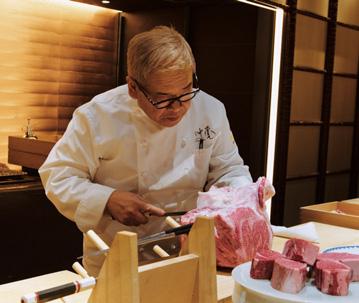
care principle is allowing the cattle extra time to develop, often exceeding the general 24-month cycle typically found in Western beef production. This slow and patient approach ensures a flavourful, silky texture, with marbling that shows up not just around the edges but throughout the muscle fibres. Whether you’re talking about Kobe, Matsusaka, or any other regional label, the emphasis on genetics, slow feeding and calm environments remains constant throughout. One crucial detail that is rarely discussed outside specialised circles is the rising preference for female cattle, especially heifers that have never given birth. Historically, most high-end Wagyu was sourced from castrated males, which grow larger and display more visible ribbons of pearly white fat. However, in the last decade, many producers have discovered that heifers raised beyond 45 or 50 months (with Boss they reach up to 54 months) develop deeper flavour and marbling that begins to liquefy at body temperature. Boss believes that
even though these older female cows produce smaller yields, the payoff is worth it. “They’re smaller,” he says, “but the flavour runs deeper. Every time I carve a piece from a top-grade female cow, I’m reminded why we commit to this extra time and care.”
Wagyu diets typically include grains, hay and sometimes local ingredients such as rice straw and, sometimes, even beer. Wagyu farmers strive to keep the cattle on a stress-free schedule, ensuring a consistent appetite and steady fat development. Boss reviews each farm’s feeding logs to confirm a gentle progression without abrupt changes that might disrupt the cow’s metabolism. Because the cows mature longer, many butchers and chefs feel they do not need prolonged aging after slaughter. In Boss’s words: “the cow has already done the work,” meaning that the extended rearing period naturally enriches the meat’s flavour.
During a meal at Nikuya Tanaka, one sees and tastes Wagyu in many different forms. Boss welcomes questions about everything from the cattle’s breed to the farm’s location and feeding methods. A quick sear on the grill is often all it takes for these delicate fat layers to soften, leaving a subtle sweetness that coats your tongue. It’s not just about a prime cut of beef; it’s about understanding how genetics, diet and careful butchery come together to create a thoughtful experience, reflecting the meticulous care of Japanese craftsmanship. It’s all in the details. Whether it’s Kobe’s global name recognition or Matsusaka’s patiently aged female cows, the goal remains the same: nurture every cow until its marbling and flavour reach their peak. Boss’s dual role as both butcher and chef shows how each small decision shows respect for the careful process that makes every bite memorable.








In a century-old Tokyo townhouse, soba becomes a meditative ritual –pure buckwheat, handmade daily, revealing Japan’s quiet culinary poetry
Writing & Photography by Leen Al Zaben
Soba, or buckwheat noodles, holds a special place in Japanese cuisine and is a reflection of Japan’s unmatched talent for turning simple ingredients into something thoughtful, nourishing and special. At its simplest, soba is ground buckwheat flour mixed with water and briefly boiled. Yet, it inspires a deep affection across Japan. “Soba” translates to “buckwheat”, but people generally use it to mean the noodles themselves. In Tokyo alone, there are over 4,000 soba shops, a testament to how deeply this simple dish has woven itself into daily life. Historically grown in mountainous regions unsuited for rice cultivation, buckwheat found its earliest homes in places like Nagano. Early farmers prized buckwheat for its resilience: it matures quickly, withstands harsh climates and grows where other grains can’t. Over time, cooks discovered that buckwheat flour mixed with water could become noodles with a nutty taste and pleasant chew. Over generations, soba moved into bustling Edo (modern-day Tokyo), becoming a staple of urban life and one of the main pillars of Edo cuisine. Each generation has preserved and refined this centuries-old tradition, turning a simple grain into something truly extraordinary.
By the Edo period (1603–1868), soba had become central to urban dining, served at street stalls and refined restaurants alike. Appreciated for balanced flavours and fast preparation, soba also integrated itself into cultural traditions, such as toshikoshi soba, noodles eaten on New Year’s Eve to symbolise longevity and renewal.
Even though many perceive soba as uniform (I was guilty of this, too, up until recently), many variations of this noodle exist. Ni-hachi soba, buckwheat noodles blended with wheat flour, balances buckwheat’s distinct aroma with wheat’s elasticity, making it easier for beginners to handle. This particular mix is what one would generally find in most soba shops today. In contrast, j wari soba, which is made with 100 per cent
buckwheat, offers the grain’s flavour in its purest form: slightly sweet, earthy, yet fragile. Coarser styles such as arabiki include bran for robust taste, while others retain husks for deeper colour and fragrance. Served cold with dipping sauce or hot in broth, soba’s gentle nuttiness, delicate chew and comforting warmth remain constant.
In Tokyo, among countless soba shops, chef Kenji Osame stands out. His restaurant, Soba Osame, is nestled inside a carefully restored 100-year-old wooden house in one of the quiet neighbourhoods of Tokyo’s Shinjuku ward. Guests walk a short stone path, remove shoes in a quiet foyer and sit at low tables overlooking a small zen garden. Removed from the city’s rush, one naturally feels inclined to slow down and savour each bite.
Kenji learned early from his father, a restaurant owner, how details shape cooking. A formative experience with Togakushi soba in Nagano deepened his appreciation for soba’s depth, inspiring him to specialise in handmade soba, known as teuchi soba. He gradually mastered kneading and cutting dough by hand, exploring heirloom buckwheat varieties from farms across Japan. Each grain, he discovered, had subtle differences in taste and texture.
Kenji gravitated toward j wari soba (100 per cent buckwheat) despite its challenges. Without gluten from wheat, j wari dough easily tears or cracks if handled incorrectly. Precise water ratios adjusted to daily changes in humidity are crucial, and Kenji does just that on a daily basis – a subtle dance to balance the pliability and texture of his dough. Believing only pure buckwheat revealed the grain’s true character, Kenji embraced these challenges. He sources fresh buckwheat seeds from Akita, Tottori and other regions, milling them daily to preserve natural oils and aroma, sometimes choosing finer or coarser grinds based on the grain’s seasonal qualities.
Kenji’s mindful approach is clearest in his rinsing technique. Traditionally, noodles are quickly cooled under running water to stop the
cooking process and remove excess starch. Kenji noticed aggressive rinsing made delicate j wari noodles bland or chalky. He developed a minimal rinsing method, gently cooling noodles just enough to maintain their structure while leaving a subtle warmth and sweetness from residual starch. This delicate balance requires precise timing, cooking small batches and tasting constantly to ensure perfect texture and flavour.
When I visit Soba Osame, my perspective on soba shifts completely. Until then, I had only experienced ni-hachi soba – buckwheat noodles blended with wheat flour, but tasting j wari soba, made entirely from buckwheat, reveals a whole new dimension to me. The differences in flavour are nuanced, the mouthfeel strikingly distinct. Meals at Osame unfold slowly, each course offering a different expression of soba. It begins with arabiki sobagaki, a warm, textured buckwheat dumpling, followed by a selection of seasonal appetisers. Then comes a tender, sweet-savoury tamagoyaki. Next, two styles of soba are served side by side: arabiki, made with coarsely milled buckwheat for a bold, rustic profile, and genbiki, stone-ground for a smoother texture and more delicate flavour. The final course is kamo nanban soba, served in a clear, hot broth and topped with slices of duck and green onions. We end the meal by mixing sobayu, the milky cooking water, into leftover dipping sauce, creating a simple, comforting soup that captures buckwheat’s final essence. The meal is a quiet and thoughtful journey, each moment revealing a new dimension of soba’s understated elegance. Despite thoughtful innovations, Kenji remains rooted in soba’s traditions. He preserves time-honoured methods such as fresh milling and handmade dough, while also embracing evolution through the use of heirloom grains and subtle adjustments that highlight buckwheat’s purity. His approach captures the essence of Japanese soba culture: quick enough for a commuter’s lunch, yet deep enough for a reflective and unforgettable meal.
Don’t discard leftover spring onions, radish, turnips and red chillies. Instead use them to make fried rice, pickled veggies and a fi ery chilli paste

Add rotisserie chicken from our Spinneys deli to increase the protein content of this meal.
Prep time: 10 minutes
Cook time: 20 minutes
Serves: 2
For the fried rice
250g kimchi
2 Spinneysfood Spring Onions
1 tsp Spinneysfood Pure Sunflower Oil
4 tbsp Spinneysfood Bottled Drinking Water
2 tbsp gochujang
600g cooked rice from Spinneys deli
For the crispy fried egg
2 tbsp Spinneysfood Pure Sunflower Oil
2 large Spinneysfood Organic Free-Range Eggs
To serve
1 tbsp toasted sesame oil
1 nori sheet
2 tsp Spinneysfood White Sesame Seeds
1 Strain the kimchi and reserve 4 tablespoons of the liquid. Chop the kimchi into bite-sized pieces.
2 Finely slice the spring onions, keeping the greens separate. 3 Heat the oil in a large wok over a medium heat. Add the kimchi and white parts of the spring onion. Stir-fry for approx. 2-3 minutes until tender and slightly caramelised. Pour the reserved kimchi liquid and water into the pan and stir in the gochujang. Simmer until slightly thickened, approx 2-3 minutes. Add the cooked rice and toss everything together, ensuring the rice is evenly coated in the sauce. Pat down the rice into an even layer and fry for approx. 5 minutes to create a crispy layer at the bottom.
4 To make the crispy eggs, heat the oil in a medium-sized non-stick pan over a high heat. Just before it reaches the smoking point, crack in the eggs. Bubbles will begin to form around the edges. Fry for approx.1-2 minutes until the bottom is golden but the yolk is soft. Drizzle the sesame oil over the fried rice before removing it from the heat. 5 Divide the rice mixture between two bowls and top each with a crispy fried egg. Finely slice the nori sheet. Scatter the spring onion greens, sesame seeds and shredded nori over the top and serve.
Make sure to maintain the wet sand consistency by adding more bran and salt as needed. If you are not pickling any vegetables, store the prepared oat bran in the fridge until needed.

These lightly fermented pickles are a simplified take on traditional nukazuke, using oat bran instead of rice bran. Enjoy them as part of a Kyoto-style breakfast or as a flavourful side dish.
Prep time: 10 minutes (plus fermentation time)
Cook time: 5 minutes
Serves: 4
For the pickling mixture
1 nori sheet
500g oat bran
500ml Spinneysfood Bottled Drinking Water
2 tbsp white miso
60g Spinneysfood Fine Sea Salt
1 tsp Spinneysfood Fine Ginger
For the vegetables 4-6 radishes 4-6 turnips
1 Place the nori in a blender and blitz to form a powder. 2 Heat a large wok over a medium heat. Blend the oat bran into a fine powder and sieve to remove any large pieces of bran. Dry-roast the oat bran for approx. 3-5 minutes until lightly toasted. Transfer to a flat baking tray and allow to cool completely. 3 Bring the water, miso and salt to a boil in a medium-sized pot over a high heat. Stir until the salt has completely dissolved. Remove from the heat and set aside to cool down to room temperature. 4 Add of the oat bran into the water, stirring constantly. Once it forms a thick paste, add in the remaining oat bran and mix well – it should have the consistency of wet sand. Stir in the ground nori and fine ginger. Transfer the mixture into a large container with a lid. Cover and let it sit at room temperature for 24 hours to develop its natural fermentation before adding vegetables. 5 Leave the radishes and baby turnips whole or halve them if they









are large. To start the fermentation process, push approx. 6-8 pieces of radishes and turnips into the oat bran mixture. Ensure they are all fully covered by the oat bran mixture and the top is smoothed over. Seal the container and store it in a dark place with a temperature of 20°C-25°C. 6 The first batch of vegetables are ready to consume after 24 hours. The oat bran mixture can be used for 12-14 days. Stir it once a day to distribute the bacteria evenly – add washed and dried root veggies to it every day to ferment for 24 hours or longer, if required. Radishes take 24 hours to ferment whereas larger vegetables such as turnips or beetroots may take 2-4 days. The longer you keep them submerged, the saltier they will be. 7 Once fermented, remove the vegetables and rinse well under cold water before slicing and serving. The vegetables will have a crunchy texture and a salty, earthy flavour. Store in an airtight container in the fridge for up to 3 months.
Prep time: 20 minutes (plus fermentation time)
Makes: 250ml
250g fresh red chillies
25g fresh ginger
5 garlic cloves
90ml Sea Arch Coastal Juniper Non-Alcoholic
Distilled Botanicals
1 tbsp Spinneysfood Fine Sea Salt
1 tsp Spinneysfood Fine Grain White Sugar




1 Remove the stems of the chillies and thoroughly wash them. Allow to dry in the sun for 6 hours to remove any excess moisture and concentrate the flavour. Remove half of the seeds, if you prefer a milder flavour. 2 Peel and roughly chop the ginger and garlic. 3 Add the chillies, ginger and garlic to a food processor and pulse until coarse. Make sure to keep some texture to avoid over-processing. Transfer the chilli mixture to a large bowl and stir in the non-alcoholic gin, salt and sugar until well combined. If you don’t have zero-alc gin, a 1:1 ratio of rice vinegar and water can be used as a substitute. 4 Spoon the mixture into a sterilised 300ml jar, pressing it down gently to eliminate air pockets. Fill a small zip-top with water and seal it. Gently place it into the jar, on top of the chilli mixture to create a seal to stop bad bacteria from spoiling. Seal tightly with the lid and store in a dark place at room temperature to ferment. You will need to open the jar once a day to release pressure buildup. After 10-15 days, it should have a tangy aroma and vibrant red colour. Remove the zip-top bag and seal the jar with its lid. 5 Use the fermented chilli sauce as a dipping sauce, a seasoning for stir-fries, or a condiment for noodles and grilled meats. Once fermented, store in the refrigerator for up to 6 months.




For alternative Filipino cuisne IN THE KUSINA: MY SEASONAL FILIPINO COOKING by Woldy Reyes Owner-operator of a boutique catering company in Brooklyn, New York, Woldy Reyes clearly knows his native Filipino cooking. But there’s something radical about his approach: doing away with meat and seafood almost completely. His Filipino spaghetti, for example, relies on burst cherry tomatoes and swaps out the fermented seafood paste (bagoong) at the core of that recipe for a veggie alternative with mushroom powder and coconut jam.
For the love of whimsical dishes
MY NEIGHBOR TOTORO: THE OFFICIAL COOKBOOK by Studio Ghibli
Japanese master animator Hayao Miyazaki, of the movie workshop Studio Ghibli, is beloved as much for the quiet domestic moments in his films as for their wild flights of fancy. Though filled with trolls and woodland sprites, his 1988 classic My Neighbor Totoro also takes time for many scenes of old-fashioned rustic cooking. The recipes on display, and others inspired by the movie – from Granny’s Ohagi to Soot Gremlin Donuts – are now complied in this beautiful official volume.
For the lover of fragrant Asian meals SAOY: ROYAL CAMBODIAN HOME CUISINE by Chef Nak Chef Nak has done more to promote authentic Cambodian food than any other advocate of modern times. Named Best Cookbook In the World at 2024’s prestigious Gourmet Awards, this handsome volume deploys solid kitchen sense with a keen eye for aesthetics and a certain storytelling flair, putting each dish in thoughtful cultural context. Some recipes have an aristocratic air that befits favourites of the Khmer royal household, but the grass roots are not forgotten in these gorgeous pages.

Malaysia-based host Jun Yi Loh presents this winningly curious-minded podcast on Asian foods and beverages, ranging across the Far East and its manifold gastronomic domains. Leading the listener to rice fields, tea plantations and fruit farms, she’s got a deep interest in the processes behind a given product, while her guest roster draws on the expertise of chefs, agronomists and anthropologists as well as chefs and food writers.
junandtonic.com/takeabao

It’s bingeable enough with quick, short 15-minute episodes, but this survey of authentic Chinese cooking is not remotely superficial, and often more like a documentary travelogue than a simple resource for recipes. Each of its three seasons so far has covered a different geographic region (Chaoshan, Yunnan, Gansu) and each part has its own culinary focus, from gluten to mutton to tofu cake. The viewer learns a huge amount of new information and ideas with every densely packed deep-dive into a food culture that many just assume they know. Available on Netflix.









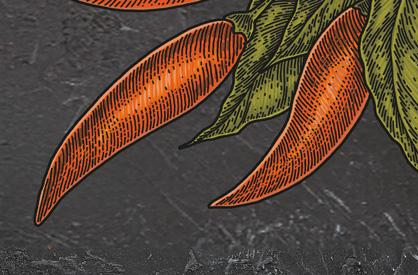








































































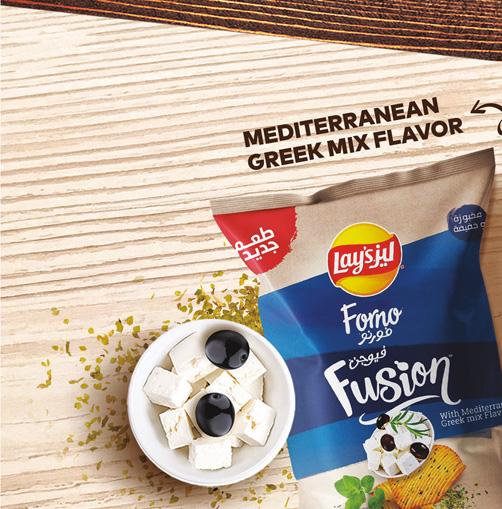








Our seasonal highlights include mangoes, rhubarb, lotus root, strawberries and durian




THAI CORN FRITTERS WITH SWEET CHILLI MANGO SAUCE
These Thai-style corn fritters combine the crispy-chewy texture of the corn with the sweet-spicy flavour of the mango salsa resulting in an addictive snack.
Prep time: 20 minutes
Cook time: 15 minutes
Serves: 4
For the mango salsa
½ ripe Mahachanok mango
½ red chilli
½ small red onion
Handful of Spinneysfood Fresh Coriander
1 lime
½ tsp Spinneysfood Fine Sea Salt
For the sweet chilli mango sauce
½ ripe mango
1 lime
125ml sweet chilli sauce
½ tsp fish sauce
For the fritters
400g corn kernels (from 4 ears of corn)
2 Spinneysfood Spring Onions
2 kaffir lime leaves
2 tsp chilli paste, or more to taste

1 large Spinneysfood Organic Free-Range Egg
50g Spinneysfood All-Purpose Flour
50g rice flour
1 tbsp corn flour
½ tsp Spinneysfood Fine Sea Salt
¼ tsp Spinneysfood Ground White Pepper
½ tsp Spinneysfood Baking Powder
100ml tonic water, chilled
2L Spinneysfood Pure Sunflower Oil, for frying
1 To make the mango salsa, finely dice the mango, red chilli and red onion to roughly the same size. Finely chop the coriander. Add all the ingredients to a bowl. Juice the lime over the salsa and season with salt before tossing to combine. Refrigerate until ready to serve. 2 To make the mango sauce, peel and dice the mango and juice the lime. Place the mango and lime juice in a blender and blitz until smooth. Transfer the mango purée to a bowl and stir in the sweet chilli sauce and fish sauce. 3 Cut the corn kernels off the cobs. Finely slice the spring onions and kaffir lime leaves. Place the kernels, spring onions and lime leaves in a mixing bowl and stir in the chilli paste and egg. In a separate bowl, whisk together the three flours, salt, pepper and baking powder. Gradually add the dry ingredients to the corn mixture, stirring gently. Slowly pour in the chilled tonic or sparkling water, mixing until a thick batter forms, and the corn is evenly coated. 4 Heat the oil to 180°C in a deep pan. Line a tray with a wire rack and paper towels
for draining the fritters. 5 Using a large spoon or ice cream scoop, carefully drop spoonfuls of the batter into the hot oil. Fry for 1-2 minutes per side, flipping once, until golden brown and crispy. Remove with a slotted spoon and transfer to the rack to drain. Repeat with the remaining batter. 6 Serve the corn fritters while hot with the sweet chilli mango sauce and mango salsa on the side.
ROASTED RHUBARB WITH SICHUAN PEPPER DUCK
This dish combines the rich, aromatic flavours of Sichuan-spiced duck with the tart sweetness of roasted rhubarb. The duck is infused with a fragrant five-spice and Sichuan pepper rub, then glazed with a sweet-savoury mixture.
Prep time: 30 minutes
Cook time: 30 minutes
Serves: 4
For the duck
4 duck legs
2 tsp Sichuan peppercorns
1 tsp Spinneysfood Fine Sea Salt
2 tsp five-spice powder
2 tbsp Spinneysfood Organic Natural Honey

Cook time: 10 minutes
Makes: 500ml
1 piece kombu
10g bonito flakes
500ml Spinneysfood Bottled Drinking Water
1 Combine all the ingredients in a medium-sized pot and warm over a medium heat. Simmer gently for 10 minutes, then remove from the heat and allow it to infuse until completely cool. 2 Strain through a fine-mesh sieve and use immediately, or refrigerate for up to two days.


If the mochi dough is too soft and difficult to handle, let it sit for a few minutes to firm up slightly before shaping.



2 tbsp soya sauce
2 tbsp rice vinegar
For the roasted rhubarb
500g rhubarb
1 orange
1 tbsp Spinneysfood Light Muscovado Sugar
1 Preheat oven to 180°C, gas mark 4. 2 Lightly score the duck legs then set aside. 3 Toast the Sichuan peppercorns in a dry pan. Transfer to a pestle and mortar and crush the peppercorns. In a small bowl, mix the peppercorns, salt and five-spice powder to form a dry rub. Spread the rub evenly over the duck legs. Place the duck legs, skin-side down, in a cold pan over a medium heat and cook for 8-10 minutes until the fat has rendered and is golden. 4 Trim the ends of the rhubarb and place in a large baking dish. Zest and juice the orange. Sprinkle the sugar over the rhubarb followed by the zest and juice. Toss everything together. Roast the rhubarb for 8 minutes until tender but still holds shape.
5 Mix the honey, soya sauce and rice vinegar together to make the glaze. Brush it over the duck legs before transferring them to the baking dish containing the rhubarb. Pour the remaining glaze into the pan. Return the dish to the oven for 6-8 minutes for medium-rare or longer for well done.
6 Rest the duck legs for 5 minutes before serving.
Lotus root is the edible rhizome of the lotus plant, known for its crunchy texture and mild, slightly sweet flavour. It has a distinctive appearance with a lace-like pattern of holes running through each slice. Commonly used in Asian cuisine, lotus root can be enjoyed raw, stir-fried, braised, or deep-fried.
Prep time: 15 minutes
Cook time: 15 minutes
Serves: 4
For the lotus root
250g lotus root
1 tbsp rice vinegar
2L Spinneysfood Pure Sunflower Oil
30g Spinneysfood All-Purpose Flour
For the dipping sauce
4 tbsp dashi stock (see page 30)
2 tbsp soya sauce
2 tbsp rice vinegar
1 tsp Spinneysfood Extra Fine Caster Sugar
For the tempura batter
100g Welna Tempura Batter Mix
180ml Spinneysfood Bottled Drinking Water
To serve
1 tsp togarashi
Spinneysfood Fine Sea Salt, to taste
1 Peel the lotus root and slice it into thin rounds, approx. ½cm thick. Place the slices in a bowl of cold water with rice vinegar to prevent discolouration. 2 To make the dipping sauce, combine the ingredients and stir until the sugar dissolves. 3 In a mixing bowl, whisk the tempura batter mix with water until just combined; small lumps in the batter are fine. 4 Heat the oil to 180°C in a deep fryer or a deep pan. Line a tray with a wire rack and paper towels for draining. 5 Drain and pat the lotus root slices dry before tossing in some flour to help the batter adhere. Dip each slice into the batter, allowing excess to drip off, then carefully lower into the hot oil. Fry in batches for 1-2 minutes per side until lightly golden and crisp. Remove with a slotted spoon and drain on a wire rack. 6 While the fried lotus root is hot, sprinkle over the togarashi and salt. 7 Serve immediately with the dipping sauce.
Daifuku, or daifuku mochi, is a classic Japanese wagashi (traditional sweet) that symbolises good fortune. This sweet consists of soft, chewy mochi (glutinous rice cake) wrapped around a sweet filling, traditionally anko, which is a smooth red bean paste. We’ve added our delicious Scottish strawberries in the centres of these little confections.
Prep time: 40 minutes
Cook time: 5 minutes
Makes: 10-12
For the red bean paste
200g Spinneysfood Red Kidney Beans
80ml Spinneysfood Bottled Drinking Water
2 tbsp Spinneysfood Fine Grain White Sugar
2 tbsp Spinneysfood Dark Muscovado Sugar
80g Spinneysfood Salted Butter
For the mochi dough
100g glutinous rice flour
2 tbsp corn flour, plus extra for rolling
2 tbsp Spinneysfood Extra Fine Caster Sugar
180ml Spinneysfood Bottled Drinking Water
¼ tsp pink food colouring
10-12 Spinneysfood Scottish Strawberries
1 To make the red bean paste, drain the beans and add them to a blender along with water, both sugars and butter. Blitz on high until smooth, adding a little more water, if needed. Transfer to a non-stick pan and cook over a medium-high heat, stirring consistently, until thickened. It should be firm enough to hold its shape. Remove from the heat and allow to cool. Refrigerate for at least 30 minutes to firm up, then roll into 35g balls. 2 In a microwavable bowl, whisk together the rice flour, corn flour and sugar. Gradually whisk in the water and food colouring until you have a smooth mixture.
Place a large flat plate on top of the bowl to seal it. Microwave the mixture for 1 minute before removing the plate and stirring it with a silicone spatula. Microwave for a further 2 minutes, stirring again after 30-second intervals. Set aside to cool completely. 3 Hull the strawberries. 4 Flatten a ball of bean paste and shape it evenly around the strawberry. Repeat the process with the remaining strawberries and bean paste. Set them aside for later. 5 Once the mochi dough has cooled, sprinkle some corn flour on a clean surface. Transfer the dough to the same surface and knead until it becomes pliable and stretchy. Roll it out until it is flat, approx. 5mm thick. Using a circular cutter, cut out 8-10 equal circles. Place the circle in a small bowl or in the palm of your hand to help shape the mochi. Place a bean paste-covered strawberry in the centre and pull the edges closed to wrap tightly. Tip it out of the bowl. Pinch to seal shut and lightly toss it between your hands to remove excess flour. Place seam-side down in a paper cupcake liner. Repeat with the remaining pieces of mochi dough and bean paste-covered strawberries.
6 Serve immediately or store in an airtight container in the refrigerator for up to 2 days. Heat in the microwave for 30 seconds to revive the chewiness.
Fragrant lemongrass and an acidic kick of lime help cut the rich sweetness of these popsicles. If you prefer, the ice cream can also be set in a lined loaf tin and scooped out once it’s frozen.
Prep time: 10 minutes (plus freezing time)
Makes: 12
300g durian flesh (fresh or frozen, seed removed)
1 x 397g tin sweetened condensed milk
1 tsp vanilla extract
¼ tsp Spinneysfood Fine Sea Salt
500ml double cream
3 lemongrass sticks
1 lime
1 In a blender or food processor, blitz the durian flesh, condensed milk, vanilla extract and salt until smooth. Set aside. 2 Place the double cream in a large mixing bowl. Using an electric hand mixer or stand mixer, whip the cream on medium-high speed until stiff peaks form, approx. 3-4 minutes. Add the cream to the durian mixture and blend until just combined. 3 Using a sharp knife, quarter the lemongrass sticks and thinly slice the lime. Place a lime slice and lemongrass stick inside each popsicle mould. Fill the mould with the durian ice cream mixture. 4 Freeze for at least 6 hours or overnight until firm. 5 Release the popsicles by quickly dipping each mould in hot water for a few seconds.
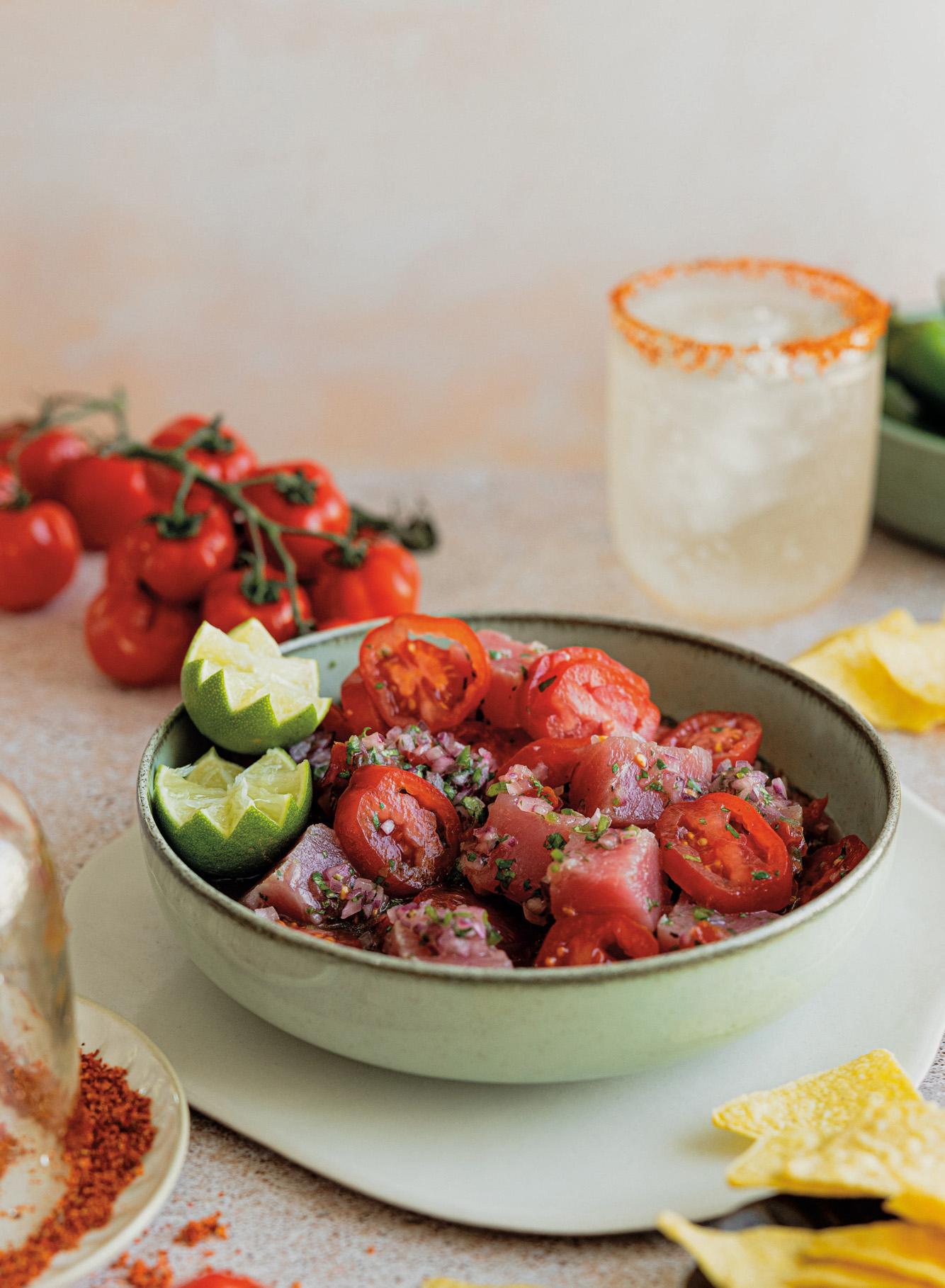
We work closely with the Isle of Wight company in the UK to bring in an array of premium-quality tomatoes that surpass other varietals in terms of appearance, fl avour and texture

This tomato ceviche highlights the distinct umami flavour of Piccabelle tomatoes with a zesty-spicy dressing.
Prep time: 15 minutes
Serves: 4
For the ceviche
1 small red onion
1 jalapeño
250g Isle of Wight Piccabelle Tomatoes
300g fresh tuna loin
For the dressing
2 limes
Handful of Spinneysfood Fresh Coriander
1 tbsp Spinneysfood Fine Grain White Sugar
2 tbsp Spinneysfood Mediterranean Extra Virgin Olive Oil
Spinneysfood Fine Sea Salt, to taste
Spinneysfood Black Pepper, freshly ground, to taste
To serve
125g Spinneysfood Salted Organic Tortilla Chips
1 Finely dice the red onion. Halve and finely dice the jalapeño (remove the seeds for a milder flavour). Finely dice half the tomatoes, reserving the rest for serving. 2 Cut the fresh tuna into evenly sized cubes (approx. 1½cm). 3 Zest and juice the limes. Finely chop the coriander.

In a small bowl, whisk together the lime zest and juice, coriander, sugar, olive oil, salt and pepper until well combined. 4 In a large mixing bowl, combine the diced onion, jalapeño and diced tomatoes. Add the cubed tuna and gently toss. Pour the lime dressing over the mixture and toss gently to ensure everything is evenly coated.
5 Thinly slice the remaining tomatoes and gently fold them into the ceviche. 6 Serve immediately with the tortilla chips.
The sweet and tangy flavour of Isle of Wight Mini San Marzano Tomatoes pairs well with earthy figs and briny green olives. This is perfect for a light appetiser, or as an addition to any summer spread.
Prep time: 15 minutes
Cook time: 5 minutes
Serves: 4
For the bruschetta
1 Spinneysfood Sourdough Loaf
1 garlic clove
250g Isle of Wight Mini San Marzano Tomatoes
100g Spinneysfood Pitted Green Queen Olives
Handful of Spinneysfood Fresh Basil
Spinneysfood Fine Sea Salt, to taste
Spinneysfood Black Pepper, freshly ground, to taste
6 fresh figs
To serve
3 tbsp Spinneysfood Mediterranean Extra Virgin Olive Oil
Handful of Spinneysfood Fresh Basil
1 Preheat the oven to grill, 200°C, gas mark 6.
2 Slice the sourdough loaf into 1cm-thick slices. Arrange the sourdough slices on a baking tray and grill for 5-6 minutes, turning once, until golden and toasted. 3 Peel the garlic clove and rub it gently over one side of each toasted slice. 4 Quarter the mini San Marzano tomatoes and the green olives. Finely slice the basil. In a mixing bowl, gently combine the tomatoes, olives and basil. Season with salt and pepper. Slice the figs into thin rounds. Place 4-5 slices of fig on each toasted sourdough slice. Spoon the tomato and olive mixture evenly over the figs. 5 Arrange the bruschetta on a serving plate. Drizzle generously with olive oil. Scatter over the fresh basil leaves and serve immediately.
This salad combines juicy Isle of Wight Cherry Tomatoes with plump ripe peaches and creamy Spinneysfood Ricotta, which are all brought together with a balsamic vinaigrette.
Prep time: 15 minutes
Serves: 4 VEGGIE

For the salad
200g Isle of Wight Cherry Tomatoes on the Vine
3 ripe peaches
100g Spinneysfood Ricotta
Handful of Spinneysfood Fresh Dill
For the dressing
1 garlic clove
1 tsp Dijon mustard
2 tbsp Spinneysfood Balsamic Vinegar of Modena
3 tbsp Spinneysfood Mediterranean Extra Virgin Olive Oil
Spinneysfood Fine Sea Salt, to taste
Spinneysfood Black Pepper, freshly ground
1 Slice the cherry tomatoes in half. Chop the peaches into wedges. 2 To make the dressing, mince the garlic. In a small bowl, whisk together the minced garlic, Dijon mustard, balsamic vinegar, olive oil, salt and pepper until emulsified. 3 Place the halved cherry tomatoes and peach wedges in a large mixing bowl. Drizzle with the vinaigrette and gently toss to coat evenly. 4 Dollop spoonfuls of ricotta cheese on a serving platter and spread each slightly with the back of a spoon. Arrange the dressed tomatoes and peaches over the ricotta.
5 Pick the dill leaves from their stems and scatter them over the salad. 6 Serve immediately as a refreshing summer dish.
Cherry tomato and peach salad with balsamic vinaigrette
Prep time: 15 minutes
Cook time: 25 minutes
Serves: 4
For the salmon
2 fresh salmon fillets
1 tbsp Spinneysfood Mediterranean Extra Virgin Olive Oil
Spinneysfood Fine Sea Salt, to taste
Spinneysfood Black Pepper, freshly ground, to taste
For the salad
1 tbsp Spinneysfood White Sesame Seeds
1 nori sheet
50g Spinneysfood Corn Salad Leaves
2 Isle of Wight Golden Coeur de Boeuf Tomatoes
2 Isle of Wight Marbruni Tomatoes
For the dressing
2 tbsp sesame oil
2 tbsp rice vinegar
1 tsp Spinneysfood Acacia Honey
2 tsp soya sauce
1 Preheat the oven to 180°C, gas mark 4. Line a baking tray with parchment paper.

2 Pat the salmon skin dry with a paper towel. Using a sharp knife or your fingers, carefully remove the skin from the salmon fillets. Lay the skin flat on the lined baking tray and place an empty loaf tin on top of the skins to weigh them down, this will ensure they don’t curl up while cooking. Bake in the oven for approx. 15 minutes, until crispy and golden. Set aside to cool. 3 Drizzle the salmon fillets with olive oil and season lightly with salt and pepper. Place the fillets on a baking tray and roast in the oven for approx. 20 minutes, or until cooked to your liking. Allow to cool slightly before flaking into bite-sized pieces. 4 Toast the sesame seeds in a dry pan over a medium heat until golden and fragrant. Crumble the nori sheet into small flakes and mix with the toasted sesame seeds in a small bowl. Set aside. 5 In a small bowl, whisk together the sesame oil, rice vinegar, honey, soya sauce, salt and pepper until emulsified. 6 Place the corn salad leaves in a large serving bowl or on a platter. Slice the Golden Coeur de Boeuf and Marbruni tomatoes into 1cm-thick slices and arrange them over the corn salad. Scatter the flaked salmon over the tomatoes. Drizzle the dressing evenly over the salad. Break the crispy salmon skin into croutons and scatter over the salad. Sprinkle the nori-sesame mixture over the top. 7 Serve immediately.
Mixed tomato salad with salmon skin croutons and nori sprinkle

Lay the salmon fillets flat on a board, skin side down and run a knife along the skin to remove it easily.














Journey to Vietnam and Thailand to meet our partners who provide us with a variety of exotic fruit



Jackfruit, dragon fruit, pink pomelo…Spinneys sources premium Vietnamese fresh produce through The Fruit Republic. On a visit to the Mekong Delta and beyond, we learn how the company is investing and innovating in that country’s extraordinary agriculture

Vietnam might be the most vividly colourful country in the world. The luminous white ao dai dresses worn by schoolgirls on bikes; the glinting gold of temple stupas; the searing reds and yellows of housefronts and market stalls; the rich, deep greens of the rice fields – taken together, the country seems to repose in its own eye-popping spectrum.
There’s a lot of fresh produce mixed into that palette, too, and Spinneys buys a great deal of it from The Fruit Republic: pink and white pomelos, white and red dragon fruit, limes, papaya, jackfruit – all grown, harvested and shipped by skilled workers wearing the company’s distinctive orange shirts. That particular colour was chosen to honour the Dutch origins of company founder, owner and managing director Siebe Van Wijk. And though Siebe is of Netherlandic stock, he was born and raised in Kenya.
“From a young age I knew I wanted to be in tropical agriculture,” he says today, standing at the edge of a dragon fruit farm in Long An Province – one of the most important and abundant production areas in Vietnam for that fruit. The farm itself is owned by one of 30 smallholders who form a cooperative that supplies Fruit Republic with premium-quality red and white-fleshed dragon fruit, thereby fulfilling Siebe’s very purpose in moving to Vietnam with his wife and creating the company more than 20 years ago.
“When I first came here, I just loved the people, they’re so energetic and optimistic. Our dream was to help smallholder farmers because we saw there was a lot of entrepreneurship and a real openness to new technology,” he says. Their initial consultancy was geared toward research and development for produce that included seafood, potatoes, chicken and corn.
“But nobody seemed interested in fruit at the time and when I first tried a Vietnamese pomelo it was one of the















nicest fruits I’d ever eaten. I thought, ‘this deserves to come onto the world market’. So, we started The Fruit Republic to develop exports out of Vietnam, while also catering to the domestic market, and the company grew from there.”
Two decades later, one of many new developments – and specific to Spinneys – is a shift from air freight to a two-week shipping programme that allows a panopoly of different fruits to be delivered in the same container. “So, every week, Spinneys will get a fresh arrival with yellow- and pink-flesh pomelo, loose and prepacked limes, young drinking coconuts, pineapples and all the dragon fruit colours,” says Siebe. The latter is widely consumed across Asia, and especially in China, but to many foreign shoppers it’s still relatively unfamiliar.
“Dragon fruit is a kind of superfood, with a lot of nutrients you don’t get in other fruits” says Siebe. “Lots of potassium, a bit like a banana, which has anti-aging effects. The red-flesh variety is a bit more sweet than the white, but they’re both quite fresh in taste, especially out of the fridge and very good in smoothies and fruit salads.”
Orange jackfruit has been another recent revelation for many international consumers, joining red dragon fruit in Spinneys’ new premium range, Discovery. Very few people buy them whole, explains Siebe, “because it’s a huge fruit and a lot of work to peel and cut yourself”. “So, we’ve developed a Freshcut range, starting with yellow jackfruit. If you’re trying it for the first time, yellow is best for the beginner and if you get addicted then you move on to the orange one, which is for real jackfruit lovers. Much stronger in taste and very sweet.”
This ongoing boom in Vietnamese fruit has grown out of major changes made not so long ago, says Siebe. Economic development only really began in this country in the mid-1990s. At that time, most agricultural workers
COMING SOON

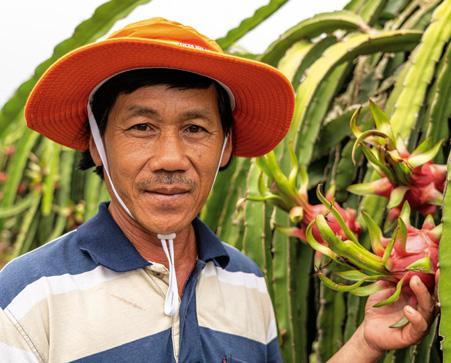
were rice farmers, and a widespread transition to fruit is still underway, with the active assistance of his company.
To illustrate, he shows the Spinneys team around a lime farm on wet and fertile lands between Can Tho and Ho Chi Minh City that’s affiliated to The Fruit Republic. “There’s all this talent and energy in Vietnam, but a lot of things to be improved. Here in the Mekong Delta you’ve got 500,000 smallholder families now depending on fruit for their income, so what we do is help with production.” This site appears to be a beautiful working model of agricultural practice in the delta, with limes being transported by boat on narrow canals that run alongside the fields.
Initially, says Siebe, those new to this form of farming assumed planting the most possible trees would mean greater yields and bigger incomes. He explains, “But too many trees start competing for light and the branches grow up, not out, so you’ve got something more like a fruit forest than a farm. Now the spacing is good here, and our extension team is helping with these practices that ensure you grow more fruit from fewer trees.” The Fruit Republic consults with the farmers on growing without herbicides by covering their lands with grasses and composting from nutrient-rich rice husks that they used to burn in the old days. The company has also established one of the country’s first professional plant nurseries and introduced new root stocks to broaden and strengthen the limited native varieties, bolstering resistance to saltwater and certain diseases.
Soil analysis is still a brand new technology in Vietnam and Siebe’s production specialists can now offer their farmers a laboratory sampling service that gives them a solid basis for “site-specific fertiliser programmes”, thus minimising chemical inputs across each crop. The Fruit Republic’s

Farm Academy, meanwhile, is training smallholders – often husband-and-wife operations – to professionalise their business in line with the highest agricultural standards.
More experienced fruit farmers from overseas have relocated here to show them how it’s done. Jacques Van Zyl, for example, had been cultivating citrus in his native South Africa before moving to here as a production manager for The Fruit Republic, deploying his expertise on pomelos in particular. “Vietnam has a lot of fertile soil, clean water and the climate to cope with these citrus types,” says Jacques. “But pink pomelo is still a very difficult fruit to set, and I like a challenge.” Soil sampling, spray protocols and “a lot of pruning techniques” that he brought from South Africa seem to have worked a treat in this environment, and he believes the fruit is well worth those efforts. “It’s just the best tasting pomelo, sweet and very juicy,” he says. “I would choose the Vietnamese pink pomelo before any others in the world.”
The work of The Fruit Republic means the most to the company’s Vietnamese staff, who have seen this whole industry and their own careers blossom. Sourcing area supervisor Nguy n Th Thu Ba is now the first female agronomist to take such a position and it is her privilege, she says “to help support the farmer and to bring this fruit to international consumers”. This is a common refrain among the women, who stand out among the green leaves and bright crops in their signature orange company shirts. Back among the dragon fruit, sales director Nguy n Th My Hiep makes the job sound like a kind of paradise. “It’s always peaceful on the farms, the farmers are cheerful and friendly and it’s very beautiful to see the fruit on the trees. We feel proud that people around the world can taste what we grow for them in Vietnam.”

At Spinneys we choose to work with producers who are dedicated to improving standards and educating growers. While improving practices, it is also important to respect traditions and work in harmony with the environment. The Fruit Republic is a great example of a company making a real difference in a developing economy. It is our chosen supplier of prepared exotic fruits and as such works to Global G.A.P. standards. Two particular favourites are the orange jackfruit and the red dragon fruit which adds a dramatic pop of colour to fruit platters.





PREVIOUS SPREAD, CLOCKWISE FROM TOP LEFT: Loose and prepacked limes make their way to Spinneys; Siebe Van Wijk; dragon fruits are a superfood.
OPPOSITE PAGE, CLOCKWISE FROM TOP LEFT: The Fruit Republic supplies Spinneys with premium dragon fruit; a clever way of using water canals to transport limes through the fields; Hu nh V n Quy n grows dragon fruit for The Fruit Republic.
THIS PAGE, CLOCKWISE FROM TOP LEFT: A dragon fruit farm; limes grow in wet and fertile lands; Jacques Van Zyl; fresh cut range of orange jackfruit; peaceful scenes on a farm; Vietnamese pomelo.
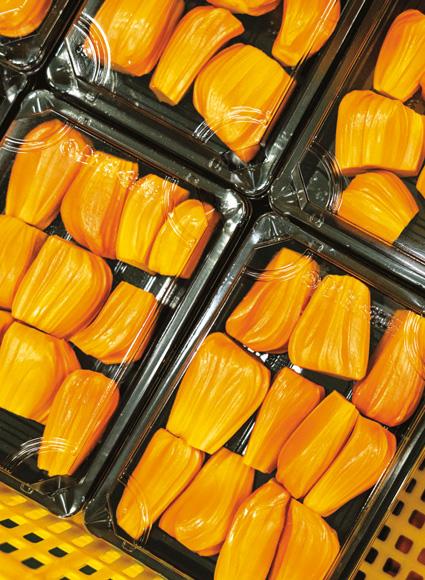

Beloved by many but a new discovery for others, the Japanese muskmelon is making its way around the world from a special farm in Vietnam where only the best is selected…
Written by Ti any Eslick & Stephan Phelan



The King of Japanese Fruits has a very broad domain. That regal title was bestowed upon the Fuji muskmelon for its profound delicacy, superior quality and sheer popularity in its native country, but many other markets are developing a taste for it, too – across Southeast Asia and indeed the UAE, where Spinneys stocks the exquisite specimens grown and shipped by Agriteck Japan. And while each fruit begins with a Japanese F1 hybrid seed, it finds perfect shape, form and flavour at Agriteck’s specialised farm in Lâm Ð ng, Vietnam.
“Here you can experience all four seasons in a single day,” says farm manager Arita Koji at that site in the central highlands, near the regional capital Ðà L t. The weather may change by the hour but the climate remains mild and cool all year. Coupled with deep red, iron-rich, basaltic soils that draw their fertility from ancient volcanoes, “the conditions are ideal for agriculture in general and fruit cultivation in particular,” says Arita.
Even so, the Fuji muskmelon relies on a very particular balance of advanced technology and hands-on farming expertise. For one thing, it’s only grown in greenhouses that cover nine separate zones across almost two hectares, all with automated roof-opening and control systems imported from Japan. “We strictly monitor temperature, humidity, light and other environmental factors for each stage of the melon’s growth.”
At the same time, says Arita, “each one of our engineers is a true artisan”. “Even the smallest mistake in management can immediately impact the quality of muskmelons. [So], our growers must ‘communicate’ with the melons, understanding what they need and how to nurture them into high-quality, high-value fruits.” Current capacity allows for two to three harvests per month and the process is based around a policy of “one fruit per tree”.
As the plants begin to flower, they are cultivated in such a way that lesser specimens are steadily removed until
PREVIOUS SPREAD, FROM LEFT: The Fuji muskmelon is called King of Japanese Fruits; plants and fruits are carefully monitored during the growing process; the melons are grown in greenhouses.
THIS PAGE: Arita Koji.
OPPOSITE PAGE, CLOCKWISE FROM TOP LEFT : Currently, there are two to three harvests per month; the fruits are wrapped in newspaper through part of the growing period to shield them from UV rays and to gain maturity; each fruit starts life as a Japanese F1 hybrid seed; the climate remains mild and cool all year; muskmelons have a shorter shelf life and delicate skin; juvenile muskmelon plant; once the plants begin to flower, lesser specimens are removed until the best melon remains.

The Japanese muskmelon has been a Spinneys customer favourite for a number of years now. But not everyone knows the time, dedication and advanced husbandry that goes into producing these tasty gems. They are also really nutrient rich as all the energy from the tender trailing plants goes into a single melon.
only the single best melon is left at the end of the cycle. Wrapped in newspaper through part of the growing period to help them mature and shield them from harmful UV rays, the prized fruit is even more vulnerable when picked.
Agriteck Japan founder Tsuyada Nobuaki explains, “Compared to other melons, muskmelons have a shorter shelf life and more delicate skin, making them highly susceptible to physical impact and temperature changes.” They also continue to ripen after harvest, making them even easier to bump and bruise. Further innovations help mitigate any possible damage and the practicalities of protecting the fruit are bound up in the Japanese gift for presentation. The whole farm at Lâm Ð ng operates under a certain eyepleasing aesthetic, with staff dressed in lovely melon-green polo shirts and the packaging designed to match.
Extreme care is called for, says Tsuyada, “to prevent drops or rough handling”. “Immediately after harvest, each Fuji muskmelon is carefully selected and wrapped individually in thick cushioning nets. Additional shockabsorbing materials are used to prevent scratches or damage during transport.” Air freight is prioritised for export, ensuring the fastest, freshest possible delivery, with temperatures carefully controlled all the way to supermarkets in neighbouring Cambodia and further afield in Hong Kong, Malaysia, Singapore and Dubai.
The UAE, admits Tsuyada, is “a priority for expansion”. “We believe that Agriteck Japan’s products, led by Fuji muskmelons, will meet the high expectations of customers at Spinneys, one of our most important partners.”
Consider again that every single fruit that makes it all the way to a foreign shelf was the chosen one, above all others on the tree. And Agriteck Japan now picks approximately 75,000 of those winners for sale and export every year. This is how the King of Japanese Fruits makes its presence known in other nations – by only ever presenting the best of itself.


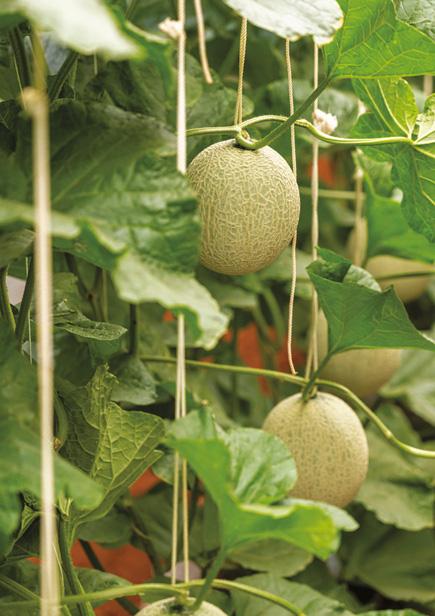







From mango and lychee orchards to durians that grow high above the forest floor, the Blue River company cultivates the best Thai tropical fruits on small farms across the nation
Written by Ti any Eslick & Stephan Phelan


Avisitor could travel the length and breadth of Thailand – see every kind of landscape and feel every variation in the native climate –just by plotting a route between Blue River’s farms. To the north of the country, this company’s partners and properties grow passion fruit and avocados, among many other crops. To the south and east, mangosteen, rambutan and durian. And to the west, not far from Blue River’s base and packing house near Kanchanaburi, managing director Soonthorn Sritawee calls himself “the only crazy mango farmer” amid vast surrounding fields of sugar cane.
The wider sugar plantation stands on land once owned by his father-in-law below Rocket Mountain, which gives this farm its name. But Soonthorn has gone his own way in terms of deciding what, and where, to plant. “I love mangoes, that’s it,” he says, standing in a long, cool, atmospheric tunnel of tall bamboo that provides not just shade but building and composting material, as well as homes for the bees that are essential to the fruiting process.
“I just want to grow good mangoes for the customer,” says Soonthorn, and that’s how it all started back in 2009, with multiple varieties of mango ripening well on this land and a few adjoining smallholder properties. “Our season starts in January with the Kaew Kamin mango, then we go into the main season for the Nam Dok Mai variety. Later comes the Mahachanok and those two take us through May, then by mid-June we have the Ah Ping.”
Soonthorn describes the fruit itself with a kind of delectation – the “super-sweet taste” of the yellow-skinned Nam Dok Mai, the “special aroma and flavour” of the tawny red Mahachanok.
The former grows relatively small, he explains, conserving its energy in such a way that it won’t tend to drop off the trees, while the latter often gets so heavy as to

At Spinneys we have been working with Soonthorn for almost 10 years now. He is one of our most passionate farmers and a fantastic mango grower.
The Thai Nam Dok Mai and Mahachanok varieties are two of the most exciting from our calendar and really deliver on flavour, sweetness and texture.
Blue River’s new state-of the-art packing facility is a recent exciting development which enables the team to bring us an extended range of delicious cook’s ingredients and vegetable mixes. We look forward to extending our range of exotic fruit and bringing a taste of Thailand to our customers in 2025.

fall from the branches in significant numbers, but without affecting the robustness of next year’s crop.
The harvest ends with the rains in midsummer, the drier, colder air arrives in November, the trees start to bud and the cycle starts again. “New leaves are the key to a fruit farm. New leaf means new life,” says Soonthorn, with casual profundity. “The flower will not grow by itself.” And when the fruit returns to the trees, he’ll watch the squirrels to see which ones they like.
“We can learn from them, they’re like fruit-tasters. Every season they will choose the best tree in the field and eat only from that tree. So we know that’s a good one and we might keep those mangoes for home consumption.”
Simple as he makes it all sound, there are obvious complexities and challenges to this kind of business, requiring flexibility and forward-thinking from the farmer. To this end, he’s installing solar panels at the
nearby packhouse and plans to compost all waste from that facility to reuse and sell to other growers. Already heavily invested in organic produce, he’s keen to explore biodynamic agriculture.
In the beginning, Soonthron tried to work only with local growers, but struggled to coordinate their operations in terms of food safety compliance and so on. “I said ok, ‘I’ll do it myself’.” Some 17 years later, he has since managed to create a network of smallholders under the Blue River banner, extending right across the country.
In this way, Soonthorn can mitigate the farmer’s oldest worry – the weather and its current worsening by climate change. Spreading his business to different regions, each with their own growing seasons and meteorological profiles, reduces the chance of disruption by a bad harvest in any one location. The mango varieties he could once supply about seven months a year can now be shipped year-round to international buyers from Asia to the USA.
Spinneys has come to rely on Blue River for more and more produce from an ever-wider selection of small affiliated farms (most less than three hectares). One such site is a lychee orchard in the central plains region, just southwest of Bangkok. Owned and run by husband and wife team Issariya and Phaungpet, this intensely fertile parcel of land is adorned with little Buddhist shrines and altars, and laced with narrow waterways that help irrigate the crop.
A canal-like system allows the farmers to open and close sluice gates and fill the fields as needed before letting any unwanted excess flow onward to the Gulf of Thailand. The rich underlying soil, fed by a particular zonal mix of fresh and salt waters, makes this region especially renowned for fruit – pomelo, coconut, guava – and gives these prize lychees “their own unique flavour”, as Spinneys’ commercial produce manager Neil Gibson puts it during one of his regular site visits. A unique texture, too, these specimens being somewhat drier and crunchier than the jellied juiciness many consumers are accustomed to.
“We buy all our fruit from this particular farm in April and May,” says Neil. “So often in agriculture there are huge operations behind the food we eat, but at Spinneys we really like to work with smaller producers so we can get to know them personally.”
The couple at this orchard have great relationships with Spinneys and Blue River after almost 20 years of supplying Soonthorn and 40 years of picking lychees from trees that are even older than that – more than 60 years in some cases. Further south into Chanthaburi Province, similarly small farms of three hectares occupy a region of very tall trees bearing other fruits that are very popular in Thailand but a little less familiar elsewhere.
The rambutan, for example, and the similarly sweet and tender mangosteen – a small, ancient, purple-skinned delicacy cultivated in huge numbers on gigantic tropical evergreens at a ratio of about 2,000 fruits per tree. The much bigger, heavier durian, meanwhile, grows on flowering branches so far above the ground that only specially trained workers can climb up to cut them down (at higher rates of pay that might be called “danger money”).
There’s a certain art to their harvesting, too, explains Soonthorn. “Maturity is the most important thing, but we can’t see that from the outside of the fruit, so we need to use a special tool to knock on the outside and listen for the right sound. If the durian is mature there is a gap under the shell that makes a noise like ‘thup-thup’, then we know it will have the eating quality that the consumer expects.”

PREVIOUS SPREAD, CLOCKWISE FROM LEFT: Rambutans just about ready for harvesting; amid the Nam Dok Mai mango trees at the foothills of Rocket Mountain; Soonthorn Sritawee checking on his Mahachanok mangoes.
THIS PAGE: Braving the heights for nature’s spikiest treasure – durians are harvested by hand high in the trees.
OPPOSITE PAGE, CLOCKWISE FROM TOP LEFT : Nam Dok Mai mangoes and plum mangoes, which are a speciality of Thailand, prized for their fragrant sweetness; lemongrass is carefully harvested by hand; a basket of ripe mangosteens shows off the deep purple rinds –delicate white segments lie inside; in the eastern region of Thailand, a network of narrow waterways supports year-round irrigation for fruit orchards; ripe durians reveal their rich yellow flesh – aromatic, custard-like and famously divisive; a bamboo tunnel curves through the mango farm, creating a shady, wellventilated path; at the heart of the land, a shrine stands; farming couple Issariya and Phaungpet work side by side; a tiny mangosteen begins to form.
BIGGER, HEAVIER
ON FLOWERING BRANCHES SO FAR ABOVE THE GROUND THAT ONLY SPECIALLY TRAINED WORKERS CAN CLIMB UP TO CUT THEM DOWN
The smell of the durian is famously pungent, and while the Thai population is well used to it, foreign visitors and shoppers are often put off buying that fruit. They shouldn’t be, says Soonthorn. He won’t deny the strength of the smell, especially in enclosed spaces. But he will also evangelise for the pleasures and health benefits of the durian, calling it “the king of fruit” and sounding almost mystical again. “It tastes sweet and creamy, and it gives you energy that generates heat in your body when you eat it...like a power that wakes you up.”
Soonthorn’s father was a rice farmer – a very different sort of crop and a very different business. His own agricultural domain now is much larger, more varied, more logistically complex. But certain principles still hold and certain lessons still apply.
“The most important thing my father told me was to always keep fighting. When you start a farm there’s lots of problems, with supply chain and things like that. But you must keep going and never give up.”
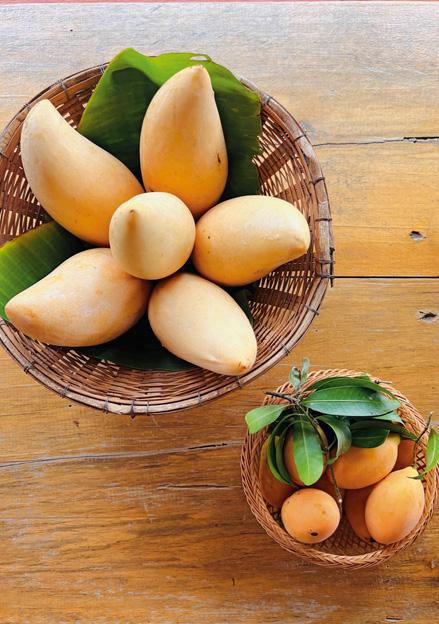
















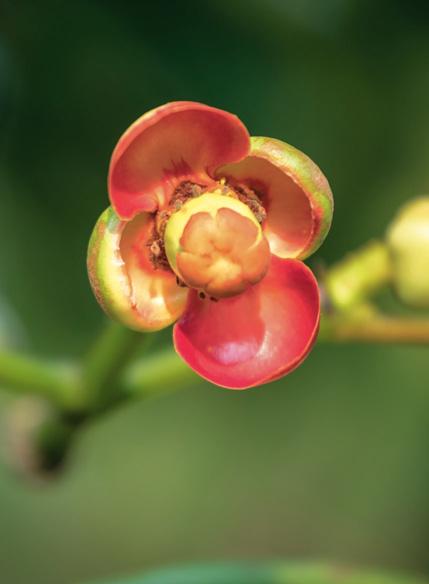




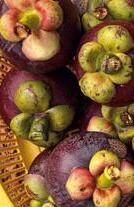










Whip up vibrant East Asian curries, rich in spices, traditions and regional flavours

20 MINS
Fish amok is Cambodia’s national dish.
It’s a fragrant, creamy steamed fish curry infused with lemongrass, turmeric and coconut. Traditionally presented in banana leaf cups, you can serve it with steamed rice for an authentic Cambodian experience.
Prep time: 10 minutes
Cook time: 20 minutes
Serves: 4
For the yellow kroeung paste
1 lemongrass stalk
2cm galangal or ginger
2cm piece of turmeric
1 shallot
3 garlic cloves
2 lime leaves, plus extra for serving
¼ tsp Spinneysfood Fine Sea Salt
For the fish amok
2 dried red chillies
500g hake or cod fillets
3 tbsp yellow kroeung paste
1 tbsp fish sauce
1 tsp shrimp paste
10g palm sugar
125ml coconut cream
2 large Spinneysfood Organic Free-Range Eggs
½ tsp Spinneysfood Fine Sea Salt
Handful of Spinneysfood Organic Baby Spinach
To serve
1 red chilli

1 To make the kroeung paste, crush and roughly chop the lemongrass. Peel and roughly chop the galangal or ginger, turmeric and shallot. Peel and crush the garlic. Using a pestle and mortar or a small blender, grind the lemongrass, lime leaves and galangal until they release their oils and form a rough paste. Add the garlic, shallot, turmeric and salt, blending thoroughly after each addition until a thick, smooth paste forms. If the mixture is too dry, add a splash of water. Transfer to a sterilised jar with a teaspoon of oil on top to prevent it from drying. This can be kept for up to 5 days. 2 Soak the chillies in boiling water until softened. Remove from the water and finely chop into a paste. Chop the fish fillets into bite-sized pieces. In a medium-sized bowl, combine the kroeung with the crushed chillies, fish fillets, fish sauce, shrimp paste, palm sugar, 100ml of coconut cream, eggs and salt. Stir gently if you prefer chunky pieces of fish or mix vigorously for a smoother texture. Test the seasoning by cooking a small spoonful in a pan or microwaving it. Adjust with more salt, sugar, fish sauce, or chilli as needed.
3 Divide the fish mixture among four 125ml ramekins, coconut shells, or banana leaf baskets, filling almost to the top. Place in a steamer over a pot of boiling water for 15 minutes. Five minutes before finishing, drizzle the remaining coconut cream over the top and steam until firm. 4 Finely slice the extra lime leaf and julienne the chilli. Scatter over the fish amok. 5 Serve immediately with steamed rice. If serving family-style, place the fish amok at the centre of the table for guests to share.
For a healthier version of kare pan, bake at 180°C, gas mark 4, for 20-25 minutes, flipping halfway through, until golden brown.

20 MINS
The name of this popular Japanese snack means ‘curry bread’ in English. It is made with mildly spiced curry that’s encased in dough that’s coated in breadcrumbs then fried until golden.
Prep time: 20 minutes
Cook time: 10 minutes
Serves: 4
For the dough
350g Spinneysfood Organic Self-Raising White Flour
½ tsp Spinneysfood Fine Sea Salt
250g Spinneysfood Full Fat Greek Yoghurt
For the curry filling
1 small brown onion
1 small carrot
1 small Spinneysfood Nicola Potato
2 tbsp Spinneysfood Pure Sunflower Oil
200g Spinneysfood Less Than 5% Extra Lean Beef Mince
2 tsp mild curry powder
2 tsp corn flour
125ml Spinneysfood Bottled Drinking Water
2 tbsp soya sauce
1 tbsp Worcestershire sauce
Spinneysfood Fine Sea Salt, to taste
Spinneysfood Black Pepper, freshly ground, to taste
For coating and frying
1 large Spinneysfood Organic Free-Range Egg
30g Panko breadcrumbs
2L Spinneysfood Pure Sunflower Oil, for frying
1 In a large mixing bowl, combine the flour, salt and Greek yoghurt until a dough forms. Mix well, then use your hands to knead it into a soft, smooth dough. Cover and let it rest while you prepare the filling. 2 Finely dice the onion, carrot and potato. Heat the oil in a medium-sized pan over a medium heat. Add the onion and sauté until soft and translucent. Add the diced carrot, potato and beef mince and sauté until the mince has browned. In a small bowl, combine the curry powder, corn flour and water and stir to form a slurry. Add to the mince along with the soya sauce and Worcestershire sauce. Simmer for a few minutes until thickened. Adjust the seasoning with salt and pepper. Let it cool completely.
3 Divide the dough into 6 equal pieces. Roll out each dough ball into a 10cm x 13cm oval. Place the filling on the top half. Fold the bottom half up to meet the top edges, ensuring the curry doesn’t touch the edges. Pinch firmly to seal the edges. Place the kare pan seam-side down on a tray lined with baking paper and cover with a damp towel. Repeat for the remaining pieces of dough.
4 Whisk the egg and place it in a shallow wide dish. Place the breadcrumbs in another flat dish. Dip each stuffed dough into the beaten egg, then coat it with the breadcrumbs. 5 Heat the oil to 180°C in a deep pan. Fry the kare pan for approx. 2–3 minutes, until golden brown and crispy. Remove and drain on paper towels. 6 Serve warm with a side of Japanese pickles.
To give this curry extra depth of flavour, simmer it for a few more minutes before adding the salmon.
Prep time: 10 minutes
Cook time: 20 minutes
Serves: 4
For the curry soup
1 tbsp Spinneysfood Pure Sunflower Oil
1 tbsp ginger paste
2 tbsp Thai red curry paste
800g coconut milk
3 tbsp fish sauce
1 tsp Spinneysfood Light Muscovado Sugar
For the salmon
2 tsp Spinneysfood Pure Sunflower Oil
600g salmon fillets, skin removed
To serve
5cm piece fresh ginger
1 Thai red chilli
1 lime
Handful of Spinneysfood Fresh Basil Steamed jasmine rice
1 Heat the oil in a pan over a medium heat. Stir in the ginger paste and red curry paste and sauté until fragrant. Pour in the coconut milk and stir well. Simmer for 3-4 minutes. Stir in the fish sauce and sugar, and bring to a boil, then reduce heat and simmer for 5 minutes. Remove from heat and set aside.
2 Meanwhile, heat the oil in a large non-stick pan over a medium-high heat. Cook the salmon, on either side, approx. 3-4 minutes, until golden. Place in the pot with the curry and cook over a low heat for approx. 5 minutes for the salmon to finish cooking.
3 Peel and finely slice the ginger into matchsticks. Finely slice the chilli at an angle. Quarter the lime. Divide the curry between 4 bowls and top with ginger matchsticks, chilli and basil leaves. 4 Serve with jasmine rice and lime wedges on the side.






Once you have chopped the eggplant, sprinkle over some salt. This process, called degorging, draws out excess moisture and reduces bitterness, resulting in a firmer texture when cooked.

20 MINS
This classic Filipino chicken stew is made in a rich, savoury peanut sauce, which gives it a nutty, earthy flavour, while the toasted rice
flour in it imparts creamy notes.
Prep time: 10 minutes
Cook time: 20 minutes
Serves: 4
For the chicken
80g glutinous rice
50g roasted peanuts
2 tbsp Spinneysfood Pure Sunflower Oil
8 Spinneysfood Fresh Boneless Chicken Thighs
1 small brown onion
4 garlic cloves
1 tsp ground atsuete seeds or paprika
150g Spinneysfood Smooth Peanut Butter
700ml chicken stock
2 tbsp fish sauce
For the vegetables
1 large Spinneysfood Organic Eggplant
1 tbsp Spinneysfood Pure Sunflower Oil
Spinneysfood Fine Sea Salt
100g long beans
100g Spinneysfood Organic Pak Choi
1 Toast the rice in a dry pan for 3-5 minutes over a medium heat, stirring regularly, until lightly golden. Remove from the heat. Using a mortar and pestle, grind the rice into a fine powder. Set aside. Grind the peanuts into a coarse powder. Set aside. 2 In a medium-sized non-stick pot, heat the oil over a medium heat. Fry the chicken thighs until golden brown on either side. Remove from the heat and set aside.
3 Peel and finely slice the onion and mince the garlic. In the same pot, add the onions and garlic, cooking until softened. Stir in the ground atsuete or paprika and sauté for 1 minute or until fragrant. Stir in the peanut butter and cook until melted. Add the ground rice flour and stir until thickened. Add the chicken stock and stir to form the curry. Return the chicken thighs to the sauce and cook for 10-15 minutes.
4 Meanwhile, quarter the eggplant and place it in the basket of an air fryer, drizzle the oil over and season with salt. Roast in the air fryer for 10-15 minutes. While that cooks, bring a pot of water to a boil and blanch the green beans and pak choi for 2-3 minutes or until just tender. 5 Divide the curry between 4 bowls and top with the eggplant, long beans and pak choi. Sprinkle the ground peanuts over and serve.
20 MINS
The vegetable laksa can be served with rice vermicelli noodles or simply as a curry with rice on the side.
Prep time: 15 minutes
Cook time: 20 minutes
Serves: 4
For the tofu
50g Spinneysfood All-Purpose Flour
½ tsp Spinneysfood Fine Sea Salt
250g firm tofu
1 tbsp Spinneysfood Pure Sunflower Oil
For the laksa
185g bottled laksa paste
2 x 400ml tins coconut milk
375ml Spinneysfood Bottled Drinking Water
500g Spinneysfood Tenderstem Broccoli
To serve
120g bean sprouts
20g Waitrose Cooks’ Ingredients Crispy Fried Onions
1 red chilli
Handful of Spinneysfood Fresh Coriander
1 lime
It’s best to use firm tofu in this dish since its dense texture allows it to soak up the rich, spiced sauce while maintaining its shape.
1 Place the flour in a flat dish and stir in the salt. Cube the tofu into 2cm squares, then toss in the seasoned flour. 2 Heat the oil in a large frying pan over a medium heat. Add the tofu and pan-fry for 3-4 minutes on each side or until golden and crispy. Transfer to a plate and set aside. 3 Place a large heavybased saucepan over a medium heat. Add the laksa paste, stirring for 3 minutes until fragrant. Stir in the coconut milk and water. Bring to a simmer over a medium heat. Add the broccoli and cook for 2 minutes or until just tender. 4 Divide the laksa between 4 bowls and top each bowl with the pan-fried tofu, bean sprouts, crispy onions, sliced red chilli and fresh coriander. Serve with lime wedges on the side.























































Discover vibrant dishes from Asia’s heartlands – fragrant, spice-packed recipes from Japan to the Philippines await


Prep time: 1 hour
Cook time: 10 minutes
Serves: 6
From smoky char kway teow to refreshing oroshi soba, these vibrant dishes celebrate bold fl avours, textures and techniques from across Asia’s diverse culinary landscape
For the imperial rolls
50g dried mung bean noodles
2 medium carrots
30g Spinneysfood Shiitake Mushrooms
1 small shallot
1 garlic clove
2cm piece fresh ginger
500g Spinneysfood Grass-Fed Extra Lean Beef Mince
1 large egg white
1 tbsp fish sauce
1 tbsp Spinneysfood Pure Sunflower Oil
½ tsp Spinneysfood Fine Sea Salt

½ tsp Spinneysfood Ground White Pepper
1 tsp Spinneysfood Fine Grain White Sugar
For the wrappers
325ml warm Spinneysfood Bottled Drinking Water
2 tsp Spinneysfood Extra Fine Caster Sugar
2 tbsp corn flour
24 dried rice paper wrappers
2L Spinneysfood Pure Sunflower Oil, for frying
For the dipping sauce
2 tbsp Spinneysfood Bottled Drinking Water
2 tbsp Spinneysfoods Extra Fine Caster Sugar
1 lime
2 tbsp fish sauce
1 garlic clove
1 bird’s eye chilli
To serve
345g dried rice vermicelli noodles
1 small head of baby gem lettuce
2 Spinneysfood Organic Cucumbers
1 medium carrot
125g unsalted roasted peanuts (optional) 50g mung bean sprouts
1 Soak the mung bean noodles in warm water for 30 minutes. Drain well and cut into ½cm pieces. Finely grate the carrots. Finely slice the mushrooms. Finely dice the shallots. Mince the garlic. Finely grate the ginger. In a large bowl, combine the noodles, beef mince, vegetables, aromatics, mushrooms, egg white, fish sauce, oil, seasoning and sugar. Mix until completely combined. 2 Place 310ml of warm water and the sugar in a large shallow bowl and stir until the sugar dissolves. In a separate small bowl, combine the corn flour and remaining tablespoon of water to make a glue. 3 Working with one at a time, place a wrapper in the water for approx. 5-10 seconds. Remove the wrapper from the water and place on a clean plate. Shape approx. 40g of the beef filling into a log and place on one end of the wrapper. Tightly fold the wrapper over the filling once, tuck in the sides and complete folding the wrapper over the filling. Fold a second wrapper around, encasing the seam of
the first wrapper and brush the end with the corn flour glue to seal it. Place on a baking tray lined with parchment paper, seam side up. Repeat the process with the remaining ingredients. 4 Place the rolls in the refrigerator, uncovered, for approx. 1 hour or overnight. This will help the wrapper dry out which will result in a crunchier texture. Remove the rolls from the fridge 15 minutes before frying. 5 Combine all the ingredients for the dipping sauce in a bowl. 6 Heat a mediumsized pot of oil to 180°C. Working in batches of 3 or 4, fry the rolls until golden and crispy. approx. 5-6 minutes. Drain the rolls on a rack set over a tray. Once cooled, refry the rolls for a further 1-3 minutes. Drain over a rack set over a tray. 7 Cook the vermicelli noodles according to package instructions. Rinse in cold water and set aside. 8 Roughly chop the lettuce. Julienne the cucumbers and carrot. Roughly chop the peanuts. 9 Divide the noodles between 4 bowls and top with lettuce, cucumbers, carrots, bean sprouts and herbs. Slice the imperial rolls into bite-size pieces and arrange them over the fresh ingredients. Serve with the dipping sauce on the side.

A refreshing and umami-rich Japanese classic, oroshi soba combines chilled soba noodles with a light, savoury dashi sauce and fresh toppings for the perfect balance of flavour and texture.
Prep time: 25 minutes
Cook time: 30 minutes
Serves: 4
For the sauce
375ml Spinneysfood Bottled Drinking Water
10g katsuobushi (dried bonito flakes)
1 tbsp Spinneysfood Acacia Honey
1 tbsp rice vinegar
4 tbsp soya sauce
½ tsp Spinneysfood Fine Sea Salt
For the noodles and toppings
170g dried soba noodles
200g daikon radish or red radish
2 Spinneysfood Spring Onions
1 sheet nori seaweed
125ml katsuobushi (dried bonito flakes)
50g Panko breadcrumbs
1 Place the water in a medium-sized pot and bring to a boil. Add the bonito flakes and allow
to simmer for 10 seconds. Set aside and allow to steep for 15 minutes and strain, reserving the liquid. Stir in the honey, vinegar and soya sauce and bring to a boil. Turn off the heat and season, if necessary. Quickly cool down the sauce by placing the pot in a prepared ice bath. Set aside. 2 Bring a large pot of water to a boil and add the soba noodles. Stir quickly to prevent them from sticking together. Cook according to package instructions. Once cooked, drain and rinse the noodles in cold water. 3 Finely grate and squeeze out the liquid from the radish. Finely slice the spring onions and nori. 4 Divide the noodles and sauce between 2 bowls. Top with the radish, spring onions, seaweed, bonito flakes and Panko crumbs. Serve immediately.
To give char kway teow the best smoky flavour, use a very hot wok and avoid over-stirring. Let the noodles sear briefly before tossing.
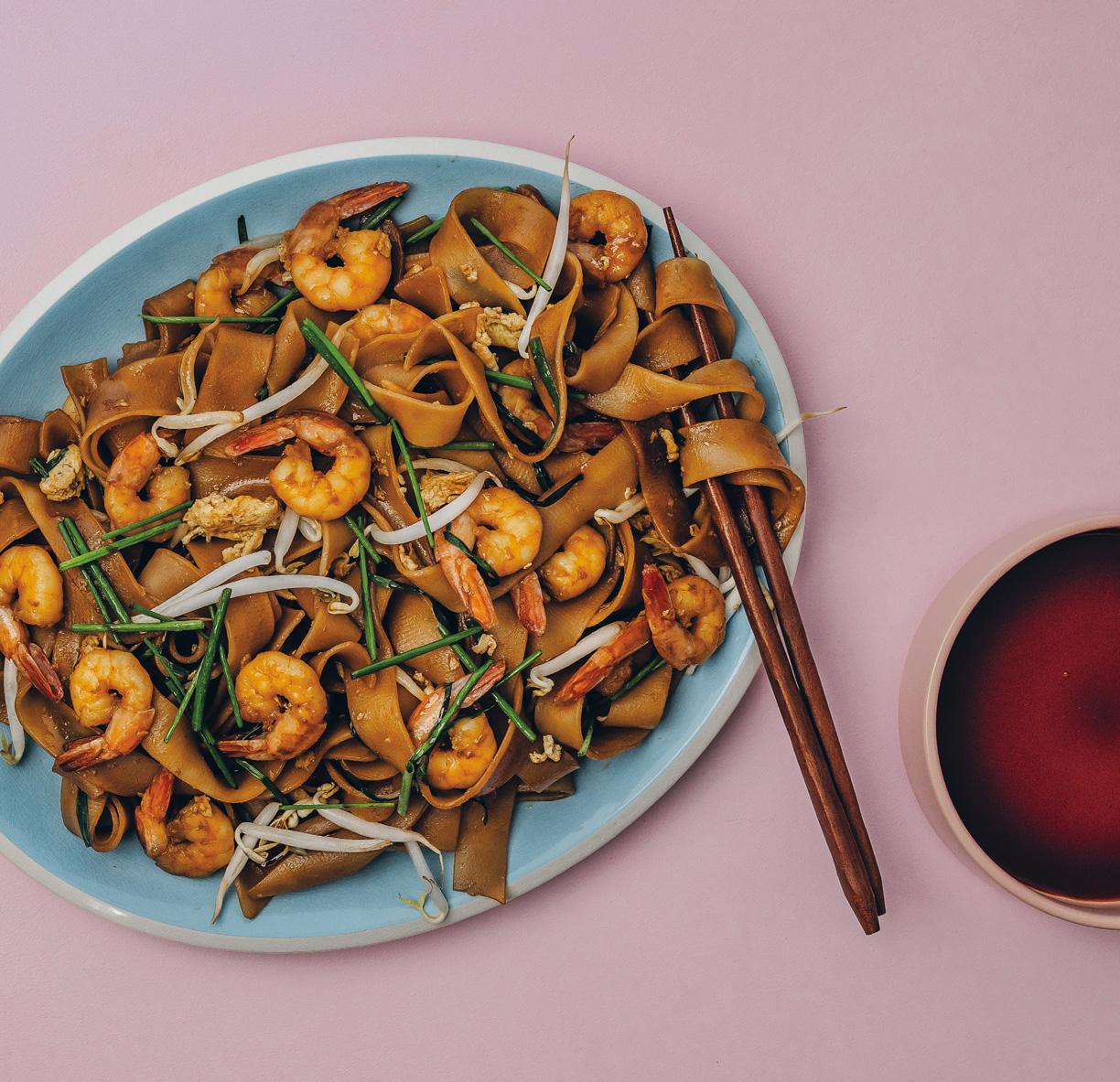
A smoky stir-fried noodle dish, char kway teow is a popular Southeast-Asian street food. This dish combines chewy rice noodles, shrimp and a rich, savoury sauce.
Prep time: 30 minutes
Cook time: 15 minutes
Serves: 2-3
For the noodles
225g Thai Choice Brown Rice Noodles
For the sauce
2 tsp dark soya sauce
2 tbsp soya sauce
1 tbsp fish sauce
1 tsp shrimp paste
1 tbsp oyster sauce
tsp Spinneysfood Ground White Pepper
1 tsp Spinneysfood Fine Grain White Sugar
For the stir-fry
2 garlic cloves
115g Spinneysfood Fresh Chives
1 large Spinneysfood Organic Free-Range Egg
3 tbsp Spinneysfood Pure Sunflower Oil
115g queen prawns, cleaned and peeled
170g mung bean sprouts
1 Soak the rice noodles in warm water for 30-45 minutes until softened. Drain and set aside. 2 In a small bowl, combine the ingredients for the sauce. Set aside. 3 Finely slice the garlic. Chop the chives into 5cm pieces. Whisk the egg. Heat 1 tablespoon of oil in a wok over a medium heat. Add the garlic and prawns to the pan and stir-fry for 20 seconds. Add the noodles and pour the prepared sauce evenly over. Drizzle in another 1 tablespoon of oil and add the chopped chives. Gently toss to minimise breakage. 4 Push the noodles to one side of the pan and add the remaining oil to the pan. Pour in the beaten egg, scramble for 15 seconds and stir into the noodles. Add the mung bean sprouts and stir-fry for 1 minute. If the noodles look dry, drizzle in extra water while stir-frying. 5 Transfer to individual bowls and serve.
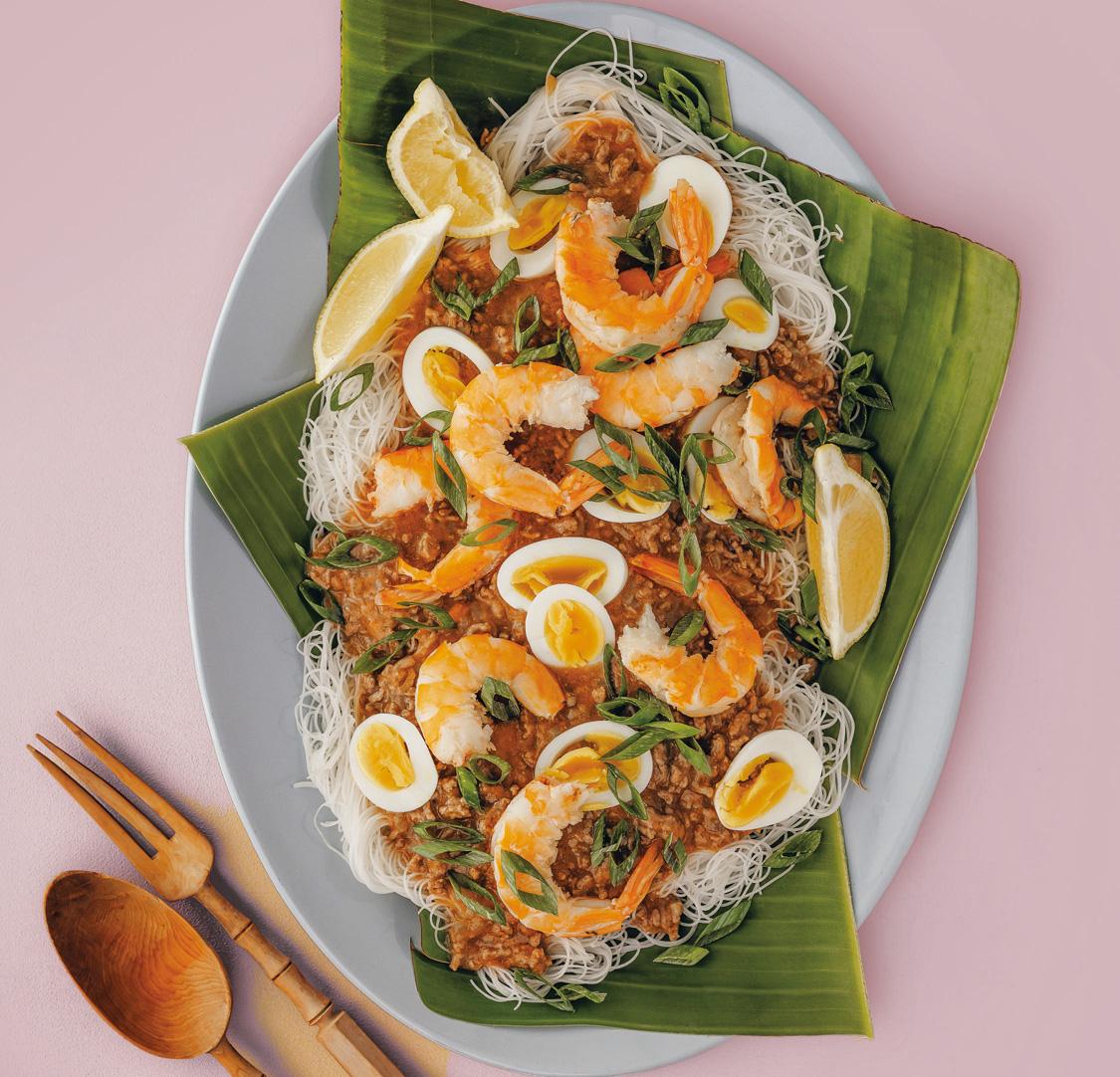
Prep time: 15 minutes
Cook time: 25 minutes
Serves: 6
For the palabok sauce
375ml vegetable stock
450g queen prawns, cleaned, shell on
2 tbsp corn flour
4 tbsp Spinneysfood Bottled Drinking Water
2 shallots
2 garlic cloves
2 tbsp Spinneysfood Pure Sunflower Oil
120g Spinneysfood Grass-Fed Lean Beef Mince
½ tsp Spinneysfood Paprika
1½ tbsp fish sauce (plus more to taste)
¼ tsp Spinneysfood Black Pepper, freshly ground
For the palabok noodles
225g rice noodles
1L Spinneysfood Bottled Drinking Water
To serve
2 hard-boiled eggs from Spinneys deli
4 Spinneysfood Spring Onions
1 lemon
1 Bring the stock to a boil. Add the prawns and cook for approx. 5 minutes or until pink and cooked through. Remove the prawns and cool slightly before peeling. Place the prawn shells back into the stock and simmer for approx. 10
minutes. Strain the stock and discard the shells.
2 In a small bowl, stir together the corn flour and water. 3 Finely dice the shallots and mince the garlic. Heat the oil in a large non-stick pan over a medium heat. Sauté the shallots and garlic until soft and fragrant. Add the beef and cook for 5 minutes, stirring occasionally. Stir in the prepared prawn stock, paprika, corn starch slurry, fish sauce and black pepper. Cook for a further 5 minutes, stirring frequently, until the sauce thickens. Set aside. 4 Cook the rice noodles according to package instructions (typically 3 minutes). Drain and transfer to a serving dish.
5 Slice the eggs. Finely slice the spring onions. Chop the lemon into wedges. 6 Arrange the noodles on a serving dish and drizzle over the sauce. Top with the sliced eggs and spring onions. Serve with lemon wedges on the side.
For heightened umami flavour, add a sprinkle of sesame seeds or a dash of Japanese chilli flakes before serving this dish.

Prep time: 10 minutes
Cook time: 10 minutes
Serves: 4
For the yaki udon sauce
2 tbsp oyster sauce
2 tbsp soya sauce
1 tbsp dark soya sauce
2 tbsp rice vinegar
1 tsp Spinneysfood Extra Fine Caster Sugar
2 tbsp sesame oil
For the udon stir-fry
400g udon noodles
2 garlic cloves
6 Spinneysfood Spring Onions
1 small green cabbage
2 tbsp Spinneysfood Pure Sunflower Oil
7 Spinneysfood Shiitake Mushrooms
To serve
30g bonito flakes, optional
1 In a small bowl, combine all the sauce ingredients then set aside. 2 Place the frozen udon noodles in a bowl of hot water and soak for 1-2 minutes until they loosen. Using chopsticks or tongs, gently separate them being
careful not to break them. Drain and set aside.
3 Mince the garlic and slice 5 spring onions. Finely slice the cabbage into thin ribbons. Heat 1 tablespoon of oil in a wok or large skillet over a high heat. Stir-fry the cabbage for 2-3 minutes until they soften. Add the garlic and spring onions, and stir-fry for a further 30 seconds. Add the noodles and sauce to the wok. Toss well until everything is evenly coated and heated through. 4 Thinly slice the mushrooms and heat a pan with the remaining oil to high heat. Add the mushrooms to the pan and cook until lightly golden. Add them to the wok with the noodles.
5 Transfer the noodles to serving plates. Finely slice the remaining spring onion lengthways. Top the noodles with the spring onion strips and bonito flakes, if using, and serve.

Turn cup noodles into fun, fl avour-packed meals with our creative twists. From spicy broths to crunchy cheese toasties, these pimped-up pots and packs are pure comfort




Prep time: 5 minutes
Cook time: 10 minutes
Serves: 1
For the noodle soup
1 x 105g Buldak Ramen Carbonara Big Bowl
250ml boiling Spinneysfood Bottled Drinking Water
1 garlic clove
1 large egg yolk
1 tbsp Kewpie mayonnaise
To serve
1-2 Spinneysfood Spring Onions
¼ tsp Spinneysfood White Sesame Seeds
1 Peel the lid halfway back and remove the two sachets from the pot. Add the boiling water up to the line inside the container. Close the lid and set aside for 4 minutes. 2 Mince the garlic and separate the egg yolk from the white. In a serving bowl, combine the garlic, egg yolk, Kewpie mayonnaise and the contents of the two sachets. If you prefer it to be less spicy, add only half of the Buldak sauce sachet. Whisk well until a smooth paste forms. Add 3 tablespoons of the water from the noodles, whisking vigorously to cook the egg yolk. 3 Discard the remaining liquid in the container and stir the sauce into the noodles. 4 Serve while hot, topped with spring onions and sesame seeds, if you prefer.
Prep time: 10 minutes
Cook time: 8 minutes
Makes: 2
1 x 140g Buldak Ramen Cheese
2L Spinneysfood Pure Sunflower Oil
4 slices Spinneysfood Cheddar Cheese
4 slices mozzarella cheese
4 slices Spinneysfood White Bread
50g Spinneysfood All-Purpose Flour
1 large Spinneysfood Organic Free-Range Egg
80ml Spinneysfood Bottled Drinking Water
1 Cut open the packet of Buldak Ramen Cheese and set the sauce sachet aside. Place the ramen noodles in a zip-top bag and crush using a rolling pin. Place the crushed noodles in a shallow dish. 2 Heat a pot of oil, or an air fryer to 180°C. 3 Arrange 2 slices each of Cheddar and mozzarella between the two slices of bread. In a shallow dish large enough to fit the sandwich, whisk together the flour, egg and water. Dip the sandwich in the egg mixture until coated on both sides. Gently press the coated sandwich into the crushed noodles. Repeat with the remaining cheese and bread. 4 Place the sandwiches in the oil or an air fryer and cook for approx. 5-6 minutes, or until golden and the cheese has melted. 5 Allow the toasties to sit for 2 minutes to ensure the cheese has fully melted before cutting and serving.
Turn your classic ramen into a more decadent dish by adding spring onions, a boiled egg or some Spinneysfood Sliced Teriyaki Chicken Breast for a delicious meal.
Prep time: 15 minutes
Cook time: 25 minutes
Serves: 2
2 Spinneysfood Spring Onions
1 x 114g Nongshim Gourmet Spicy Shin Ramyun
Instant Noodles
250ml boiling Spinneysfood Bottled Drinking Water
1 tbsp Spinneysfood Smooth Peanut Butter
To serve
1 boiled egg from Spinneys deli
2 tbsp furikake seasoning
2 tbsp chilli crunch (see recipe on page 117)
1 Finely slice the white and green parts of the spring onions. 2 Open the ramen lid about halfway and remove the sachets. Add the white parts of the spring onions, reserving the greens for later. Fill the tub up to the waterline with boiling water and cover for 5 minutes. Once cooked, reserve 3 tablespoons of water and discard the rest. 3 Add the peanut butter and the sachet of sauce and mix thoroughly. 4 Transfer to a serving bowl and top with a soft-boiled egg and scatter over some furikake and the spring onion greens. Optionally, top with some chilli crunch for an extra kick of spice.
Choose from an array of spicy, mild and cheesy instant noodles in stores.







Steaming traditions from across the East inspire these fl avour-packed recipes, from Thai nam jim fi sh to Japanese chawanmushi and spicy galbi jjim




Chawanmushi literally means ‘teacup steam’. It is a savoury Japanese egg custard dish usually eaten as part of a meal. Since egg custards cannot be eaten with chopsticks, it is one of the few Japanese dishes eaten with a spoon.
Prep time: 20 minutes (plus steeping time)
Cook time: 15 minutes
Serves: 4
25g dried shiitake mushrooms
Large pinch of katsuobushi flakes (optional)
480ml boiling Spinneysfood Bottled Drinking Water
1 tbsp rice vinegar
1 tsp Spinneysfood Fine Grain White Sugar
1 tbsp water
2 tsp light soya sauce
50g enoki mushrooms

3 large Spinneysfood Organic Free-Range Eggs
1 tsp mirin
½ tsp Spinneysfood Fine Sea Salt
100g Spinneysfood Scottish Smoked Salmon
To serve
1 tbsp Spinneysfood Fresh Chives
1 To make the shiitake dashi, steep the shiitake mushrooms and katsuobushi in boiling water for 15 minutes. 2 In a small bowl, heat the rice vinegar, sugar, water and 1 teaspoon of soya sauce in the microwave, stirring until the sugar dissolves. Add the enoki mushrooms. Let them pickle for at least 15 minutes while preparing the chawanmushi. 3 Crack the eggs into a bowl and gently whisk until combined, avoiding air bubbles. Add the dashi, mirin, remaining soya sauce and salt to the eggs,
Smoked salmon chawanmushi
whisking until smooth. Strain the mixture through a fine sieve for an ultra-smooth texture. 4 Prepare a steamer or a large pot with a steaming rack. Fill with hot water up to halfway up the sides of the cups. 5 Finely chop half the salmon and divide between 4 small heatproof cups. Pour the custard mixture over, filling each cup approx. ¾ of the way full. Cover with lids or foil. Bring the water to a gentle simmer (80°C–90°C, not boiling) and place the cups inside. Steam over a low heat for 10-15 minutes or until set. To check for doneness, insert a skewer in the centre of each cup. If clear liquid comes out, it’s ready. Once the custard is set, gently arrange the smoked salmon ribbons on top. 6 Drain the pickled enoki and place a few on each custard. Finely chop the chives and sprinkle over the tops. 7 Serve the chawanmushi while warm.
Customise the toppings: swap smoked salmon for trout, crab, or marinated tofu for a vegetarian option.
Cheat’s xiao long bao

Make the dumplings ahead of time. Once assembled, immediately place the dumplings on a tray and freeze. Once frozen, transfer to a freezer bag. When ready to cook, steam from frozen for an extra 2 minutes.
This shortcut version of xiao long bao uses store-bought dumpling wrappers and a gelatinised chicken bone broth to create juicy, flavourful soup dumplings with minimal effort. The broth is set with gelatin, cut into small cubes and folded into the chicken mince filling, mimicking the traditional labour-intensive process of making soup dumplings from scratch.
Prep time: 45 minutes (plus setting time)
Cook time: 10 minutes
Makes: 24
125ml Soule Soups Chicken Bone Broth
½ tsp gelatine powder
225g chicken mince
1 tbsp mirin
1 tbsp sesame oil
1 tbsp soya sauce
1 tbsp Spinneysfood Fine Grain White Sugar
1 tsp Spinneysfood Fine Sea Salt
1 tsp Spinneysfood Onion Powder
5cm piece fresh ginger
¼ tsp Spinneysfood Ground White Pepper
Corn starch, for dusting
140g Tokyo Wang Tang Gyoza Wrappers
1 tbsp sesame oil for steaming
1 Heat the chicken bone broth in a small saucepan over a low heat. Sprinkle the gelatine over the warm broth and stir until completely dissolved. Pour the mixture into a shallow 15cm x 10cm dish and refrigerate for at least 1 hour or until set. Once firm, cut the broth into tiny cubes (approx. ½cm each) and set aside.
2 In a mixing bowl, combine the chicken mince, mirin, sesame oil, soya sauce, sugar, salt, onion powder, grated ginger and white pepper. Stir the mixture in one direction until it is sticky and well combined. Gently fold in the gelatinised broth cubes, ensuring they are evenly distributed without breaking them. 3 Lightly dust a tray with corn starch to prevent the dumplings from sticking. 4 Place one dumpling wrapper on a clean surface and add 1 teaspoon of the filling to the centre. Moisten the edges of the wrapper with a bit of water. Pleat the edges upwards, pinching as you go, to create a small pouch with a sealed top. Repeat with the remaining wrappers and filling. 5 Grease a bamboo steamer with the sesame oil or line with baking paper. Arrange the dumplings in the steamer with enough space between them to prevent sticking. Bring a pot of water to a gentle simmer (not a rolling boil) and place the steamer on top. Cover and steam for 8-10 minutes until the wrappers turn translucent and the filling is fully cooked. 6 Serve the xiao long bao immediately.
This modern take on bánh bèo keeps the delicate, silky steamed rice cakes but replaces the traditional meat floss and lard with crispy fried shrimp for a satisfying crunch. A velvety mung bean topping, fragrant scallion oil, and a
The batter, mung bean spread and dipping sauce can all be made a day ahead.

tangy dipping sauce round out the flavours, making this
dish a perfect light appetiser or snack.
Prep time: 30 minutes (plus resting time)
Cook time: 15 minutes
Serves: 6
For the mung bean topping
50g split mung beans, soaked overnight
1 tsp Spinneysfood Fine Sea Salt
For the bánh bèo (rice cakes)
310g rice flour (not glutinous)
4 tbsp tapioca flour
1 tsp Spinneysfood Fine Sea Salt
1L warm Spinneysfood Bottled Drinking Water
For the scallion oil
4 tbsp Spinneysfood Pure Sunflower Oil
1 bunch Spinneysfood Spring Onions
Pinch of Spinneysfood Fine Sea Salt
For the dipping sauce
2 tbsp fish sauce
4 tbsp water
3 tbsp Spinneysfood Fine Grain White Sugar
1 tbsp fresh lime juice
1 red bird’s eye chili
For the crispy fried mini shrimp
300g Spinneysfood Everyday Cooking Shrimps
2 tbsp corn starch
1 tsp Spinneysfood Fine Sea Salt
Spinneysfood Pure Sunflower Oil, for frying
1 Drain and rinse the soaked mung beans. Add to a large pot filled with water and place over

a medium heat. Bring to a boil. Boil the beans until very soft. Transfer to a food processor and pulse until smooth. Add extra water, if necessary. Stir in the salt and set aside. 2 In a large bowl, combine rice flour, tapioca flour and salt. Gradually whisk in half the warm water, mixing until smooth. Add the remaining water and whisk again. Let the batter rest for 1 hour. 3 In a small saucepan, heat the oil over a medium heat. Finely chop the spring onions. Add the spring onions and salt to the oil, stirring for 1-2 minutes until just softened. Remove from heat and set aside. 4 To make the dipping sauce, whisk together fish sauce, water, sugar and lime juice in a bowl. Finely chop the chilli and add to the sauce. Set aside until ready to serve. 5 Pat the shrimp dry and toss them with
corn starch and salt. Heat the oil in a frying pan over a medium-high heat. Fry the shrimp in batches for 3-4 minutes, until golden and crispy. Transfer to a plate lined with paper towels to drain excess oil. 6 To steam the rice cakes, prepare a steamer with simmering water. Brush small, shallow heatproof bowls with some of the scallion oil. Arrange the bowls in a steamer and fill each with 1 tablespoon of the batter. Steam over simmering water for 5 minutes or until set. Carefully remove the bowls and let them cool slightly before unmoulding. Place the steamed rice cakes on a serving plate. 7 Spoon a small amount of mung bean paste onto each rice cake. Top with the crispy shrimp and drizzle over the scallion oil. Serve with the dipping sauce on the side.
This fragrant fish dish provides the signature Thai contrast of heat, sweetness and tanginess. If you don’t have a steaming basket large enough to accommodate the fish, a roasting pan covered with foil set over the stove will do the trick.
Prep time: 20 minutes
Cook time: 15 minutes
Serves: 4
For the nam jim sauce
6 garlic cloves
6 small bird’s eye chillies
2 tbsp palm sugar
3 tbsp Thai fish sauce
2 limes
Small handful of Spinneysfood Fresh Coriander
For the garnish
2 Spinneysfood Spring Onions
For the fish
50g galangal
2 stalks lemongrass
1 whole sea bass
3-4 fresh kaffir lime leaves
2 garlic cloves
2 Thai bird’s eye chillies
½ bunch Spinneysfood Fresh Coriander
2 Spinneysfood Spring Onions
2 tbsp sesame oil
2 tbsp Spinneysfood Pure Sunflower Oil
1 Peel the garlic and halve and deseed the chillies. Using a mortar and pestle, pound the garlic and chillies into a rough paste. Add the sugar, fish sauce and squeeze in the lime juice. Stir until well combined. Finely chop the fresh coriander and stir into the sauce. Set aside.
2 To make the garnish, thinly slice the spring onions lengthways and place in a bowl of iced water. Store in the fridge until needed. 3 Slice the galangal and smash the lemongrass. Stuff the fish cavity with the galangal, lemongrass and kaffir lime leaves. Chop the garlic, chillies, coriander and spring onions and mix together. Spread half the mixture over the top of the fish.
4 Set up a large wok or steaming pan with a steamer stand and fill it with boiling water, approx. one-third up the sides. Place the fish on a heatproof plate and place it in the steamer. Cover and steam for 7-12 minutes or until a thermometer inserted into the thickest part of the fish reads 63°C. Once cooked, remove the fish from the steamer. Sprinkle the remaining coriander mixture on top. Heat the sesame and sunflower oils in a pan until smoking hot. Carefully pour over the fish to sizzle. 5 Spoon the nam jim sauce over the fish and scatter over the curly spring onions. Serve the fish with extra limes, steamed vegetables and the pan juices on the side.

This twist on traditional galbi jjim features tender braised beef short ribs simmered in a rich, flavourful sauce infused with gochugaru, soya sauce and garlic. This is the perfect comfort dish to enjoy with a bowl of rice and kimchi.
Prep time: 20 minutes
Cook time: 2 hours
Serves: 8
2.3kg beef short ribs
1L Spinneysfood Bottled Drinking Water
500ml beef stock
180ml soya sauce
70g Spinneysfood Extra Fine Caster Sugar
6 tbsp Good Seoul Gochujang Spicy Red Pepper Paste
1 tsp Spinneysfood Ground Black Pepper
1 head of garlic
2cm piece fresh ginger
4 tbsp apple or pear juice
320g Korean radish or Yukon gold potatoes
2 large carrots
2 large yellow onions
6 Spinneysfood Spring Onions
3 green or red chilies
1 Place the short ribs in a large pot and add the water, stock, soya sauce, sugar, gochujang, black pepper, garlic, ginger and apple juice. Stir well, cover and bring to a hard boil over a high heat for 30 minutes. Reduce the heat to medium and let it simmer gently for 1 hour or until the ribs are tender. 2 Peel and cube the radish and carrots, and quarter the onions. Add the vegetables to the pot and simmer for a further 30 minutes until soft. Meanwhile, finely chop the spring onions and chillies. Remove the pot from the heat and stir in spring onions and chillies. 3 Serve the galbi jjim hot with steamed rice and kimchi on the side.
Mānuka honey’s special combination of unique properties and distinct taste give it exceptional qualities. The precious nectar of New Zealand’s native mānuka trees (Leptospermum Scoparium) and the bees make it naturally unique. Scientific research has proven its 2,300 signature markers, (vs. clover honey has approx. 90).



e bees its 0).


Every step from beehive to the pot remains in our expert care. We strategically place our hives in NZ’s native forests, rear our own queen bees for the healthiest colonies and carefully harvest and pack the precious honey every summer – all under our watchful eye.
The UMF™ quality mark guarantees authentic, monofloral mānuka honey from New Zealand. Every batch is scientifically tested in independent labs.














Try these favourite fl uffy buns with recipes from Korea, China and Japan. Plus, master the art of making them from scratch at home

Substitute Asian pear for a regular pear, apple or kiwi to get the same tenderising benefits from the marinade for the bulgogi.

Prep time: 1 hour 45 minutes (plus proofing time)
Cook time: 15 minutes
Makes: 10 bao
180ml Spinneysfood Bottled Drinking Water
2 tsp instant dry yeast
40g Spinneysfood Salted Butter
320g Spinneysfood Organic Bread Flour
22g corn starch
40g Spinneysfood Fine Grain White Sugar
2 tbsp Spinneysfood Baking Powder
2 tbsp Spinneysfood Pure Sunflower Oil
1 In the bowl of a stand mixer fitted with a dough hook, add the water and sprinkle the yeast over, giving it 5 minutes to bloom. 2 Melt the butter and add it to the bowl with the rest of the ingredients. Knead the dough for 8-10 minutes, or by hand for approx. 20 minutes. Once smooth, place the dough in a lightly oiled bowl and cover with a clean, damp cloth. Place in a warm area for approx. 1 hour or until
doubled in size. 3 Once risen, knead the dough lightly to knock out the air and divide it into 10 even-sized balls (approx. 45g). Cover with cling film and allow to proof again until light and fluffy and doubled in size – approx. 15 minutes. 4 In the palm of your hand, flatten the balls and roll each into an oval shape. Brush some oil in the centre to prevent sticking and fold over to create the classic bao shape.
5 Cut a round piece of baking paper and make a few holes for the steam to pass through. Lay it in the bottom of the steamer. 6 Place the bao into the steamer; do not overcrowd the basket. Steam the buns for 15 minutes, or until they have doubled in size and are soft and springy.
7 Rotate the steamer baskets every 5 minutes if the bottom ones cook faster than the top. Avoid lifting the lid immediately after steaming, as the sudden temperature drop can cause the bao to deflate. Instead, turn off the heat and let them sit in the steamer for 5 minutes before opening the lid slightly to release steam gradually. This helps maintain their perfect shape and fluffiness. 8 The buns are then ready to fill and serve.
Bulgogi translates to ‘fire meat’ in Korean, referring to the traditional method of cooking thinly sliced marinated strips of beef over an open flame or on a hot grill.
Prep time: 30 minutes (plus marination time)
Cook time: 30 minutes
Makes: 4
For the beef
300g Spinneysfood Beef Rib-Eye or Beef Fillet
1 small onion
2 Spinneysfood Spring Onions
1 tbsp Spinneysfood White Sesame Seeds
For the bulgogi marinade
¼ Asian pear or 1 small pear
1 small brown onion
2 garlic cloves
1 tsp ginger paste
3 tbsp soya sauce
1 tbsp rice vinegar
1 tbsp Spinneysfood Light Muscovado Sugar

This katsu sauce is ready in 15 minutes, but it’s even better if you let it sit in the refrigerator for a full day. Use it as a dipping sauce for spring rolls or other dishes.
¼ tsp Spinneysfood Black Pepper, freshly ground
1 tsp sesame oil
For the gochujang mayo
1 lime
3 tbsp Kewpie mayonnaise
1 tbsp gochujang
For the bao
8 home-made or store-bought bao
1 small red cabbage
Handful of Spinneysfood Fresh Coriander
1 tbsp toasted sesame seeds
1 Place the steak in the freezer for 30 minutes so that the meat becomes firm, which makes it easier to slice. Using a sharp knife, slice the beef as thinly as possible and place it in a medium bowl. Finely slice the onion. Chop the spring onions into 3cm long pieces. Place the onion, spring onion and sesame seeds in the bowl with the sliced meat. 2 To make the marinade, peel and remove the seeds from the pear. Roughly chop the pear and onion before adding them into a blender with the remaining ingredients. Blitz until smooth, then pour over the beef. Toss well, ensuring the meat is well coated. Set aside to marinate for 1 hour or up to 12 hours. 3 Juice the lime and add it to a bowl with the mayonnaise and gochujang to make the spicy mayo. 4 Slice the cabbage. Steam the bao according to the recipe above or package instructions if using store-bought baos. 5 Heat a pan over a high heat and sear the marinated beef strips in batches until caramelised and tender. The meat will form a charred crust to replicate ‘fire meat’. 6 Assemble the bao by spreading a spoonful of the spicy mayonnaise on one side of each bao. Add the cabbage and fill it with a generous spoonful of the bulgogi beef. Scatter over fresh coriander and extra sesame seeds before serving.
Prep time: 20 minutes (plus marination time)
Cook time: 20 minutes
Makes: 4
For the crispy chicken
300g Spinneysfood Fresh Boneless Chicken Thighs
1 tbsp soya sauce
½ tsp Spinneysfood Ground White Pepper
¼ tsp bicarbonate of soda
1 large Spinneysfood Organic Free-Range Egg
3 tbsp corn starch
2L Spinneysfood Pure Sunflower Oil, for frying
For the kung pao sauce
2 garlic cloves
1 tsp ginger paste
1-2 dried red chillies
½ tsp Sichuan peppercorns
1 tbsp Spinneysfood Pure Sunflower Oil
KUNG PAO CHICKEN IS A CLASSIC DISH FROM CHINA THAT GETS ITS CHARACTERISTIC FLAVOURS FROM RED CHILLIES, SICHUAN PEPPERCORNS AND PEANUTS. IT’S THE INSPIRATION BEHIND OUR CRUNCHY KUNG PAO CHICKEN BAO.
1 tbsp soya sauce
1 tbsp black vinegar
1 tbsp hoisin sauce
1 tbsp Spinneysfood Organic Natural Honey
For the bao
8 home-made or store-bought bao
3 tbsp toasted peanuts
3 tbsp crispy onions
1 small Spinneysfood Organic Cucumber
1 red chilli
50g pickled carrots (from Spinneys deli counter)
1 Chop the chicken into bite-sized pieces and place in a bowl. Add the soya sauce, white pepper and bicarbonate of soda. This process is called velveting and creates super tender, soft chicken. Set aside to marinate for 15 minutes. Once it has marinated, crack in the egg and add the corn starch to make a batter. 2 Heat a large pot of oil to 180°C over a medium-high heat. Carefully fry the chicken in batches until golden brown and crispy. Drain on a wire rack. 3 Finely chop the garlic and ginger and break the dried chilli into pieces. Heat a large pan or wok and dry toast the chilli and Sichuan peppercorns. Add the oil, garlic and ginger and stir fry for 1-2 minutes until fragrant. Stir in the soya sauce, black vinegar, hoisin sauce and honey. Simmer until thickened before setting aside. 4 Steam the bao according to the package instructions until soft and warm, approx. 6 minutes. 5 Meanwhile, toast the peanuts in a dry pan over a low heat until golden brown. Finely chop them and mix with the crispy fried onions for the crunchy topping. Thinly slice the cucumber and chilli. Add the crispy chicken to the kung pao sauce and toss until evenly coated. 6 To assemble the bao, arrange 2-3 cucumber slices on the base of each bun, top with pickled carrots and some crispy chicken. Scatter over a few slices of red chilli and top with the peanut-onion mixture for some crunch. 7 Serve immediately.
JAPANESE KATSU SWEET POTATO BAO
Prep time: 30 minutes
Cook time: 15 minutes
Makes: 4
For the potato
1 large sweet potato
50g Spinneysfood All-Purpose Flour
1 large Spinneysfood Organic Free-Range Egg
100g Panko breadcrumbs
2L Spinneysfood Pure Sunflower Oil, for frying
Spinneysfood Fine Sea Salt, to taste
For the katsu sauce
2 garlic cloves
5cm piece fresh ginger
2 tbsp Spinneysfood Tomato Sauce
1 tbsp soya sauce
1 tbsp Worcestershire sauce
1 tsp Spinneysfood Light Muscovado Sugar
½ tsp Spinneysfood Medium Curry Powder
To serve
8 home-made or store-bought bao
¼ napa cabbage
4 Spinneysfood Spring Onions
1 Peel and chop the sweet potato into equalsized cubes, 1cm x 1cm. Preferably, use a steamer to cook them until tender, or use a colander over a pot of boiling water. The potatoes should be tender but still firm enough to hold their shape for frying. Let them cool.
2 Meanwhile prepare a crumb station: place the flour in one bowl; beat the egg in a second bowl; and place the Panko breadcrumbs in a third. 3 In a large pot or deep-fryer, heat the oil to 180°C over a medium-high heat. Carefully coat each potato cube in flour, shake off the excess then dip in the egg. Finally, roll them in the breadcrumbs until they are well coated. Fry the cubes in batches until golden and crisp. Drain on paper towels and sprinkle with salt while hot to season and draw out moisture.
4 To make the katsu sauce, finely grate the garlic and ginger into a small bowl. Add the remaining ingredients and stir until combined. 5 Steam the bao according to the recipe above, or package instructions if using store-bought bao. 6 Slice the cabbage leaves into 4 equal rectangles to fit the buns and slice the spring onion into 3cm pieces. Spread some katsu sauce on one side of the bao, followed by the cabbage. Place 3-4 cubes of sweet potato in each bao and scatter over the spring onion. 7 Serve immediately.








Make a quick miso soup by stirring 2 tablespoons of red miso paste diluted in 500ml of vegetable stock as the base of the soup.

Deeply fl avourful and aromatic, these soups and broths from Vietnam, The Philippines, Thailand and China are nourishing and heart-warmingly satisfying
This traditional Filipino soup or stew is characterised by its sour and savoury flavour. It is usually made with fresh kangkong (water spinach) but watercress and baby spinach are good alternatives.
Prep time: 10 minutes
Cook time: 15 minutes
Serves: 2
For the soup
1 shallot
5 red radishes
2 Roma tomatoes
80g okra
500ml Soule Soups Shiro Miso Soup
1 tbsp tamarind paste (adding more if need be)
1 tbsp fish sauce
1 tsp coconut sugar
400g Spinneysfood Cooked Prawns
Handful of Spinneysfood Fresh Baby Spinach
3 long green chillies
To serve
1 lime
Steamed rice from Spinneys deli
1 Thinly slice the shallot and radishes. Quarter the tomatoes. Slice the okra into 2cm pieces.
2 Add the miso soup to a pot and heat on a low heat until warmed through. Stir in the tamarind paste, fish sauce and coconut sugar, adjusting the tamarind for a perfect balance of sourness. Add the shallots, tomatoes, radishes and okra to the broth, then simmer for 5 minutes until the vegetables soften slightly. 3 Stir in the prawns, spinach and whole green chillies before removing from the heat. The residual heat will wilt the spinach. If you prefer a spicier soup, add the chillies in the beginning to infuse. 4 Chop the lime into wedges. 5 Serve the sinigang hot with steamed rice and lime wedges on the side.
This Korean soup is made with whole chicken, ginseng and glutinous rice, traditionally enjoyed for its restorative and energising properties on a hot summer day.
Prep time: 15 minutes
Cook time: 1 hour 30 minutes
Serves: 2
1kg Spinneysfood Fresh Whole Chicken
45g glutinous rice
4 garlic cloves
3 Chinese jujubes or dried prunes
5g dried ginseng root or 1 ginseng teabag
2½-3L Spinneysfood Bottled Drinking Water
2 Spinneysfood Spring Onions
1 Rinse the chicken and remove any excess fat or loose skin. Rinse the rice before stuffing the cavity with the glutinous rice, garlic cloves and jujubes. Tie the legs together with kitchen twine to hold the filling inside. 2 Place the chicken in a large pot, add the ginseng root or teabag and
cover with water. Bring to a boil, then reduce to a simmer. Cover and cook for 1 hour 30 minutes, occasionally skimming off any impurities for a clear broth. 3 Finely slice the spring onions. 4 Once the chicken is tender, carefully remove it from the broth and cut into portions. 5 Serve the chicken in bowls with the hot broth.
Prep time: 10 minutes
Cook time: 10 minutes
Serves: 4
For the pho broth
400g Thai Choice Rice Noodles
1L Soule Soups Pho Broth
2 tbsp fish sauce, or to taste
300g Spinneysfood Beef Sirloin
To serve
2 limes
1 red chilli (optional)
Handful of Spinneysfood Fresh Coriander
Handful of Spinneysfood Fresh Basil
Handful of Spinneysfood Fresh Mint
50g mung bean sprouts
1 Cook the rice noodles according to packet instructions, then drain and divide them between serving two bowls. 2 In a medium-sized pot, heat the pho over a medium-low heat until just simmering, avoid bringing it to a boil. Season with the fish sauce. 3 To assemble the bowls, arrange the thin beef slices over the noodles and pour the hot broth over, allowing the residual heat to cook the meat slices. Chop the limes into wedges and finely slice the chilli. Top with a generous handful of roughly torn fresh herbs, bean sprouts and chilli, if you like a bit of heat.
4 Squeeze over some lime juice before serving.
CHINESE CLEAR BROTH WITH CHICKEN MEATBALLS
Prep time: 20 minutes
Cook time: 30 minutes
Serves: 4
For the meatballs
2 Spinneysfood Spring Onions
Handful of Spinneysfood Fresh Coriander
400g Spinneysfood Chicken Mince
1 large Spinneysfood Organic Free-Range Egg
2 tsp soya sauce
30g Panko breadcrumbs
½ tsp Spinneysfood Fine Sea Salt
¼ tsp Spinneysfood Ground White Pepper
For the broth
5cm piece fresh ginger
3 garlic cloves
2 Spinneysfood Spring Onions
500ml Soule Soups Chicken Bone Broth
500ml Spinneysfood Bottled Drinking Water
½ tsp Spinneysfood Fine Grain White Sugar
Spinneysfood Fine Sea Salt, to taste
¼ tsp Spinneysfood Ground White Pepper
To serve
200g Spinneysfood Organic Baby Spinach
1 Finely slice the spring onions and roughly chop the coriander. 2 In a medium-sized bowl, add the chicken mince, spring onions, coriander, egg, soya sauce, breadcrumbs and seasoning. Mix until everything is fully incorporated. Cover and set aside while you prepare the broth. 3 Roughly chop the ginger and garlic. Slice the spring onions into 3cm pieces. Add these to a large pot and cover with bone broth and water. Season the broth with the sugar, salt and white pepper. Bring to a boil, before reducing the temperature to a simmer for 30 minutes. 4 Using a small ice cream scoop, portion out the meatballs and roll them into balls. Place them on a lined baking sheet. 5 Using a slotted spoon, remove the aromatics from the broth and discard them. Increase the heat to medium-high to ensure the broth comes up to a boil, then gently drop the meatballs into the hot liquid. Stir to prevent them from sticking to the bottom. Continue to boil until the chicken meatballs begin to float, approx. 6 minutes. Turn off the heat and add the baby spinach, allowing it to wilt before serving. 6 Allow the soup to cool for a few minutes and then serve. This soup can also be served with rice noodles.
Creamy and flavourful with the perfect balance of citrusy, savoury and slightly sweet flavours, tom kha gai is a versatile soup that can be customised with any protein.
Prep time: 15 minutes
Cook time: 20 minutes
Serves: 2
1 lemongrass stalk
2cm piece fresh galangal
3 kaffir lime leaves
400ml coconut milk
250ml chicken stock
2 beef tomatoes
4 limes
1 tbsp fish sauce
1 tsp Spinneysfood Fine Grain White Sugar
Handful of Spinneysfood Fresh Coriander, for garnishing
2 tbsp Spinneysfood Extra Virgin Olive Oil with Chilli Pepper
1 bird’s eye chilli, optional
1 Bruise the lemongrass with the back of a knife and chop it into large pieces. Slice the galangal and tear the lime leaves to release their aroma.
2 In a pot, bring the coconut milk and stock to a gentle simmer. Add the lemongrass, galangal and kaffir lime leaves. Simmer for 15 minutes to infuse the flavours. 3 Quarter the tomatoes and juice the limes. 4 Stir in the fish sauce, sugar and tomatoes. Simmer for a further 5 minutes. Remove from heat and stir in the lime juice. 5 Top with plenty of fresh coriander and a drizzle of chilli oil before serving.

Substitute the ginseng root with a Barakat Ginseng Shot for the same restorative properties.
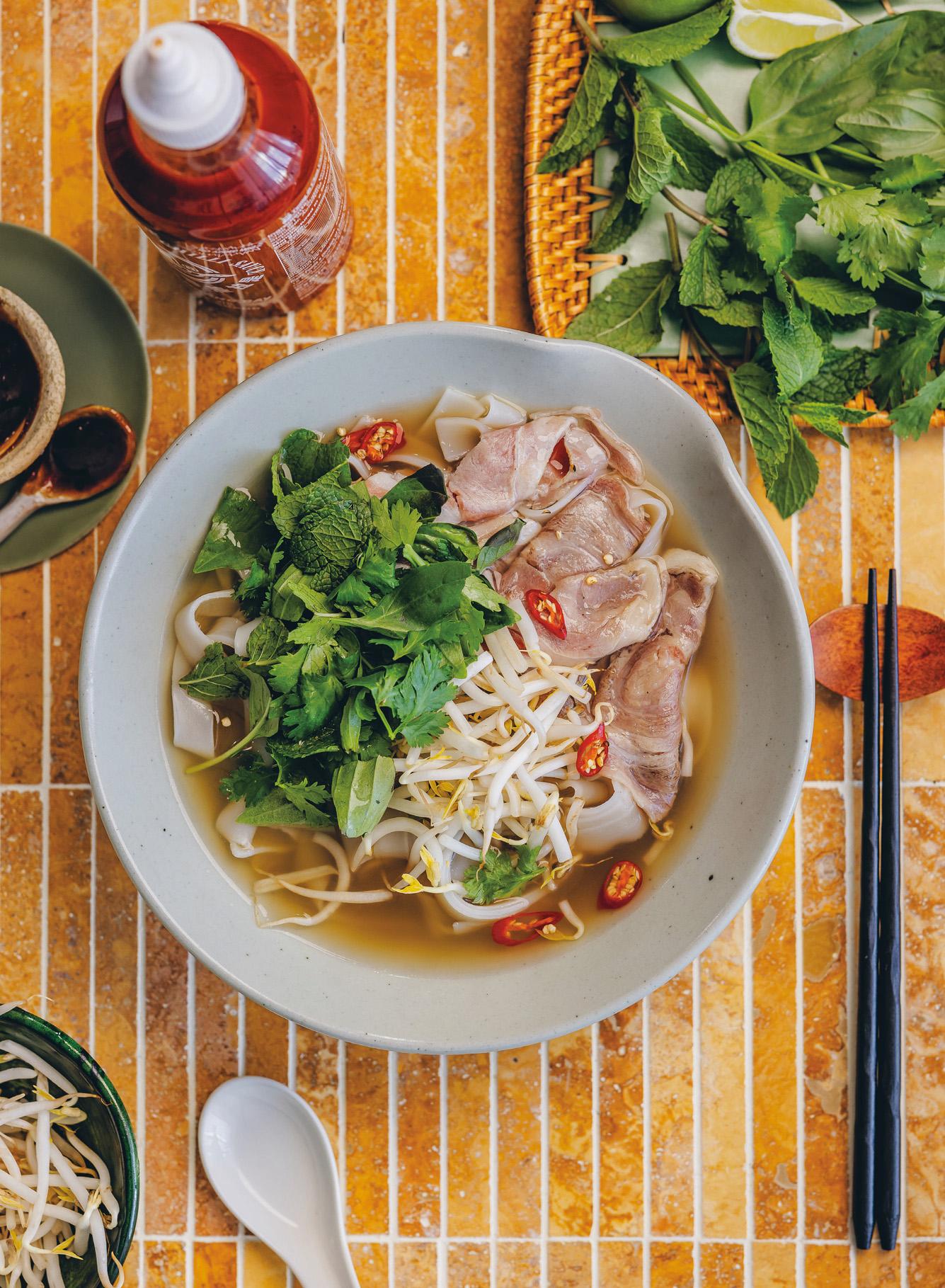
Ask your Spinneys butcher to thinly slice the sirloin for the pho.

For a quicker option, use ready-made Spinneysfood Chicken Meatballs.

Need a quick, comforting pick-me-up? We have a variety of soups in store.



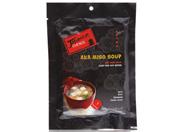

As a staple ingredient across Asia, this grain features in bold dishes that are full of history

Onigiri is best enjoyed fresh but can be stored for up to 6 hours at room temperature. If refrigerating, wrap in a thick kitchen towel to prevent it from drying out. To revive chilled onigiri, lightly grill in a pan with soya sauce to make yaki onigiri.

Prep time: 20 minutes
Cook time: 30 minutes
Makes: 10-12
For the steamed rice
450g uncooked Japanese short-grain white rice
600ml Spinneysfood Bottled Drinking Water
For the tuna filling
140g Spinneysfood White Meat Tuna in Olive Oil
2 tbsp Kewpie mayonnaise
½ tbsp soya sauce
For the shaping
1 tsp Spinneysfood Fine Sea Salt
2-3 tbsp furikake
3 nori sheets
1 Rinse the rice under cold water until the water runs clear. Drain well and transfer to a rice cooker, pot or Instant Pot. Add the 600ml of water and soak the rice for 20-30 minutes before cooking. Once cooked, fluff the rice and let it cool slightly until warm but still easy to handle.
2 Drain the tuna and place it in a bowl along with the mayonnaise and soya sauce. Mix until
well combined. 3 Using an onigiri mould, lightly wet the mould and sprinkle with salt. Fill halfway with warm rice, pressing gently into the corners. Add a spoonful of the tuna filling in the centre. Cover with more rice and sprinkle with salt. Press down firmly with the lid, then release onto a plate. Alternatively, wet your hands and rub a little salt between your palms. Scoop a handful of warm rice and shape it into a small ball. Create a well in the centre, add the filling and cover with more rice. Gently press into a triangle shape. 4 Lightly roll or press the onigiri into furikake for extra flavour. 5 Toast the nori over an open flame and cut into strips. Place a strip at the base of the onigiri before serving. If you prefer crispy nori, wrap just before eating.
Prep time: 5 minutes
Cook time: 5 minutes
Makes: 50g
2 tbsp Spinneysfood White Sesame Seeds
2 tbsp black sesame seeds
2 roasted nori sheets
1 tbsp bonito flakes (optional)
1 tsp Spinneysfood Fine Grain White Sugar
Sea
1 Heat a dry pan over a low heat and add the white and black sesame seeds. Toast for approx. 2 minutes until fragrant. 2 Crumble the nori sheets into small flakes and stir into the sesame seeds. Add the bonito flakes, sugar and salt. Stir well. Add in the soya sauce and quickly stir to distribute the flavour. Set aside to dry for approx. 1-2 minutes. 3 Store in an airtight container for up to 2 weeks.
A symbol of harmony, balance and cultural heritage, bibimbap is traditionally served in a hot stone bowl. It has a vibrant mix of rice, vegetables, protein and spicy gochujang sauce, with finely balanced flavours. Historically, it was a practical way to use leftover ingredients, but it has evolved into a dish deeply tied to Korean identity and seasonal eating.
Prep time: 15 minutes
Cook time: 20 minutes
Serves: 4
For the gochujang sauce
2 tsp soya sauce
2 tbsp rice vinegar
½ tsp Spinneysfood Extra Fine Caster Sugar
4 tbsp gochujang paste
2 tsp Spinneysfood Fine Grain White Sugar
2 tsp Spinneysfood White Sesame Seeds
For the bibimbap
4 tbsp soya sauce
2 tbsp rice vinegar
½ tsp Spinneysfood Extra Fine Caster Sugar
1 tsp sesame oil
1 tsp toasted sesame seeds
450g Spinneysfood Grass-Fed Rib-Eye Steak
3 garlic cloves
5cm piece fresh ginger
100g Spinneysfood Shiitake Mushrooms
2 medium carrots
4 tbsp peanut oil
150g Spinneysfood Organic Baby Spinach
50g bean shoots
4 large Spinneysfood Organic Free-Range Eggs
600g steamed rice from Spinneys deli
To serve
100g kimchi
4 Spinneysfood Snacking Cucumbers
1 tbsp Spinneysfood White Sesame Seeds
1 In a jug, combine the gochujang sauce ingredients together and set aside. 2 In a separate jug, combine the soya sauce, rice vinegar, sugar sesame oil and sesame seeds. Pour half of the mixture into a glass or ceramic dish, then stir in 1 tablespoon of gochujang sauce. Finely slice the beef into strips. Add the sliced beef to the dish and toss to coat. Set aside the remaining soya sauce mixture and gochujang sauce for later. 3 Peel and finely slice the garlic and ginger. Finely slice the mushrooms and julienne the carrot. 4 Heat 1 tablespoon of peanut oil in a wok or large frying pan over a high heat. Add the garlic and ginger and sauté for 10 seconds. Add the beef, spreading it out in the pan to sear for 30 seconds on one side before stir-frying until just cooked. Transfer to a plate and pour over any pan juices. 5 In the same wok, add another tablespoon of oil. Stir-fry the mushrooms and carrots for approx. 1 minute, then add the spinach, bean shoots, and reserved soya sauce mixture. Cook for a further minute until the vegetables are just wilted. Set aside. 6 Meanwhile, heat the remaining 2 tablespoons of oil in a non-stick frying pan and cook the eggs to your preference. 7 Divide the rice among bowls, top with the beef and sprinkle over extra sesame seeds. Arrange the stir-fried vegetables, kimchi, sliced cucumbers and fried eggs around the beef. Finish with a spoonful of gochujang sauce.
A warm and comforting Filipino rice porridge, arroz caldo is rich, garlicky and infused with ginger.
Prep time: 20 minutes
Cook time: 1 hour
Serves: 4
For the arroz caldo
5 garlic cloves
1 small brown onion
5cm piece fresh ginger
2 tbsp Spinneysfood Pure Sunflower Oil
450g Spinneysfood Fresh Boneless Chicken Thighs
1 tbsp fish sauce
185g glutinous rice or Spinneysfood Jasmine Rice
3L chicken stock
1 tsp Spinneysfood Fine Turmeric, optional
Spinneysfood Fine Sea Salt, to taste
Spinneysfood Black Pepper, freshly ground, to taste
To serve
2 Spinneysfood Spring Onions
4 hard-boiled eggs from Spinneys deli
2 limes
½ tsp fish sauce
1 Finely slice the garlic and onion. Peel and julienne the ginger. 2 Heat the oil in a large pot over a medium heat. Sauté the sliced garlic until golden and crispy. Drain on paper towels and set aside. In the same pot, sauté the onion and ginger until fragrant. Add the chicken thighs and cook until lightly browned. Pour in the fish sauce and mix well. Stir in the rice and coat it with the aromatics. This step adds a subtle nutty flavour to the porridge. Pour in the stock and bring to a boil. Lower the heat and simmer for approx. 30-40 minutes, stirring occasionally to prevent sticking. Stir in the turmeric, if using. Check the consistency and add more broth as needed. Season to taste with salt and pepper. 3 Finely chop the spring onions. Halve the eggs. Quarter the limes. 4 Ladle the rice mixture into 4 bowls and top with the fried garlic, spring onions and sliced boiled eggs. 5 Serve the arroz caldo with lime wedges and fish sauce on the side.
This Southern Vietnamese dish is traditionally known as c m t m. Apart from being broken during the milling process, broken rice is no different to whole-grained rice and has the same nutrient profile. Our recipe is a delicious twist on the classic Vietnamese dish, with juicy lemongrass-marinated chicken.
Prep time: 25 minutes (plus marination time)
Cook time: 20 minutes
Serves: 4
For the chicken marinade
3 lemongrass stalks
3 garlic cloves
1 shallot
2 tbsp fish sauce
1 tbsp soya sauce
1 tbsp oyster sauce
1 tbsp Spinneysfood Organic Natural Honey
1 tbsp Spinneysfood Light Muscovado Sugar
1 tbsp Spinneysfood Pure Sunflower Oil
½ tsp Spinneysfood Black Pepper, freshly ground
4 Spinneysfood Fresh Boneless Chicken Thighs
For the broken rice
400g broken jasmine rice (or regular jasmine rice, rinsed)
560ml Spinneysfood Bottled Drinking Water
For the dressing
1 lime
1 garlic clove
1 small red chilli
3 tbsp Spinneysfood Fine Grain White Sugar
4 tbsp water
4 tbsp fish sauce
To serve
2 tsp Spinneysfood Pure Sunflower Oil
2 large Spinneysfood Organic Free-Range Eggs
1 Spinneysfood Organic Cucumber
2 large tomatoes
2 small gem lettuce heads
1 Finely chop the lemongrass. Mince the garlic. Finely dice the shallot. 2 In a medium-sized bowl, combine lemongrass, garlic, shallot, fish sauce, soya sauce, oyster sauce, honey, brown sugar, oil and black pepper. Add the chicken thighs and toss to coat evenly. Cover with cling film and marinate in the fridge for at least 1 hour or overnight. 3 Soak the rice in enough water to cover. Set aside for 30 minutes. Using your hands, roughly crush up the rice. Rinse under cold water until it runs clear. Add the rice and water to a rice cooker or pot. Cook according to the rice cooker instructions or package instructions. Set aside for 5 minutes before fluffing with a fork. 4 Juice the lime. Mince the garlic. Finely slice the chilli. In a small bowl, dissolve sugar in the water. Stir in the fish sauce, lime juice, garlic and chilli. Mix well. 5 Heat a grill pan or cast-iron pan over a medium-high heat. Cook the chicken for 4-5 minutes on either side until golden brown and cooked through (the internal temperature should reach 74°C). Rest the chicken for a few minutes before slicing. 6 Heat the oil in a pan over a medium heat. Fry the eggs until the whites are set but the yolks are still runny. Finely slice the cucumber at an angle. Slice the tomatoes and remove the leaves from the lettuce heads. 7 Divide the broken rice between four serving plates. Top with the sliced lemongrass chicken, fried egg and fresh vegetables. Drizzle over the dressing and serve.
Mango sticky rice, or khao niew mamuang, is a popular dessert that symbolises abundance, hospitality and the harmony of sweet and savoury flavours in Thai cuisine. It is a staple dish at festivals and family gatherings throughout the year.
Prep time: 20 minutes (plus soaking time)
Cook time: 30 minutes
Serves: 4
For the sticky rice
330g glutinous rice
500ml Spinneysfood Bottled Drinking Water



For the coconut milk sauce
400ml coconut milk
100g Spinneysfood Fine Grain White Sugar
¼ tsp Spinneysfood Fine Sea Salt
½ tsp corn flour
1 tsp Spinneysfood Bottled Drinking Water
To serve
2 ripe mangoes
1 tbsp toasted sesame seeds
1 Rinse the rice under cold water until the water runs clear. Soak the rice in water for at least 4 hours or overnight for the best texture. Drain and transfer it to a bamboo or metal steamer lined with cheesecloth. Steam over a medium heat for 25-30 minutes, flipping the rice halfway through for even cooking. 2 Combine the coconut milk, sugar and salt in a saucepan over a medium-low heat. Stir until the sugar has dissolved. Remove from heat and set aside. 3 Once cooked, transfer the sticky rice to a bowl. Pour 250ml of the coconut milk mixture over the rice and gently mix. Cover and let it absorb for 15 minutes. 4 Stir the corn flour and water together. Return the coconut milk mixture to a pot and add the corn flour slurry to it. Cook over a medium heat, stirring until thickened. Remove from the heat and allow to cool. 4 Divide the sticky rice between 4 plates. Peel and slice the mangoes. Arrange fresh mango slices next to the rice and drizzle over the thick coconut milk sauce. 5 Serve the mango sticky rice sprinkled with toasted sesame seeds.
Find everything you need to make these rice-based dishes in stores.


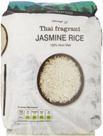


From smoky sate ayam to spicy tteokbokki and lacy dumplings, here’s our take on Asian street food dishes that are all ideal for sharing, snacking or relaxed weeknight meals









Takoyaki is a Japanese snack of crispy batter balls with soft centres filled with tako (octopus), pickled ginger and spring onions.
Prep time: 20 minutes
Cook time: 45-50 minutes
Serves: 4-6
For the sauce
4 tbsp Spinneysfood Tomato Ketchup
2 tbsp Worcestershire sauce
2 tbsp soya sauce
2 tsp Spinneysfood Fine Grain White Sugar
For the takoyaki
2 Spinneysfood Spring Onions
30g red pickled ginger
135g Nuchar Cooked Octopus Slices
80g Spinneysfood All-Purpose Flour
350ml dashi stock
1 tsp soya sauce
1 large Spinneysfood Organic Free-Range Egg
2-3 tbsp Spinneysfood Pure Sunflower Oil
To serve
3 tbsp Kewpie mayonnaise
Handful of bonito flakes
1 Combine the sauce ingredients in a mediumsized bowl, stirring to dissolve the sugar.
2 Finely chop the spring onion and pickled ginger. Slice the octopus into smaller pieces. In a medium-sized bowl, whisk the flour, dashi stock, soya sauce and egg to form a smooth batter. 3 Place a takoyaki tray over a mediumhigh heat. Fill a little oil in each mould and allow to heat. Fill each mould halfway with batter. Add a few octopus slices to the batter and top with the remaining batter, letting it flow out of the moulds and spill into the rest of the tray. Sprinkle 1⁄3 of the ginger and spring onions over the batter. Cook for a few seconds before using chopsticks to scrape around the circles, pushing the batter towards the centre of each ball (this will help you shape the ball once you turn it). Using a chopstick, press down into the centre of one takoyaki and slide it up the side of the mould, flipping it 90° while stuffing any excess batter back into the empty space. Add more oil, if needed. Repeat this with the remaining takoyaki. Fry each for 5-10 minutes. Each batch should take 15-20 minutes each. Repeat until the batter is finished. 4 Arrange the takoyaki on a plate and drizzle over a generous amount of the sauce, Kewpie mayonnaise and bonito flakes. 5 Serve immediately.
Bánh xèo cua is a crispy Vietnamese rice flour pancake filled with fresh crab meat, bean sprouts and herbs. These pancakes are usually served with lettuce and a tangy dipping sauce.
Prep time: 20 minutes
Cook time: 30 minutes
Makes: 8-10
For the pancake batter
120g rice flour
60g corn flour
¼ tsp Spinneysfood Fine Turmeric
500ml chilled sparkling water
4 tbsp coconut milk
1 tsp Spinneysfood Fine Sea Salt
2 Spinneysfood Spring Onions
For the filling
50g Spinneysfood Shiitake Mushrooms
900g fresh cooked crab meat or Spinneysfood
Cooked Prawns
200g mung bean sprouts
Spinneysfood Fine Sea Salt, to taste
Spinneysfood Black Pepper, freshly ground, to taste
100-150ml Spinneysfood Pure Sunflower Oil, for cooking

To serve
Handful of Crunchita lettuce
Handful of Spinneysfood Fresh Basil
Handful of Spinneysfood Fresh Mint
2-3 limes
1 In a bowl, whisk together the rice flour, corn flour, turmeric, sparkling water, coconut milk and salt until smooth. Finely chop the spring onions and stir them into the batter. Set aside to rest for 30 minutes. 2 Finely slice the mushrooms. 3 Heat a large pan with 2 tablespoons of oil over a high heat. Pour a ladleful of batter in the pan, tilting the pan to spread it evenly. Add a handful of the crab meat, mushrooms and mung beans on one half of the pancake. Cover with a lid and lower the heat. Cook until the edges start to lift and turn crispy, approx. 2-3 minutes. Remove the lid, then fold the other half over like an omelette. Remove from the pan and keep warm. Repeat with the remaining batter and fillings until you have about
8 pancakes. 4 Serve the bánh xèo cua hot with a dipping sauce (see page 63), lettuce leaves, basil, mint and lime wedges.
SPICY TTEOKBOKKI
This popular Korean street food is made with spicy rice cakes simmered in a bold, spicy-sweet gochujang sauce
to deliver a chewy, satisfying snack.
Prep time: 15 minutes
Cook time: 25 minutes
Serves: 2-4
For the rice cakes
4 Spinneysfood Spring Onions
226g Good Seoul Topokki Spicy Korean Rice Cake
250ml Spinneysfood Bottled Drinking Water
For the sauce
300ml Spinneysfood Bottled Drinking Water
4 pieces kombu
2-3 tbsp gochujang
2 tbsp soya sauce
3 tbsp Spinneysfood Fine Grain White Sugar
2 garlic cloves
1 tsp gochugaru or red chilli flakes
To serve
1 tsp Spinneysfood White Sesame Seeds
1 Separate the greens of the spring onions from the whites and set aside for later. Chop the whites into 3cm pieces. 2 Soak the rice cakes in warm water for 5 minutes then strain. In a medium-sized pot, combine the water and kombu and bring up to a boil before discarding the kombu. Add in the rest of the sauce ingredients and whisk together. Bring to a boil before adding the rice cakes and spring onions. Lower the heat and simmer uncovered for approx. 10 minutes or until the sauce has thickened to a glossy, thick glaze around the rice cakes. 3 Finely chop the spring onion greens.
4 Serve the tteokbokki topped with spring onion and sesame seeds.
When grilling the skewers, baste with extra kecap manis (Indonesian sweet soya sauce) for a caramelised glaze.
Prep time: 40 minutes (plus marination time)
Cook time: 10 minutes
Serves: 4-6
400g Spinneysfood Fresh Boneless Chicken Thighs
For the marinade
3 garlic cloves
2 medium shallots
1 tsp Spinneysfood Fine Sea Salt
½ tsp Spinneysfood Ground White Pepper
½ tsp Spinneysfood Ground Coriander
½ tsp Spinneysfood Ground Cumin
1 tsp chicken stock powder
1 tbsp Spinneysfood Pure Sunflower Oil
4 tbsp kecap manis (sweet soya sauce)
For the peanut sauce
1 small shallot
2 garlic cloves
1 lime
1 tbsp Spinneysfood Pure Sunflower Oil
100g raw peanuts
1-2 small red chillies
190ml Spinneysfood Bottled Drinking Water
20g palm sugar
1 lime leaf
1½ tbsp Mak Tok Malaysian Kecap Manis
¼ tsp Spinneysfood Fine Sea Salt
Equipment
Metal or bamboo skewers
To serve
1 lime
Use ready-made tortilla or burrito wraps instead of making your own crêpes.

Jianbing is a crispy, savoury Chinese street food crêpe topped with egg and filled with sweet hoisin sauce, chilli paste and crunchy fillings. Deep fry some wonton wrappers until golden to mimic the crunchy crackers.
Prep time: 15 minutes
Cook time: 20 minutes
Makes: 4-6
For the batter
300g Spinneysfood All-Purpose Flour
1 tsp Spinneysfood Fine Sea Salt
450ml Spinneysfood Bottled Drinking Water
For the filling
2 Spinneysfood Spring Onions
4 large Spinneysfood Organic Free-Range Eggs
3 tbsp toasted sesame seeds
80ml hoisin sauce
4 tbsp chilli sauce
8 crispy wonton crackers
Handful of Spinneysfood Fresh Coriander
1 Whisk together the flour and salt in a large bowl. Gradually add the water while stirring to form a smooth, thin batter. Let it rest for 10 minutes. 2 Meanwhile, thinly slice the spring onions. Heat a non-stick pan over a medium heat and brush lightly with oil. Pour a ladleful of batter into the pan, quickly spreading it into a thin, even layer like a crêpe. Crack 1 egg on top and lightly break it apart over the batter, using a spatula or chop sticks to spread it evenly. Sprinkle over the spring onions and sesame seeds. Once the egg is set, carefully flip the crêpe and cook for another 30 seconds.
3 Spread 2 tablespoons of hoisin sauce and 1 tablespoon of chilli paste over the surface of the crêpe, then place two crispy wonton crackers in the centre. Scatter over some coriander. Fold the long sides over the wonton crackers and then fold in half again through the middle. Repeat the process with the remaining batter. 4 Slice the jianbing in half and serve warm.


2 tbsp roasted peanuts
2 tbsp chilli paste or Sambal Oelek
1 Chop the chicken thighs into bite-sized cubes and place them in a resealable container.
2 To make the marinade, peel and roughly chop the garlic and shallots. Place all the dry spices, stock powder, aromatics, oil and sweet soya sauce in a food processor or blender and blitz until smooth. Pour the marinade over the cubed chicken and toss well to coat. Seal and refrigerate for 1-3 hours or overnight. 3 To make the peanut sauce, peel and roughly chop the shallot and garlic. Juice the lime. Heat the oil in a large wok over a medium heat and add the peanuts, shallots, garlic cloves and chillies. Stir constantly until golden brown, approx. 4-5 minutes. Using a slotted spoon, remove the peanut mixture from the wok and place on a paper towel-lined plate to drain and cool. Once cooled, place the peanut mixture and water in a food processor and blend until smooth. Return the peanut mixture to the wok along with the palm sugar, lime leaf, lime juice, kecap manis and salt. Simmer over a medium heat, stirring until the palm sugar has dissolved. 4 If you’re using bamboo skewers, soak them in cold water for 30 minutes before needed. 5 Thread the
marinated chicken pieces onto the skewers.
6 Heat a grill or flat griddle pan and cook the skewers for 3-4 minutes per side. Place half the peanut sauce on a flat plate and roll the skewers to coat them in the peanut sauce. Return them to the pan to caramelise and cook through.
7 Serve the sate ayam with lime wedges, extra peanut sauce, peanuts and chilli paste on the side.
This dish can easily be customised with dumplings of your choice. The secret to achieving the delicate, crispy lace is the starch slurry. Use a non-stick pan for the best results.
Prep time: 10 minutes
Cook time: 15 minutes
Serves: 4
For the dipping sauce
1 garlic clove
2 tbsp soya sauce
2 tbsp Spinneysfood Bottled Drinking Water
½ tbsp chilli oil
2-3 tsp Spinneysfood Extra Fine Caster Sugar
2 tbsp Chinese black vinegar or rice vinegar
2 tsp sesame oil
Lace dumplings with dipping sauce
For the dumplings
2 tbsp Spinneysfood Pure Sunflower Oil
12 Wang Korea Vegetable Dumplings
½ tsp Spinneysfood All-Purpose Flour
½ tsp corn flour
125ml Spinneysfood Bottled Drinking Water
Pinch of Spinneysfood Fine Sea Salt
1 To make the dipping sauce, mince the garlic and place in a medium-sized bowl with the remaining sauce ingredients. Stir to dissolve the sugar. Set aside for later. 2 Heat the oil in a large non-stick pan over a medium-high heat. Swirl the pan to coat. Arrange the dumplings in the pan, starting from the centre out. Cook the dumplings for 2-3 minutes until the bottoms are golden. 3 Whisk the flour, corn flour, water and salt together. Increase the heat to high and pour the slurry into the pan, tilting the pan so the slurry moves around the dumplings. Lower the heat to medium and cover the pan with the lid, cook for approx. 5 minutes or until the dumplings have cooked through and the lattice is golden. 4 Remove the lid from the pan and place a large plate over the pan, flip the pan over quickly to invert the dumplings onto the plate. 5 Serve the lace dumplings with the dipping sauce.
Customise your skewers with clementines, grapes or kiwi for different flavours.

Tanghulu is a traditional Chinese candied fruit snack, typically made by skewering fruit and coating it in a hard, glossy sugar shell. Variations use strawberries, grapes or star fruits, creating a crunchy, sweet and tart treat popular at street markets.
Prep time: 5 minutes
Cook time: 10 minutes
Serves: 10
For the tanghulu
450g Spinneysfood Premium Strawberries
4-6 wooden skewers
500g Spinneysfood Fine Grain White Sugar
250ml Spinneysfood Bottled Drinking Water
1 tbsp Spinneysfood White Sesame Seeds
For the ice bath
Handful of Spinneysfood Ice Cubes
250-500ml Spinneysfood Bottled Drinking Water
1 Rinse the strawberries and pat dry. Remove the stems and thread onto a wooden skewer, leaving enough room for you to hold while dipping. 2 Fill a tall jug (enough to accommodate the skewers) with ice and water and place it next to the stove. 3 Add the sugar and water to a wide and flat pan, whisking until the sugar has dissolved. Bring to a boil over a medium-high, swirling the pan to distribute the heat. Continue cooking until the sugar syrup reaches 150°C on a sugar thermometer, approx. 5-10 minutes. To check for a hard crack stage, drizzle some of the sugar into the ice bath to check if it sets hard. Once the sugar has reached the correct temperature, remove the pan from the heat. 4 Tilt the pan slightly and hold at an angle then dip each skewer into the sugar syrup, turning them to coat fully. Immediately submerge the skewers in the iced water for a few seconds and then place them on a wire rack to dry. If the sugar becomes too thick, gently heat it on low until it
becomes hot again but it’s best to work quickly. 5 Sprinkle over the sesame seeds and serve the skewers immediately.
Leche flan is a popular silky Filipino caramel custard made with egg, condensed milk and milk, traditionally steamed for a smooth, melt-in-your-mouth texture.
Prep time: 20 minutes (plus chilling time)
Cook time: 1 hour
Serves: 6
For the caramel
150g Spinneysfood Fine Grain White Sugar
For the flan
12 large Spinneysfood Organic Free-Range Eggs
1 x 385g tin sweetened condensed milk
400ml double cream
250ml Spinneysfood Fresh Full-Fat Milk
½ tsp vanilla powder
For the crunchy sesame praline
75g Spinneysfood Fine Grain White Sugar
2 tbsp Spinneysfood Bottled Drinking Water
1 tbsp toasted sesame seeds
1 To make the caramel, add the sugar to a small saucepan over a medium heat. Simmer until the mixture turns a deep amber colour. Immediately pour the caramel into dariole moulds or ramekins, tilting the moulds around to coat the bottoms evenly. Set aside to harden. 2 Preheat the oven to 120°C, lowest gas mark. 3 To make the flan, separate 8 egg yolks from the whites. In a large bowl, whisk the egg yolks and 4 remaining whole eggs until smooth. Add the condensed milk, double cream, milk and vanilla powder. Gently whisk until smooth and combined, avoid creating too many air bubbles. Strain the mixture and use a tablespoon to scoop out any excess bubbles.
4 Pour the custard into the caramel-coated moulds. Cover each mould with foil. Place the moulds in a deep baking dish and fill the dish with hot water until it reaches at least halfway up the sides. Bake for 3 hours or until set but slightly jiggly in the centre. Remove from the oven and let cool to room temperature before refrigerating overnight. 5 To make the praline, line a baking sheet with baking paper and set aside. In a small saucepan, heat the sugar and water over a medium heat until it turns golden brown. Stir in the toasted sesame seeds, then immediately pour onto the lined baking sheet, spreading it thinly. Let it cool completely before breaking into shards.
6 Dip the moulds into hot water for 3-5 seconds before inverting them onto a plate, tapping the sides to release them. The caramel will coat the flan. 7 Decorate the flan with sesame praline shards then serve.
From dumplings and instant


to ready-made





find a variety of street-food style items in stores.





Explore the delicious world of banchan – Korean BBQ’s essential accompaniments. From pickled salads to pancakes, these fl avour-packed dishes are just as vital as the meat

Gamja jorim, or soy-braised potatoes, are a popular banchan at Korean BBQ. Their sweet-savoury caramelised glaze and tender bite complement the smoky, charred flavours of grilled meats.
Prep time: 5 minutes
Cook time: 30 minutes
Serves: 4
1 garlic clove
2 tbsp Spinneysfood Pure Sunflower Oil
450g baby potatoes
3 tbsp soya sauce
3 tbsp Spinneysfood Acacia Honey
1 tsp toasted sesame oil
To serve
2 Spinneysfood Spring Onions
1 tbsp toasted sesame seeds
1 Mince the garlic. 2 Heat the oil in a large frying pan over a medium heat and add the potatoes. Cover and cook for approx. 20 minutes until fully cooked. Toss the pan every 5 minutes to ensure the potatoes don’t burn and lower the heat if they are browning too fast.
3 Combine the remaining ingredients in a small bowl before adding them to the pan. Stir well to coat the potatoes. Increase the heat to medium and sauté for 5 minutes, or until the sauce has reduced and the potatoes are glossy.
4 Meanwhile, finely slice the spring onion greens. 5 Once the potatoes are cooked, transfer to a serving dish. Sprinkle over the sesame seeds and spring onion greens before serving.

Prep time: 30 minutes
Serves: 4
200g Spinneysfood Spring Onions
1 garlic clove
1 tbsp Spinneysfood White Sesame Seeds
2 tbsp soya sauce
1 tbsp Spinneysfood Light Muscovado Sugar
1 tbsp sesame oil

2 tsp Spinneysfood Chilli Flakes or gochugaru
2 tsp Spinneysfood Organic White Vinegar
1 Chop the spring onions in half widthways, then finely slice lengthways to form thin strands. Place the spring onions in a bowl of iced water for 15 minutes. 2 Mince the garlic. Toast the sesame seeds in a dry pan. 3 Combine the garlic, sesame seeds, soya sauce, sugar, sesame oil, chilli flakes and vinegar in a large bowl. 4 Drain the spring onions and pat dry. 5 Toss with the dressing and serve.
Placing the spring onion strips into ice water allows them to curl up and hold more of the dressing.

For an extra crunchy pancake, use ice-cold water in the batter and spread it thinly in the pan. Cook over a medium-high heat until deep golden brown and crisp on both sides.
The refreshing flavours and crunchy texture of this spicy cucumber salad (see image on page 108) make it the ideal accompaniment to heavier grilled meats.
Prep time: 40 minutes
Serves: 6
For the cucumber
2 large Spinneysfood Organic Cucumbers
2 tsp Spinneysfood Fine Sea Salt
For the dressing
2 tbsp rice vinegar
2 tsp Korean red pepper powder
2 tbsp gochujang
2 tsp Spinneysfood Fine Grain White Sugar
2 garlic cloves
2 tsp toasted sesame seeds
2 tsp toasted sesame oil
1 tbsp fish sauce
1 Finely slice the cucumber in half and then into strips at a diagonal. Place them in a mediumsized bowl along with the salt. Toss well to combine and set aside for 30 minutes to draw out the excess moisture. 2 In a small bowl, combine the dressing ingredients and set aside. 3 Drain any excess liquid from the cucumbers and rinse thoroughly. Add the dressing to the cucumbers and toss well to combine. 4 Serve immediately.
Japchae (see image on page 110) is a popular Korean stir-fried noodle dish made with chewy sweet potato glass noodles, vegetables and a sweet soya-based sauce.
Prep time: 20 minutes
Cook time: 25 minutes
Serves: 4
For the beef
300g Spinneysfood Organic Beef Fillet
1 garlic clove
2 tsp soya sauce
2 tsp Spinneysfood Fine Grain White Sugar
½ tsp Spinneysfood Black Pepper, freshly ground
For the noodles and vegetables
1 onion
3 Spinneysfood Spring Onions
200g Spinneysfood Shiitake Mushrooms
2 carrots
1 Spinneysfood Red Capsicum
250g mung bean noodles
4 tbsp Spinneysfood Pure Sunflower Oil
300g Spinneysfood Organic Baby Spinach
2 tbsp Spinneysfood White Sesame Seeds
For the noodle dressing
1 small garlic clove
4 tbsp soya sauce
2 tsp Spinneysfood Fine Grain White Sugar
2 tbsp sesame oil
1 Slice the beef into thin, long pieces. Place the meat in a medium-sized bowl. 2 Crush the garlic and add to the beef along with the remaining ingredients. Mix to coat every piece and set aside for 15-20 minutes. 3 Finely slice the onion, spring onion and mushrooms. Julienne the carrots and capsicum. The veggies should be similar in size so they cook evenly. 4 Mix the noodle dressing ingredients in a large mixing bowl and set aside for later. 5 Soak the mung bean noodles in lukewarm water for 5-8 minutes before boiling for exactly 1 minute. Drain and rinse briefly under cold water to stop the cooking process. Add the noodles to the dressing bowl, but don’t mix.
6 Heat 2 tablespoons of the oil in a large non-stick pan over a high heat. Stir fry the onion, spring onion whites and shiitake mushrooms for 3-4 minutes or until slightly softened. Transfer over the noodles. 7 Heat 1 tablespoon of oil in the same pan over a high heat. Stir-fry the carrots and capsicum for 1-2 minutes, then add the spinach and spring onion greens. Stir-fry until the spinach wilts then transfer to the noodle bowl, but do not mix. 8 In the same pan, heat the remaining oil over a high heat. Stir-fry the beef until lightly golden and just cooked through. It should caramelise but still be tender. Transfer the meat to the noodle bowl. Add ¾ of the sesame seeds and toss to coat the veggies and beef. 9 Serve topped with the remaining sesame seeds.
Prep time: 15 minutes
Cook time: 10 minutes
Serves: 2
For the dipping sauce
1 tbsp soya sauce
2 tsp black vinegar
1 tsp chilli flakes or gochugaru
1 tsp toasted sesame seeds
1 tsp Spinneysfood Organic Natural Honey
For the yachae jeon
2 Spinneysfood Spring Onions
1 small jalapeño
1 small sweet potato
2 small courgettes
1 small leek
2 Spinneysfood Shiitake Mushrooms
60g Spinneysfood All-Purpose Flour
20g corn starch
½ tsp Spinneysfood Fine Sea Salt
120ml Spinneysfood Bottled Drinking Water
4 tbsp Spinneysfood Pure Sunflower Oil
1 In a small bowl, combine the sauce ingredients. Set aside for later. 2 Chop the spring onions into 2cm pieces and finely slice the jalapeño. Slice the sweet potato into matchsticks and julienne the courgettes, leek and mushrooms. Place all in a large bowl. Add the flour, corn starch and salt, then the cold water. Using your hands, mix thoroughly until a thin batter forms, being careful not to break the vegetables. 3 Heat 2 tablespoons of the oil in a large non-stick pan over a medium-high heat and swirl to coat the base of the pan. Pour all the batter into the pan and spread it into an even layer. Cook for approx. 5 minutes or until golden and crisp on the bottom. Carefully flip the pancake over. Drizzle the remaining oil around the edges of the pancake. Lift one side of the pancake slightly to allow the oil to flow underneath. Fry for a further 3-4 minutes or until golden and crisp. 4 Transfer to a large serving plate and cut into bite-sized pieces. Serve with the dipping sauce.
We stock a selection of fresh beef and chicken that are ideal for Korean BBQ.












Crunch is king in Asian cuisine. From crispy duck to punchy pickles or peanut brittle, Korean, Thai, Chinese and Filipino dishes thrive on texture and contrast


Prepare all the different components for the larb with Crunchita lettuce in advance and store them in the refrigerator separately. Assemble when you are ready to serve.


USING CRISPY DUCK SKIN AND CHILLI CRUNCH TO GIVE THE PANCAKES AN EQUALLY SATISFYING CRUNCH IN LESS TIME
KOREAN POTATO CRISPY CORNDOGS
A crispy, golden take on classic Korean corndogs, these are coated in a light fluffy dough, rolled in crunchy potatoes and Panko, then fried to perfection.
Prep time: 45 minutes
Cook time: 10 minutes
Makes: 6
For the dough
500ml lukewarm Spinneysfood Bottled Drinking Water
50g Spinneysfood Fine Grain White Sugar
15g dry instant yeast
450g Spinneysfood All-Purpose Flour
1 tsp Spinneysfood Fine Sea Salt
For the corndogs
450g Spinneysfood Thin Cut Fries
65g Spinneysfood All-Purpose Flour
150g Panko breadcrumbs
4 beef or chicken hotdogs
200g Spinneysfood Mild Cheddar Cheese
2L Spinneysfood Pure Sunflower Oil
To serve
Spinneysfood Tomato Ketchup Mustard
1 In a medium-sized bowl, mix the lukewarm water, sugar and yeast. Stir until dissolved, then allow to sit for 5 minutes until frothy. Sift the flour and salt into a large mixing bowl. Whisk together until well combined. Pour the yeast mixture into the flour mixture and whisk until a sticky dough forms. Cover with a warm towel and allow to proof in a warm place for 30 minutes, or until doubled in size. 2 Dice the thin cut fries into ½cm x ½cm cubes. Transfer to a tray and dust with the flour. Prepare a separate tray with the Panko breadcrumbs. 3 Preheat a deep fryer to 180°C. 4 Slice the hotdogs into four pieces. Slice the cheese into equal-sized cubes to match the sausages. Skewer a piece of sausage onto a wooden skewer, followed by a cube of cheese, and repeat until each skewer has 2 blocks of cheese and 2 blocks of hotdog. Dip the top of the skewers in the risen dough and twist the skewer, slowly wrapping a layer of dough over the skewer. Roll the skewer until the ingredients
are completely coated. Lay the corndog on the diced potatoes, rolling to ensure it’s fully coated. Sprinkle Panko breadcrumbs over any exposed dough to fully coat the corndog. Repeat the process to assemble the remaining corndogs. 5 Fry the corndogs in batches of two for 3-4 minutes per side, or until golden brown and crispy. Drain on paper towels. 6 Serve hot with a drizzle of ketchup and mustard.
Prep time: 20 minutes
Cook time: 10 minutes
Serves: 4
For the dressing
3 tbsp Thai sticky rice
3 limes
1 tbsp Spinneysfood Chilli Flakes
½ tbsp palm sugar
1 tbsp fish sauce
For the larb
2 tsp Spinneysfood Pure Sunflower Oil
500g Spinneysfood Chicken Mince
Spinneysfood Fine Sea Salt, to taste
3 small shallots
2 Spinneysfood Spring Onions
1 lemongrass stalk
Handful of Spinneysfood Fresh Coriander
Handful of Spinneysfood Fresh Mint
Handful of Spinneysfood Fresh Basil
To serve
1 Spinneysfood Organic Cucumber
200g Crunchita lettuce
Handful of Spinneysfood Fresh Coriander
Handful of Spinneysfood Fresh Mint
Handful of Spinneysfood Fresh Basil
20g lotus chips
1 To make the dressing, place a dry pan over a medium heat. Add the Thai sticky rice and toast until golden brown and fragrant, approx. 8-10 minutes. Transfer to a mortar and pestle, or spice grinder and grind into a fine powder.
2 To make the larb, heat the oil in the same pan over a medium heat. Add the chicken mince and
season with salt. Cook, stirring continuously, to break up any clumps, until the chicken is fully cooked but not browned approx. 5 minutes. Transfer to a large mixing bowl and cool slightly.
3 Peel and finely slice the shallots and spring onions. Remove the tough outer layers of the lemongrass and finely chop the tender inner core. Finely slice the herbs on a diagonal. Add the shallots, spring onions, lemongrass and herbs to the large bowl with the warm chicken. 4 Juice the limes into a small bowl. Add the toasted rice flour, chilli flakes, palm sugar and fish sauce, stirring until the sugar is dissolves. Pour the sauce over the chicken and toss everything together, ensuring the flavours are well distributed. 5 Slice the cucumber into rounds and arrange it on a plate with the Crunchita lettuce leaves, cucumber and herbs. Serve with crunchy lotus chips for extra texture.
CRISPY DUCK SKIN AND CHILLI CRUNCH ON PANCAKES
A twist on classic Peking duck pancakes, the chilli crunch in this recipe is made with duck fat for heightened flavour.
Prep time: 25 minutes
Cook time: 30 minutes
Makes: 300g
For the duck
2 duck breasts
4 garlic cloves
5cm piece fresh ginger
12 Sichuan peppercorns
6 Spinneysfood Cardamom Pods
4 tbsp rendered duck fat
150ml Spinneysfood Pure Sunflower Oil
2 Spinneysfood Cinnamon Sticks
5 star anise
4 dried chillies
2 tbsp Spinneysfood Coriander Seeds
For the chilli crunch
40g roasted peanuts
1 tsp Sichuan peppercorns
1 tbsp chilli flakes
1 tsp gochugaru or Spinneysfood Chilli Powder
2 tbsp Spinneysfood White Sesame Seeds
2 tbsp Spinneysfood Fine Grain White Sugar
1 tbsp Spinneysfood Fine Sea Salt
2 tbsp soya sauce
1 tbsp black vinegar
30g Waitrose Cooks’ Ingredients Crispy Fried Onions
2 tbsp sesame oil
To serve
4 Spinneysfood Spring Onions
6 Chinese-style pancakes
100g Hoisin sauce
1 Score the skin of the duck breasts in a crisscross pattern. Place skin-side down in a cold pan and cook over a medium-low heat, rendering the fat until the skin is deeply golden and crispy approx. 8-10 minutes. Flip the breast and cook for a further 3-5 minutes, or until the meat is cooked to your liking. Remove the duck breasts from the pan and rest for 10 minutes. Remove the crispy skin from the duck and roughly chop. Set aside. Save the rendered duck fat from the pan, you should get approx. 4 tablespoons. 2 Finely slice the garlic and roughly chop the ginger. Lightly crush the Sichuan peppercorns and cardamom pods. In a saucepan placed over a low heat, combine the rendered duck fat, sunflower oil, garlic, ginger, cinnamon sticks, star anise, Sichuan peppercorns, cardamom, dried chillies and coriander seeds. Simmer for 20 minutes over low heat stirring occasionally and allow the aromatics to infuse into the oil.
3 Meanwhile, finely chop the peanuts and crush the Sichuan peppercorns in a pestle and mortar. In a separate bowl, combine the chilli flakes, gochugaru, crushed Sichuan peppercorns, chopped peanuts, sesame seeds, sugar, salt, soya sauce and black vinegar. Strain the hot infused oil over the mixture, stirring together before allowing to cool completely. 4 Once cooled, stir in the crispy onions, sesame oil and the reserved chopped crispy duck skin. This can be stored in a sterilised jar for up to 3 months and enjoyed as a condiment over many dishes. 5 Thinly slice the spring onions and the duck breasts. Warm the pancakes then spread a spoonful
of hoisin sauce over each one. Top with the spring onions and sliced duck and finish with a spoonful of crispy duck skin chilli crunch.
Prep time: 10 minutes
Cook time: 15 minutes
Makes: 300g
200g Spinneysfood Fine Grain White Sugar
4 tbsp Spinneysfood Bottled Drinking Water
1 tbsp Spinneysfood Salted Butter
½ tsp Spinneysfood Fine Sea Salt
200g roasted peanuts or almonds
1 Line a baking tray with greased baking paper. 2 In a saucepan, combine the sugar and water over a medium heat, swirling the pan (do not stir) until the sugar dissolves and turns an amber colour. Remove from the heat and quickly whisk in the butter and salt. Add the roasted peanuts, mixing to coat them evenly. 3 Immediately pour it onto the prepared tray, before it cools and spread it into an even layer. 4 Let it cool completely before breaking into pieces.
This twist on the classic Filipino turon adds a nutty layer of peanut brittle for extra sweetness and texture.
Prep time: 15 minutes
Cook time: 10 minutes
Makes: 12

For the turon
3 ripe bananas
1 large Spinneysfood Organic Free-Range Egg
140g store-bought or home-made peanut or almond brittle 12 spring roll wrappers/lumpia
2L Spinneysfood Pure Sunflower Oil
For the caramel coating
150g Spinneysfood Fine Grain White Sugar
50g Spinneysfood Salted Butter
120ml Spinneysfood Bottled Drinking Water
1 Preheat a deep fryer to 180°C, or heat the oil in a pan over a medium heat. 2 Peel and slice the bananas lengthways, then in half vertically to create four equal pieces from each banana. Crack the egg into a bowl and whisk it. Set the bowl aside. Place a spring roll wrapper on a clean surface. Place one quarter of a banana on it and sprinkle crushed peanut brittle over it. Fold the bottom part of the wrapper over the filling, fold in the sides and roll tightly. Seal the edge with some egg. Repeat with the remaining bananas and wrappers. 3 Fry the turon in batches, seam-side down, until golden and crispy, approx. 3-4 minutes per side. Drain on a cooling rack.
4 In a separate pan, combine the sugar, butter and water. Simmer over a low heat until it turns into a caramel syrup. 5 Quickly roll each turon in the caramel, ensuring all sides are coated. Transfer to a plate and let the caramel harden and the turon cool slightly before serving.
6 Serve with extra peanut brittle sprinkled on top.
Add crunch to your dishes with the ingredients available in store.







Floral, fruity and deeply aromatic, these drinks embrace trending fl avours – pansy blossom tea, strawberry lemon milk, cherry cloud latte and sesame-infused coffee jelly
Merging the rich, bitter flavours of Vietnamese coffee with the sweet and tangy notes of cherry chocolate is a delicious twist on the traditional. To achieve the most genuine Vietnamese coffee taste, opt for medium to dark roast Robusta beans.
Prep time: 10 minutes
Serves: 2
150ml whipping cream
2 tbsp Waitrose Cherries and Berries Cordial
4 tbsp sweetened condensed milk
500g Spinneysfood Pure Ice Cubes
300ml strong coffee
Nestle Chocolatey Topping Squeezy Bottle, for drizzling Cocoa powder, for dusting
Spinneysfood Premium Cherries, for decorating
1 In a mixing bowl, whisk the cream and cordial until soft peaks form. Set aside. 2 Divide the condensed milk evenly between the two tall glasses. Fill with ice cubes. 3 Slowly pour the cooled coffee over the ice cubes. Spoon or pipe the whipped cherry cream over the cold brew
layer, ensuring it sits on top like a cloud. Drizzle the chocolate sauce over the cherry cream and dust lightly with cocoa powder. 4 Decorate with fresh cherries and serve.
Infusing the sugar with the natural oil from the lemon zest gives this drink a bright, zesty flavour, which enhances the sweetness of the strawberries.
Prep time:10 minutes
Cook time: 2 minutes
Serves: 4
400g Spinneysfood Scottish Strawberries
4 tbsp Spinneysfood Extra Fine Caster Sugar
4 tbsp Spinneysfood Fine Grain White Sugar 1 lemon
400ml Waitrose Essential Coconut Milk
12g Sweet Dough Things Pink Candy Floss
12 Dr. Oetker Wafer Daisies
1 Set 6 strawberries aside. Remove the tops from the remaining strawberries and place them in a blender or food processor with the caster

sugar. Blitz until smooth. Transfer to a small pot and simmer over a low heat for 1 minute. Allow to cool completely. 2 Place the white sugar in a bowl and zest the lemon over. Using your fingertips, rub the zest into the sugar. Place the sugar in a flat dish. 3 Quarter the lemon and run it around the rim of 4 tumblers. Press the rims of the glasses into the lemon sugar. 4 Thinly slice 2 strawberries and arrange the slices around the bottoms of the glasses. Divide the strawberry purée between the glasses. Slowly pour the coconut milk on top of the purée so the two don’t mix. 5 Decorate each glass with the remaining strawberries, candy floss and wafer daisies. 6 Serve immediately.
This twist on jelly coffee has a drop of sesame oil and a fluffy tahini cream, which add a toasty depth to the jelly.
Prep time: 5 minutes (plus setting time)
Serves: 2
70g Spinneysfood Dark Muscovado Sugar 3 tsp gelatine

250ml freshly brewed coffee
250ml cold Spinneysfood Bottled Drinking Water
250ml whipping cream
2 tbsp tahini
1 tbsp Monin Caramel Syrup
Pinch of Spinneysfood Fine Sea Salt
½ tsp toasted sesame oil
Spinneysfood White Sesame Seeds, for sprinkling
1 Stir the sugar and gelatine into the hot, freshly brewed coffee until dissolved completely. Add the water. Pour into a standard 21cm x 11cm loaf tin. Cover and refrigerate until set.
2 In a medium-sized bowl, whisk the cream, tahini, caramel syrup, salt and sesame oil until soft peaks form. 3 Unmould the jelly onto a chopping board and cut into 1cm cubes. Divide the coffee jelly cubes between two large cups.
4 Top with the tahini cream and sprinkle over some sesame seeds before serving.
This is a soothing tea blend with a delicate floral aroma and beautiful colour.
Prep time: 5 minutes
Cook time: 25 minutes
Serves: 2
12g Spinneysfood Edible Purple Viola Flowers, plus extra for serving
750ml Spinneysfood Bottled Drinking Water
2 tbsp Spinneysfood Organic Natural Honey, to taste 25g boba tapioca pearls (quick-cooking)
500g Spinneysfood Pure Ice Cubes
1 Place the flowers in a large teapot or jug. Bring 500ml of water to a boil and pour over the flowers. Cover and allow to steep for 20 minutes. Strain through a sieve and stir in the honey to taste. Set aside to cool. 2 Meanwhile, prepare the boba. In a small saucepan, bring the remaining water to a boil and add the boba pearls. Cook according to package instructions or until the boba float. Scoop them out and allow to cool. 3 When ready to serve, spoon the boba into two glasses. Add the ice cubes. Pour over the iced tea and decorate with more viola flowers. 4 Serve immediately.

Make your own viola ice by placing viola flowers in an ice cube tray. Fill it with just enough water to cover the flowers but don’t fill up the individual moulds. Freeze until firm, then top up with more water. Freeze again. For crystal-clear ice, use cooled, pre-boiled water.

If drinking matcha alone, always choose ceremonial or premium-grade products for the best experience. Culinary-grade matcha is ideal for recipes where other ingredients balance its stronger flavour.
Master matcha with our ultimate guide. From understanding grading to brewing to making cookies, sandos and drinks – discover just how versatile it can be
MATCHA IS A SHADE-GROWN TEA , WHICH ENCOURAGES THE BUSH TO PRODUCE MORE AMINO ACIDS AND SWEETNESS. THE LEAVES SHOULD BE VIBRANT, BRIGHT GREEN WITH A RICH JADE OR EMERALD HUE, INDICATING HIGH-QUALITY AND FRESH YOUNG TEA LEAVES.
CEREMONIAL-GRADE MATCHA
This is the highest grade of matcha made from the youngest tea leaves. The leaves are carefully stone-ground and the resultant matcha has a vibrant, deep green hue to its high chlorophyll content. It is smooth, naturally sweet, with a mild umami taste and no bitterness. Whisk it with hot water to prepare traditional tea (usucha or koicha).
PREMIUM-GRADE MATCHA
Slightly lower in quality than its ceremonial counterpart, this matcha is still finely milled and has a bright green colour. It has a mildly grassy flavour with some sweetness and umami notes. Use it to make lattes, iced matcha drinks and mixed beverages.
CULINARY-GRADE MATCHA
Since it is made from older tea leaves this matcha is a duller green. It is earthy, slightly bitter with robust green tea notes. Use it for making baked goods, smoothies and savoury dishes.
Never use boiling water (100°C) for matcha – it burns the tea, making it bitter. Always aim for 80°C to preserve its delicate flavour.

Matcha must be brewed correctly to ensure a smooth, creamy and lump-free drink.
TRADITIONAL USUCHA (THIN MATCHA)
• Light & refreshing
• Best for everyday drinking 1 tsp (2g) ceremonial-grade matcha 70ml hot water (not boiling, around 80°C)
Whisk vigorously in a zig-zag motion using a bamboo whisk (chasen).
KOICHA (THICK MATCHA)
• Intense & bold
• Best for special tea ceremonies 2 tsp (4g) ceremonial-grade matcha 50ml hot water (80°C)
Whisk gently into a thick paste for a rich umami flavour.
ICED MATCHA
• Refreshing & cooling
• Best for summer drinks
1 tsp (2g) premium matcha 100ml cold water or milk
Shake in a bottle or whisk with an electric frother for a smooth blend. Serve over ice.
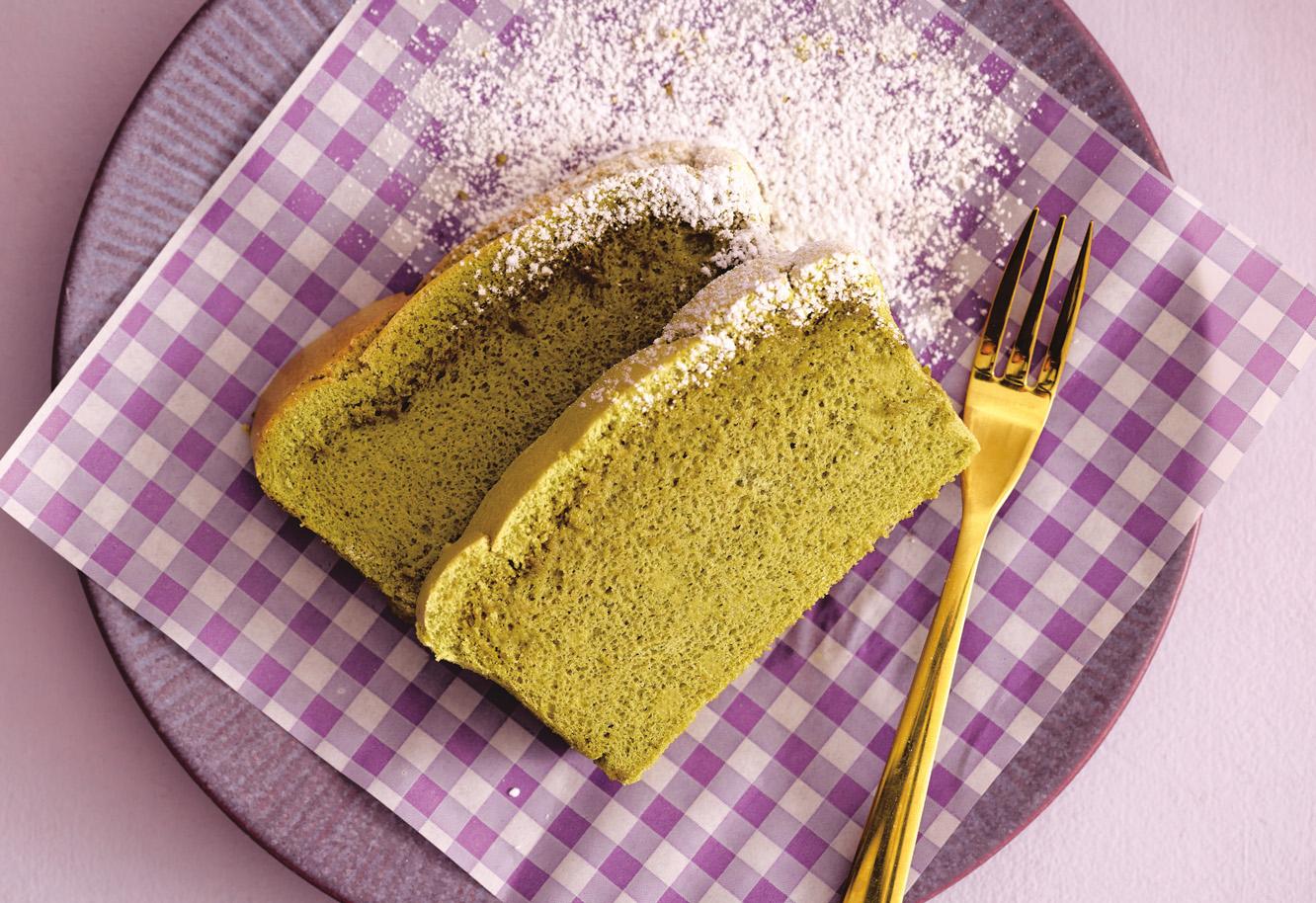

The traditional matcha whisk, known as a chasen, is a crucial tool in matcha preparation. Made from bamboo, it breaks up clumps and creates a frothy layer of foam. If you don’t have a chasen, an electric milk frother can produce a similar effect, ensuring you’re always prepared for a perfect matcha experience.
ALWAYS SIFT MATCHA
Matcha clumps easily, so it’s always recommended to sift it through a fine-mesh sieve before adding water. This ensures even dispersion in the liquid and prevents lumps.
WHISKING TECHNIQUE
For a perfect frothy top, whisk vigorously in a zig-zag motion rather than in circles. This allows air to incorporate and creates a smooth, creamy foam.
This is a delicate and fluffy Japanese sponge cake infused with matcha and baked low and slow to achieve a perfectly soft texture.
Prep time: 20 minutes
Cook time: 1 hour 10 minutes
Serves: 8
5 large Spinneysfood Organic Free-Range Eggs
3 tbsp Spinneysfood Pure Sunflower Oil
50g Spinneysfood All-Purpose Flour
2 tbsp corn starch
1 tbsp culinary-grade matcha
50ml Spinneysfood Full-Fat Fresh Milk
1 tsp lemon juice
50g Spinneysfood Extra Fine Caster Sugar
1 tsp vanilla extract
Spinneysfood Super Fine Icing Sugar, for dusting
1 Preheat the oven to 145°C, gas mark 2. Line a 27cm x 14cm loaf pan with baking paper. Place a deep roasting tin half-filled with water in the oven to preheat while you prepare the cake. 2 Separate 4 egg yolks from the whites and refrigerate the latter. 3 Heat the oil in a small saucepan or in the microwave to 70°C. Pour into a mixing bowl. Sift together the flour, corn starch and matcha, then whisk them into the warm oil. Slowly add the milk, stirring until smooth. Add the egg yolks and remaining whole egg, mixing gently until just combined. Be careful not to overmix. 4 In a separate bowl, whisk the chilled egg whites with lemon juice until soft peaks form, then gradually add the sugar while whisking until a thick meringue forms. 5 Using a spatula to maintain the airiness, gently fold the meringue into the matcha batter in three additions. Pour the batter into the loaf pan, smoothing the top. Place the pan in the deep roasting tray in the oven. 6 Bake for 65-70 minutes until a toothpick inserted in the centre comes out clean. Remove the cake from the oven and immediately transfer it to a cooling rack to prevent excess moisture buildup. 7 Let it cool before slicing, then dust with icing sugar and serve.
These delicate matcha shortbread cookies are sandwiched together with a creamy, ube-infused white chocolate ganache.
Prep time: 1 hour 15 minutes (plus chilling time)
Cook time: 10 minutes
Makes: 12 sandwich cookies
For the matcha cookies
125g Spinneysfood Salted Butter, softened 2 tbsp Spinneysfood Super Fine Icing Sugar
1 tsp culinary-grade matcha
120g Spinneysfood All-Purpose Flour
1 tbsp corn starch
For the ube white chocolate ganache
100g white chocolate
50ml cream
½ tsp ube powder or strained blackberry jam
1 Line a baking sheet with parchment paper.
2 Place the butter and icing sugar in a large bowl. Using an electric mixer, beat until light and fluffy. Sift together the matcha, flour and corn starch, then gradually mix them into the butter mixture until a soft dough forms. Add a little extra flour, if needed. 3 Roll out the dough to ½cm thickness on a lightly floured surface. Using a cookie cutter, cut out shapes and place them on the baking sheet. Place the cookies in the refrigerator for 30 minutes to chill, so they maintain their shape while baking. 4 Preheat the oven to 180°C, gas mark 4. 5 Bake the cookies for 10-12 minutes or until the edges turn lightly golden. Remove from the oven and let them cool completely before filling. 6 To make the ganache, chop the white chocolate and place it in a heatproof bowl. Heat the cream and ube powder (or strained blackberry jam) until steaming, then pour over the chocolate. Allow it to sit for 5 minutes before stirring until smooth. Allow the ganache to set at room temperature, then whisk for approx. 1-2 minutes until light and fluffy.
7 Assemble the cookies by spreading a generous layer of ganache on one cookie and topping it with another cookie to create a sandwich.
We stock a variety of matcha powders, teas, beverages and desserts in stores.






A fluffy matcha omelette layered with creamy Japanese mayo and baby spinach served between soft milk bread.
Prep time: 15 minutes
Cook time: 10 minutes
Serves: 2
For the matcha omelette
4 large Spinneysfood Organic Free-Range Eggs
1 tsp matcha powder
½ tsp Spinneysfood Fine Sea Salt
¼ tsp Spinneysfood Ground White Pepper
1 tsp mirin
1 tbsp Spinneysfood Unsalted Butter
For the sando
4 slices Japanese milk bread or brioche, crusts removed
2 tbsp Japanese mayonnaise
1 tsp yuzu juice or lemon juice
1 handful of Spinneysfood Organic Baby Spinach
1 Preheat the oven grill to 220°C. 2 Separate the egg yolks from the whites. Whisk the matcha, egg yolks, salt, pepper and mirin in a bowl. 3 Beat the egg whites until soft peaks form. Fold the whites gently into the yolk mixture. 4 Heat the butter in a non-stick pan. Pour in the egg mixture and cover with a lid. Cook on a low heat for 5 minutes, remove from the stovetop and place under the grill until fully

set. 5 Allow to cool completely, then cut into shapes to fit the sandos. 6 Mix the mayonnaise with the yuzu juice. Spread the yuzu mayo on the bread slices. Add the spinach, then place the matcha omelette on top of two slices. Close the sandwiches with the remaining slices. 7 Wrap in parchment paper, slice in half and serve.
A refreshing, creamy matcha drink balanced with vanilla and a hint of sea salt.
Prep time: 5 minutes
Cook time: 5 minutes
Serves: 2
1 vanilla bean
250ml Spinneysfood Full Fat Fresh Milk or dairy alternative
Pinch of Spinneysfood Fine Sea Salt
3 tsp ceremonial-grade matcha
120ml warm Spinneysfood Bottled Drinking Water
1 Split the vanilla bean and scrape out the seeds. Mix them with the milk and salt in a bowl and set aside. 2 Sift the matcha into a bowl and pour over the warm water (80°C). Whisk vigorously in a zig-zag pattern for 1-2 minutes until frothy. 3 Fill two glasses with ice and pour in the vanilla milk. Top with the prepared matcha to create a vibrant green layer. 4 Serve immediately.
• STORE IN AN AIRTIGHT CONTAINER Matcha absorbs moisture and odours quickly.
• KEEP AWAY FROM LIGHT AND AIR Exposure to oxygen and sunlight causes oxidation, which turns matcha dull and bitter.
• REFRIGERATE IF NECESSARY If you live in a hot or humid climate, keeping matcha in the fridge helps preserve its freshness.
• USE WITHIN 4-8 WEEKS Once opened, matcha is best consumed within one to two months for optimal flavour.

You’ve seen them all over your social feeds – now it’s time to bring them to your kitchen. From viral sensations to modern takes on beloved favourites, these desserts are here to become your next obsession. Are you ready to take a bite?
Mochi donuts are a fusion of Japanese mochi and American-style donuts with a chewy, bouncy consistency popular in East Asian sweets. Originating in Hawaii and influenced by pon de ring donuts in Japan, these treats have gained fame for their light, crisp exterior and stretchy interior. Their versatility allows for a variety of colourful glazes, often inspired by matcha, black sesame, or yuzu.
Prep time: 15 minutes
Cook time: 10 minutes
Serves: 8
For the donuts
2 tbsp Spinneysfood Salted Butter
250g glutinous rice flour
180ml Spinneysfood Fresh Full-Fat Milk
50g Spinneysfood Extra Fine Caster Sugar
1 tsp Spinneysfood Baking Powder
1 large Spinneysfood Organic Free-Range Egg Spinneysfood Pure Sunflower Oil, for frying
For the glaze
500g Spinneysfood Super Fine Icing Sugar
½ tsp vanilla extract
3-4 tbsp Spinneysfood Fresh Full-Fat Milk
Yellow, pink, and green food colouring
For the decoration
Spinneysfood Edible Flowers
1 lemon
Crushed freeze-dried raspberries
Slivered pistachios
1 Cut out eight 10cm x 10cm squares from baking paper. Melt the butter. 2 To make the donuts, place 60g of the glutinous rice flour and 4 tablespoons of the milk in a microwavesafe bowl. Microwave for 30-40 seconds until a sticky dough forms. Let it cool to room
temperature. In a mixing bowl, whisk together the remaining glutinous rice flour, sugar and baking powder. In a separate bowl, whisk the egg, melted butter and the remaining milk. Combine both mixtures with the sticky dough and knead until smooth. Lightly dust your hands with some flour and divide the dough into 8 equal portions. Then, divide each portion into 8 smaller pieces and roll them into balls. Arrange 8 balls in a ring on the baking paper squares, gently pressing them together. 3 Heat the oil in a large pot or skillet to 180°C. Once hot, carefully slide the donuts into the oil, keeping the paper to maintain shape. Transfer to a plate lined with kitchen paper towels and remove the baking paper. Repeat until all the donuts are cooked. 4 Once cooled, make the glaze by mixing the powdered sugar, vanilla extract and milk in a bowl. Divide the glaze equally between three bowls and tint each with yellow, pink and green food colouring. Dip a third of the donuts into each colour, ensuring both sides are evenly coated. Allow the glaze to set. Decorate the yellow-glazed donuts with edible flowers and lemon zest, the pink ones with crushed freezedried raspberries and sprinkle slivered pistachios over the green ones. 5 Serve immediately
Japanese desserts are delicate, elegant and never overly sweet, in stark contrast to much of American-style baking. A strawberry roll cake is a light and airy dessert inspired by Swiss rolls but with a pillowy-soft sponge. It is popular in East Asian bakeries and tea houses, especially during strawberry season, when the best and sweetest berries are available.
Prep time: 25 minutes (plus chilling time)
Cook time: 15 minutes
Serves: 12
For the cake
4 large Spinneysfood Organic Free-Range Eggs, at room temperature
4 tbsp Spinneysfood Extra Fine Caster Sugar
¼ tsp Spinneysfood Fine Sea Salt
½ tsp vanilla extract
50ml Spinneysfood Pure Sunflower Oil
50ml Spinneysfood Fresh Full-Fat Milk
65g Spinneysfood All-Purpose Flour
½ tsp Spinneysfood Baking Powder
¼ tsp cream of tartar
65g Spinneysfood Fine Grain White Sugar
Pink food colouring
For the filling and decoration
500ml heavy whipping cream
75g Spinneysfood Super Fine Icing Sugar
2 tsp vanilla extract
6 Spinneysfood Premium Strawberries
1 Preheat the oven to 180°C, gas mark 4. Line a 23cm x 33cm baking tray with baking paper.
2 To make the cake, separate the egg yolks from the whites, placing the yolks in a large bowl. Whisk together the egg yolks, caster sugar, salt, vanilla extract, oil and milk until combined. Using a fine mesh sieve, sift the flour and baking powder into the egg yolk mixture. Whisk until no lumps remain. Wipe a large, clean stainless steel mixing bowl and electronic beaters with a kitchen paper towel dipped in a little lemon juice or vinegar. Add the egg whites and beat at a high speed until frothy. Add the cream of tartar and continue beating until the whites become opaque. Gradually add the white sugar in three additions while mixing. Continue beating until stiff and glossy peaks form. Using a rubber spatula, gently fold one-third of the meringue into the egg yolk mixture to lighten it. Carefully fold in the remaining meringue in two more additions,




ensuring the batter remains airy. Add a drop of pink food colouring and fold until just combined. Pour the batter into the baking tray, spreading it evenly with a spatula. Tap the tray gently on the work surface to release large air bubbles. Bake for 15-17 minutes or until a toothpick inserted into the centre comes out clean. 3 Remove the cake from the oven and immediately flip it onto a slightly damp kitchen towel. Peel off the baking paper, then roll the cake lengthways with the towel. Allow it to cool completely in this shape. 4 In a chilled mixing bowl, beat the heavy whipping cream, icing sugar and vanilla extract with an electric mixer until medium to stiff peaks form. Transfer some of the whipped cream to a piping bag fitted with a star nozzle. 5 To assemble the cake, carefully unroll the cooled cake and trim the edges. Spread an even layer of whipped cream over the surface, leaving a 1cm border. Gently roll the cake back up, this time without the towel. Wrap it tightly in cling film and refrigerate for at least 1 hour. Remove the chilled cake from the refrigerator and pipe rosettes of whipped cream on top. Halve the strawberries and arrange over the cake. 6 Slice and serve.
Inspired by Japan’s famous nama chocolate, which means ‘raw chocolate’, these sandwich cookies pair crisp, buttery biscuits with a rich and silky ganache filling.
Prep time: 30 minutes
Cook time: 20 minutes
Serves: 9
For the nama chocolate filling
250g Valrhona Caramélia 36%
80ml single cream
20g Spinneysfood Unsalted Butter
For the cookies
60g Spinneysfood Unsalted Butter, softened
45g Spinneysfood Super Fine Icing Sugar
1 large Spinneysfood Organic Free-Range Egg
25g fine almond flour
90g Spinneysfood All-Purpose Flour
1 tbsp Spinneysfood White Sesame Seeds
1 tbsp black sesame seeds
1 Preheat the oven to 160°C, gas mark 3. Line a baking tray with baking paper and set aside for later. Line a 15cm x 15cm plastic container with baking paper. 2 In a heatproof bowl, combine the chopped caramel chocolate and cream. Microwave at 600W in 30-second intervals, stirring after each, until fully melted and smooth. Add the butter to the melted chocolate and mix with a rubber spatula. It may look separated at first but keep stirring until it becomes smooth and shiny. Pour the mixture into the container, smooth out the surface, and chill until firm (approx. 1–2 hours in the fridge). 3 To make the cookies, place the butter in a stand mixer and beat the softened
butter until smooth. Add the icing sugar and mix until light and creamy. Mix in the egg yolk until fully incorporated. Sift in the almond flour and all-purpose flour. Mix on low speed until a smooth dough forms. Divide the dough into two portions. Place each portion inside a zipper bag and roll out evenly into a thin sheet of 3-5mm, forming two 15cm x 15cm squares. Brush one square with the remaining egg white and sprinkle over the sesame seeds. Using a sharp knife or cookie cutter, cut each dough sheet into 9 squares (5cm x 5cm). Arrange on theprepared baking tray and bake for 20 minutes until the edges are set but not browned. Cool completely before assembling. 4 Heat a knife by dipping it in boiling water. Wipe it dry and cut the chilled ganache into 9 squares (5cm x 5cm). Clean the knife between cuts for sharp edges. Place a ganache square on the flat side of a cookie. Top with another cookie and gently press together. 5 Serve the nama chocolate sandwich cookies immediately or store in an airtight container at room temperature for 2-3 days.
These delicate handcrafted Japanese sweets are made from a smooth blend of sweet white bean paste known as shiro-an and gyuhi, which is soft mochi dough. These beautifully sculpted confections are intricately shaped into seasonal motifs and offered during tea ceremonies or special occasions.

TOP TIP!
To slice the cheesecake neatly, dip a knife in hot water before each slice.
Prep time: 1 hour 30 minutes
Cook time: 50 minutes
Makes: 10
For the shiro-an (white bean paste)
4 x 400g tins butterbeans
200g Spinneysfood Fine Grain White Sugar
For the gyuhi (soft mochi dough)
35g glutinous rice flour
45ml Spinneysfood Bottled Drinking Water
For the decoration
Pink, yellow and green food colouring
Fondant flowers and leaves
1 To make the shiro-an, strain and place the butter beans in a large bowl. Pour boiling water over them until covered and allow to soak for 10 minutes. Drain and rinse well. Place the beans in a blender or food processor and blitz until smooth. Strain through a sieve. Transfer the smooth bean paste to the largest non-stick pan you have. Add the sugar and cook over a medium heat, stirring constantly. The mixture needs to dry out and become a thick paste. The paste is ready when it holds an indentation without sticking to your fingers. Depending on your pan size, this can take approx. 20-50 minutes. Remove from the heat and spread the paste in the pan to cool. Once at room temperature, reserve 200g for the filling and cover with cling film. 2 To make the gyuhi, mix the glutinous rice flour and water in a small bowl until smooth. Microwave on high for 1 minute or until the mixture becomes sticky, thick and slightly translucent. Remove from the heat, let it cool slightly and then combine with the shiro-an paste. 3 Knead the dough for 2 minutes until smooth and pliable. It should not be too sticky. Transfer to a clean cotton cloth and continue to knead inside the cloth for 1-2 minutes. Tear the dough into small pieces, rest for 1 minute, then knead again for another minute inside the cloth. Once smooth and soft, divide into three equal portions and add the food colours. Knead to evenly distribute the colours then immediately wrap each dough in cling film to prevent them from drying
out. 4 To make pink cherry blossom nerikiri, take 35g of pink dough and roll it into a ball. Flatten it with your hand, place 20g of filling in the centre and bring the dough around to seal it. Flatten it slightly, then use a skewer to make a small hole in the centre. Using the back of a knife, press 5 lines radiating from the centre to form petals. Gently press the knife into the edges of each petal to add curves. Roll a tiny ball of yellow dough and place it in the centre.
5 To make the yellow nerikiri with fondant flowers, follow the same steps as the cherry blossom shape, using 35g yellow dough and 20g filling. Decorate with fondant flowers. 6 To make the green nerikiri with leaf design, follow the same steps with 35g of green dough and 20g of filling to form a ball. Using the back of a knife, score three lines down the dough. Decorate with a fondant leaves. 7 The nerikiri wagashi can be wrapped and stored in the fridge for up to 5 days.
Originating in Japanese bakeries during the 1960s, this light, airy cheesecake has a melt-in-the-mouth texture. The soya sauce caramel’s sweet-savoury notes enhance the cheesecake’s flavour with a hint of umami.
Prep time: 30 minutes
Cook time: 50 minutes
Serves: 10-12
For the cheesecake
5 large Spinneysfood Organic Free-Range Eggs
50g Spinneysfood Unsalted Butter
280g full-fat cream cheese, at room temperature
85ml single cream
145g Spinneysfood Extra Fine Caster Sugar
85g Spinneysfood Sour Cream
1 vanilla pod
60g Spinneysfood All-Purpose Flour
Spinneysfood Super Fine Icing Sugar, for dusting
For the soya sauce caramel
100g Spinneysfood Fine Grain White Sugar
2 tbsp water
40g Spinneysfood Salted Butter
Get your sweet fix with the East Asian desserts in stores.



4 tbsp single cream 1 tbsp soya sauce
1 Preheat the oven to 180°C, gas mark 4. Choose a roasting dish that will be large enough to accommodate your baking tin. Pour enough water into the roasting dish to fill it halfway –approx. 2.5cm deep. Place the roasting dish inside the oven. Line a 22cm springform cake tin with baking paper around the sides and grease the bottom with a little butter. Wrap the outside of the tin in a large piece of foil to make it watertight. 2 Separate the egg yolks from the whites. Place the egg whites in the bowl of a stand mixer or a large metal/glass mixing bowl and refrigerate until needed. Melt the butter. 3 Place the egg yolks, cream cheese, butter, cream, 60g caster sugar and sour cream in a large bowl and whisk until smooth. Split the vanilla pod with a sharp knife and scrape out the seeds into the cream cheese mixture. Sieve the flour over the mixture and whisk until just combined but smooth. Set aside. Remove the chilled egg whites from the fridge and whisk on medium speed until soft peaks form. Add the remaining 85g caster sugar slowly while mixing then increase the speed to high and beat until stiff peaks form. Whisk of the egg whites into the cheesecake batter, then fold the rest into the mixture. Pour the batter into the prepared tin all at once and tap on the counter a few times to remove any pockets of air. 4 Place the cake tin inside the roasting dish in the oven. Reduce the oven temperature to 160°C, gas mark 3, and bake the cheesecake for 40-45 minutes, or until it is just set but still wobbly. If you insert a skewer into the centre, it should come out clean. Turn off the oven and leave the door slightly open for 20 minutes (with the cake inside). Remove from the oven and allow to cool to room temperature. Refrigerate for 1-2 hours. 5 To make the caramel, place the sugar and water in a small saucepan over a high heat without stirring. Simmer until the syrup turns dark brown, almost red. Remove from the heat and immediately add the butter and cream. Stir until smooth, then add the soya sauce and mix. Allow to cool. 6 Dust the icing sugar over the cheesecake and serve with the soya sauce caramel on the side.


SO VERSATILE! See How
Fueling kids with picky-eater-approved, nutrient-packed powders containing fruits, veggies, and vitamins.






































ingredients and wholefoods to nourish your little smarty pants growing body. Packed with quality sources of Omega-3, such as Flaxseed and Chia + BLUEBERRY, KALE and more! Also contains a powerhouse combination of two organic Plant Proteins that together create an all-round amino acid profile important for growing kids



































that kids need to boost their immune system and help battle nasty germs. Super Berries bursting with antioxidants. Prebiotics, Probiotics, Vitamins, and organic natural Plant Proteins + BEETROOT and more!






goodness to help little kids with regular bowel movements and ensure happy tummies. Includes key actives fibres: Inulin, Fructooligosaccharides, Apple Pectin, Chia and Psyllium Pre and Probiotics + CAULIFLOWER, PEAR + BANANA and more!











Designed for the fussy eater where mums struggle to get their kids to eat vegetables. With a savoury flavour it’s the perfect addition to Spaghetti Bolognese and more! Jam packed with 10 Vegetables –Sweet Potato, Beetroot, Spinach, Broccoli, Kale, Carrot, Cauliflower and Pumpkin. It is also contains 5 Superfoods-Spirulina, Alfalfa, Chia, Lucuma, Broccoli & Sprouts. Perfect for savoury baking, adding into homemade chicken nuggets or juice. Some people add to gravy




Kids will love assembling these bento boxes filled with pandas, chicks, bunnies and more


Prep time: 30 minutes
Cook time: 15 minutes
Makes: 500g
250g sushi rice
400ml Spinneysfood Bottled Drinking Water
4 tsp Spinneysfood Extra Fine Caster Sugar
1 tsp Spinneysfood Fine Sea Salt
1 Place the sushi rice in a bowl with cold water, gently mix by hand and drain. Repeat this step 3 to 5 times until the water becomes clear. Place the water in medium-sized pot and add in the washed rice. Place over a medium heat and bring to a boil. Simmer over a low heat with the lid on for 10-15 minutes or until all the water has been absorbed. 2 Remove from the heat and stand for 10 minutes with the lid on. Remove from the pot and place in a large bowl to cool down. 3 Mix the rice vinegar, caster sugar and salt in a bowl until the salt and sugar dissolve.
4 Pour over the rice and mix together. The rice can be stored in the fridge for up to 2 days.
Prep time: 20 minutes
Makes: 1
120g cooked sushi rice
1 sheet of nori
40g Spinneysfood Organic Fine Green Beans
50g Spinneysfood Tenderstem Broccoli and Mangetout
1 carrot
20g Cheestrings Original
2 wooden toothpicks
15g lotus crisps
1 Working with slightly wet hands, divide the sushi rice in half. Shape one half into a round, fl attened ball for the panda’s head. Use the remaining half to shape the body, arms and ears. Place the shapes on a piece of wax paper. 2 Using scissors, cut the nori sheet into pieces large enough to cover the ears and arms. Cut a small triangle for the nose and two small circles for the eyes. 3 Fill a small saucepan with water and place a steamer on top. Arrange the green beans, broccoli and mangetout in the steamer and steam for 5 minutes or until just tender. Set aside. 4 Peel the carrot and cut it into thin slices. Using a small fl ower cutter, cut out shapes. 5 To make the snails, cut the cheesestring into thin strips and roll them up to form a coil. Secure it with a toothpick. Cut out two small v-shapes from the nori and stick them to the snails using a little water. Assemble the panda in the bento box with the green beans, broccoli and mangetout. Arrange the carrot fl owers and snails around the panda and place the lotus crisps on the side.
Prep time: 20 minutes
Cook time: 15 minutes
Makes: 1
50g (2) Spinneysfood Golden Chicken Nuggets
120g cooked sushi rice
1 sheet of nori
20g (1) Spinneysfood Gouda Slice
25g (1) Spinneysfood Seedless Snacking Peppers
50g Spinneysfood Baby Plum Tomatoes
50g Spinneysfood Baby Corn
40g little gem lettuce
2 tbsp Spinneysfood Hummus
1 Cook the chicken nuggets according to package instructions. 2 Using a tablespoon as a measure, shape the rice into the top and bottom of two burger buns. 3 Using a small round piping tip, press out four eyes from the nori sheet to use as chicks’ eyes. Using larger round piping tips, cut out four rounds of cheese to form the cheeks. Cut out two triangles to form the beaks. Using a small star cutter, cut out five stars. 4 Julienne the snacking peppers. Halve all the tomatoes except one. Halve the remaining tomato, remove the seeds and using a small heart cutter, cut out two hearts. Halve the baby corn lengthways. Remove the leaves from the baby gem lettuce. 5 Place the snacking peppers, tomatoes and cheese star cutouts in one section of the bento box. Decant the hummus into a small container and place it in one section of the box alongside the corn. Place the lettuce in the largest section of the box. Assemble the cheese, nori and tomato cutouts on the top buns to form the chick faces. Sandwich the cooked nuggets between the ‘buns’. Place the chicken burgers over the lettuce.

To give the chick burgers extra flavour, lightly season the rice with a pinch of salt or mix in a little soya sauce to give the ‘buns’ a golden hue.
Prep time: 20 minutes
Makes: 1
120g cooked sushi rice (see the recipe on page 138)
1 sheet of nori
50g Spinneysfood Seedless Snacking Red Peppers
1 small Spinneysfood Organic Cucumber
1 seedless watermelon slice
400g Spinneysfood Premium Strawberries
1 carrot
1 ClemenGold
60g Spinneysfood White Seedless Grapes
50g Spinneysfood Premium Blueberries
30g Spinneysfood Sundried Raisins
50g Lightly Sea Salted Potato Sticks or pretzel sticks
1 Working with slightly wet hands, divide the sushi rice into three cubes. 2 Using scissors, cut the nori sheet into thin strips and squares to form the eyes, mouths, and letters ‘TNT’.
3 Slice the red snacking peppers into strips. Using a vegetable peeler, make ribbons from the cucumber. Wrap the pepper strips with a cucumber ribbon, then stick on the letters ‘TNT’.
4 Slice the strawberries. Using a heart-shaped cutter, make heart shapes from the strawberry slices. Peel the carrot. Then using a crinkle cutter, thinly slice, if desired. Peel and slice the ClemenGold. 5 Place all the prepared components into separate compartments along with the watermelon, blueberries, raisins and potato sticks.

To prevent the sushi rice from sticking to your hands while working with it, lightly dampen your fingers with water or a mix of water and rice vinegar. This will help you achieve smooth shapes without the rice falling apart.
Swap out any of the ingredients to suit your child’s needs or taste.
Prep time: 20 minutes
Cook time: 5 minutes
Makes: 1
3 large Spinneysfood Organic Free-Range Eggs
½ tsp Spinneysfood Fine Sea Salt
1 tsp sesame oil
120g cooked sushi rice (see the recipe on page 138)
1 sheet of nori
1 large Spinneysfood Organic Cucumber
50g Spinneysfood Baby Corn
1 carrot
1 tsp black sesame seeds
1 Whisk the egg and salt together in a bowl.
2 Heat a non-stick pan over a medium heat and add the sesame oil. Pour in the eggs and cover. Cook over a low heat for 5 minutes or until cooked through. Remove from heat and set aside to cool. Using a knife, cut the omelette into a blanket that fits into a bento box. 3 Working with slightly wet hands, divide the sushi rice in half. Shape one half into a round, flattened ball for the bunny’s head. Shape the ears and paws from the remaining rice. Place the shapes on a piece of wax paper. 4 Using scissors, cut the nori sheet into two thin strips for the nose and two curved strips for the eyes. Cut out two ‘Z’ shapes. Set aside. 5 Using a vegetable peeler, make ribbons from the cucumber. Use the first ribbon with the green skin to cut out heart shapes using a small heart-shaped cutter. Set aside. To make the flowers, slice the baby corn into thin discs. Peel the carrot and slice it into thin discs. Using a small round cutter, cut out circles to make the centres of the flowers and place them on top of the corn discs. 6 To assemble the box, lay the cucumber ribbons on the bottom of the bento box. Place the bunny on top, adding the nori eyes, nose and Zs. Place the omelette blanket on top, decorate with the heart-shaped cucumbers and arrange the sesame seeds into flower shapes. Place the corn flowers around the bunny.

Find a variety of lunch boxes in stores for your little one’s snacks in school.











At Anantara Golden Triangle Elephant Camp & Resort, Tiffany Eslick fi nds
sky-high experiences, soulful encounters with gentle giants and delicious northern Thai fl avours – all wrapped in adventure, thoughtful sustainability and some of the most imaginative stays in Southeast Asia
on’t move, don’t talk to me, just look at the views and let me pedal.” My brother’s voice is tight with panic as we hover high above a jungle canopy on a sky bike, suspended 40 metres off the ground. Dan is terrified of heights, yet here we are – moving along a 300-metre-long zipline – at Anantara Golden Triangle Elephant Camp & Resort in Thailand’s untamed north.
In front of me, the misty hills of Myanmar, dotted with the odd white pointy stupa, rise gently in the distance. To my right, Laos unfurls. Far below, I spot rescued elephants roaming freely in the morning light – their peaceful pace a striking contrast to my sibling’s white-knuckled ride.
Set on 160 acres of forested hills and wild grasslands, the resort feels blissfully remote – perched near the meeting point of three countries, where the Ruak and Mekong rivers converge. The town of Sop Ruak is just over a mile away, but it feels a world apart. Chiang Rai International Airport is an hour’s drive south, making this jungle escape surprisingly accessible.
And as the name suggests, this luxury property’s heart lies in its elephant sanctuary – an ethically run NGO that offers the kind of heartfelt up-close encounters many only dream of. The Golden Triangle Asian Elephant Foundation, based here, is home to up to 25 rescued pachyderms, many of whom were once used in illegal logging camps, forced to perform in tourist shows, or left to wander city streets after the 1989 logging ban. Today, they live peacefully in two villages beside the resort, where their caregivers and families are supported, and the elephants are allowed to simply be.
In addition to our sky-biking trip, Dan and I have a few more adventures during our short stay at the resort – all of which, to his great relief, are on terra firma. One morning, we join our guide Tiger for a Walking with Giants experience. He’s spent more than 20 years working with elephants, knowing them all by name, by nature and by the quiet language they share with one another.
Our company for the next few hours arrives in the form of Kamoon and Jahthong. “They’re inseparable,” Tiger says with a grin. “You never see one without the other.” Sure enough, the pair – a graceful 55-year-old with charming dimples, and a tall, strong and quietly affectionate 24-year-old –move as one through the dew-laced grasslands.
We fall into step alongside them as they make their way along the Ruak River plain, pausing to forage for lemongrass or reach into fruit trees with astonishing dexterity. Feeding them is unexpectedly comical – one moment I’m holding fistfuls of figs, the next I’m standing between them, suddenly enveloped in a world of curious, questing trunks. They weave around me with surprising speed and precision, sniffing, nudging, gently insistent.
It’s easy to feel connected to these animals and their stories – but it’s also clear just how much time, effort and money goes into providing them with better lives. It takes around US$18,000 a year to care for just one, covering everything from food and medical care to the support of their caregiver families. The results, though, are immeasurable.
It’s a deeply considered operation – one that requires unwavering commitment, not just emotion. And while the elephants are a clear and compelling focus, they’re only part of a far-reaching ethos that touches every aspect of life at the resort.


Sustainability at Anantara Golden Triangle isn’t a side note – it’s built into the experience. From phasing out single-use plastics long before it was fashionable (plastic water bottles disappeared from rooms back in 2008) to the rollout of refillable amenities, solar energy and even weekly river cleanups, the resort is quietly setting a high bar. Their solar panel system – soon to power up to 35 per cent of the property, including the elephant caretaker village – is part of a broader push to reduce carbon emissions while maintaining the same high standard of comfort and service.
Locally sourced ingredients are another cornerstone – the hotel works with a network of small farms and cooperatives, ensuring that what ends up on your plate supports the community, too. But much of the magic happens on-site. At Suan Sai Jai, the resort’s flourishing kitchen garden, herbs,

It’s a deeply considered operation – one that requires unwavering commitment, not just emotion
vegetables, mushrooms and even fresh eggs from resident chickens are harvested daily. There’s also a jungle-fringed apiary, where bees produce a fragrant, golden honey used across menus.
Dining from said menus is worth travelling for alone – so much of what I eat at the resort is refined, regional and deeply rooted in place. Breakfast at Sala Mae Nam is a languid, mist-filled affair, held in a lofty teak pavilion that opens out to vistas of the valley below. Home-baked pastries still warm from the oven, tropical fruits bursting with colour, and a fruit and juice bar that rivals any five-star spa – all set the tone for the day. Authentic favourites are the kai pam, baked eggs in banana leaf with betel leaves, as well as the Chiang Rai spicy sausage and Burmese egg noodles in a fish curry with dumplings. At lunch we try the guay tiew moo toon, a deeply savoury noodle soup with braised ribs and local herbs, and the rad na, wok-fried flat noodles finished in a glossy gravy with baby kale.
For something more transportive – Samsarn offers a tasting menu that takes you across the Golden Triangle through seven courses. Highlights from my dining journey there are the charcoal-grilled duck breast laced with spices and tamarind; smoked sturgeon in a Thai red curry under a crisp rice dome; and melt-in-the-mouth beef with sweet peas, cassava mash and a wild basil sauce. What about dessert? Chiang Mai figs (yes, just as my elephant friends like), with honey-betel leaves, kaffir lime zest and a silky yuzu sabayon.
Meals at Anantara can take many forms – a candlelit dinner in a sunset sala, a private table by the Ruak River, or an intimate meal set in a terraced rice paddy, all part of the resort’s Dining by Design experiences. But the most exclusive table of all? That’s reserved for guests who book a night in one of the Jungle Bubbles. You’re served a private dinner on a deck overlooking grass-munching elephants, just metres away. It’s a true pinch-me moment: I’ll never forget slurping khao soi – a gently spiced
curry noodle soup with squiggly egg-wheat noodles – and finishing with mango sticky rice, under the stars.
In addition to the Bubbles, there is one more “glamping” option, too.
The Mekong Explorer Tent – just two months old when I visit – hangs onto a hillside with panoramic views. Its interiors blend explorer-chic with all the comforts: think vintage-style trunks, a telescope, binoculars by the window, a king-sized bed, an inviting outdoor bronze bathtub and a heated plunge pool, perfect for soaking in the sunset.
Then there are the main buildings, of course, with more than 60 rooms and suites tucked discreetly into two low-rise wings that fan out from a main pavilion. Each space is dressed in hardwood panelling, gorgeous local fabrics and northern Thai art.
It’s this rare blend of intentional design with natural beauty and exceptional service that recently earned Anantara Golden Triangle Elephant Camp & Resort a place in the global ranking of the MICHELIN Guide Thailand. The property was awarded the prestigious MICHELIN Two Key distinction – one of only 19 hotels in the country to receive this accolade.
Celebrating the world’s most outstanding hotels and resorts, the MICHELIN Keys are to hospitality what Stars are to dining: a mark of excellence reflecting hours of anonymous inspection. The Guide described the resort as “ageless and unspoiled”.
We began on a high and end on one, too — much to Dan’s dismay! Our last meal is breakfast in the treetops, perched in a nestlike capsule. This time, at 52 metres above the ground, we tuck into pillowy pancakes topped with roasted Chiang Rai Phu Lae pineapple and rosemary honey syrup, and a pot of Hom Khao tea – it’s cooked-rice aroma (and I am sure the spectacular setting) seems to soothe his nerves. Just.
For bookings and more information, visit anantara.com

PREVIOUS SPREAD, CLOCKWISE FROM TOP LEFT: The Mekong Explorer Tent gives new meaning to living on the edge; suites are tastefully decorated with traditional art; Tiff and Dan exploring the countryside in a Royal Enfield Classic 50 sidecar; Jungle Bubbles offer guests a chance to ‘live’ among the elephants.


THIS SPREAD, CLOCKWISE FROM TOP LEFT: The resort’s location puts it within sight of Laos and Myanmar; rescued pachyderms are the highlight of a holiday here; breakfast in the treetops; lounge in style at the Elephant Bar; the resort’s infinity pool offers uninterrupted views of the verdant jungle all around.


Even without the theatrical ensemble cast, a getaway to the Anantara Lawana Koh Samui is one that you won’t soon forget





PREVIOUS SPREAD, CLOCKWISE FROM LEFT: Anantara Lawana’s private portion of Chaweng beach; the Singing Bird Lounge was featured in season 3 of HBO’s The White Lotus ; enjoy views of Mat Lang island just across the water at a sunrise yoga class.
THIS SPREAD, CLOCKWISE FROM LEFT: Quail cooked three ways; pineapple crown is a dessert on Tree Top’s vegetarian menu; each pool villa comes with its own sala; Tree Tops Dining offers seasonal tasting menus in an intimate, private dining set up in the canopy of a 120-year-old tree.
My vacation starts the second the plane taxis to a stop on Koh Samui. The international airport’s open-air style with thatched pavilions, palm trees and lotus ponds feels a lot like landing into the lobby of a wellness resort than an actual airport -- a fitting welcome to Thailand.
Having binged on HBO’s acclaimed show The White Lotus, I’ve come to the island in search of barefoot luxury, preferably with a drink in one hand Parker Posey-style.
I’ve chosen Anantara Lawana in Koh Samui for my tropical escape. The drive to the hotel is short yet stunning with glimpses of the turquoise waters of Chaweng beach -- famous for its nightlife on the southern tip, while the north caters to calmer getaways. The resort’s 122 luxury rooms and villas have easy access to the beach as well as Koh Mat Lang – a pristine island that guests can walk to from the resort’s private beach, via a natural sandbar that appears during low tide. The property has been designed to sit seamlessly into the natural landscape creating a striking green and blue mosaic outlined by sandy white beaches.
These shores are where the earliest settlers of Samui -- seafaring Chinese traders from the South China Sea -- came looking for a better life, bringing with them knowledge of fishing, coconut farming and Teochew food traditions. The owners of the Anantara Lawana, too, are proud Samui-ans. There’s even a sign in the lobby that reads, “Welcome to the Fu residence”, honouring the family’s origins from Hainan.
The winding pathways of the village-style resort are flanked by bamboo and flowering frangipane trees. Some villas have the sweeping curved gables of old-style Chinese shop houses that can still be seen in Nathon, the island’s commercial centre. My pool villa has nautical themes because Bo Phut, the area the resort is situated in, was originally a fishing village.
The bedroom in the villa is tastefully done with wooden trims, old sea charts, colonial-style bird-print cushions and a large four-poster bed. There, too, in true Anantara fashion is a pillow menu should you wish to switch to memory foam, or even add an extra bolster. Outside, a large wooden sala, complete with Sino-Thai accents opens into a lap pool that’s shared with four other villas – it’s perfect for families looking for a bit of privacy.
Not long after check-in and a “Sawasdee krub” and smile later, I’m in the buggy with my villa host ready to experience Anantara’s award-winning hospitality at the Singing Bird Lounge. A memorable scene from season 3 of The White Lotus was shot right here. It’s where Aimee Lou Wood’s bubbly Chelsea meets Charlotte La Bon’s character Chloe for the first time, and we’re reintroduced to a certain unreliable husband, a character from season

2 of the show, but I won’t divulge anymore. I’ll let the hosts at the lounge regale you with the story.
The property is celebrating the show with a special drinks menu dedicated to certain characters such as ‘Mook’ and ‘Gaitok’ named after the Thai locals played by Blackpink’s Lalisa Manobal and Tayme Thapthimthong. Mook arrives in an elegant coup with creamy foam on top. The bright flavours of orange, cranberry and lime come through with a hint of chilli at the end, much like Lalisa’s character on the show. The drinks order is accompanied by a DIY-style Thai/Laotian appetiser called miang kham, roughly translated as ‘one bite snack’ that comes with many different textural accompaniments like chopped shallots, roasted coconut flakes, dried shrimp, green chillies, ginger and starfruit. Two folds of a lotus leaf turns it into a cup that you fill with any of the above. Then you drizzle over a sweet and tangy tamarind sauce and eat it in one bite. Delicious!
My next meal is at Koh Samui’s only treetop restaurant. Tree Tops consists of eight individual dining rooms or salas that are built around the canopy of a large 120 year-old tree for elevated views of the entire property. Tree Tops offers tasting menus blending Mediterranean and Asian flavours. My own private sala overlooks the Gulf of Siam and I witness a stunning purple-hued sunset just in time for the first course. The best oysters in Thailand are Surat Thani oysters, and these arrive covered with a torched tom yum bechamel and caviar -- one of the best bites of the night. This is followed by quail sourced from Chiang Mai cooked three-ways, as leg meat pulled up into a lollipop, sliced seared breast and egg. The main course is a perfectly cooked medium rare striploin, followed by the finale, a namelaka or creamy coconut mousse set in a chocolate shell, made to look like an actual coconut, complemented by pineapple, crumble and a brandysnap. It really is the perfect way to spend an evening outdoors.
Small, thoughtful gestures define true Thai hospitality. During my stay, there are always neatly trimmed white lotus flowers, traditionally offered as sacred blessings adorning the vase on my writing desk. Fresh seasonal fruit like mangosteen and passionfruit are always within reach and small desserts like khanom thuai -- a coconut and pandan custard thickened with rice flour -- wait as a late night sweet treat.
Coconut (and those White Lotus monkeys) are the backbone of Samui. All the coconut milk used in the resort’s kitchens is squeezed fresh by hand everyday. The water used to dilute the milk for curries at their restaurant Cay comes from a deep on-site well. The rice is sourced directly from a cooperative of northeastern Thai farmers, and much of the seafood used across their restaurants, including the blue crab served at their Crab Shack is sourced from local Samui fishermen at Hua Thanon Fish Market. Eggs, too, are free-range and purchased from a local vocational college for underprivileged Thai students.
Named after the owner’s daughter, Anantara Lawana celebrates the spirit of Samui. The resort is committed to giving back to the land with sustainable initiatives such as the Green Factory project that produces bamboo charcoal from bamboo grown at the property and compost from dry leaves and coconut shells. They’re also working on future projects to cultivate a garden of edible flowering plants, seasonal fruit trees and vegetation – all while maintaining a toxin-free environment.
One morning I kayak through calm waters to Koh Mat Lang with the general manager Frederic Kolde. He tells me about the time he took a group out to the island and they found lots of mismatched flip flops washed ashore. “We lose them non-stop on these boats: it’s not people disappearing”, he says. And I can’t help thinking how very White Lotus it would be, if they did.
Small blue dasher dragonflies hover over the lap pool as I try to sneak in a nap after the day’s aquatic activities. This is followed by a session at the Anantara Spa that uses ancient Chinese, Balinese and Ayurvedic traditions in their treatments. I pick the Whisper of Lawana treatment that uses a bamboo cane and coconut oil to iron out tense knots and increase joint and muscle flexibility.
Before I know it, it’s time to leave Koh Samui. I’m still wearing the Sai Sin bracelet I received upon checking in. It’s traditionally blessed by monks during sacred rituals. I’m instructed not to cut it off after my stay, but rather to let it fall away naturally. I’m going to keep it, carrying with me the protection, blessings and memories of this beautiful island.
For bookings and more information, visit anantara.com

A river cruise is a great way to explore the countryside near Luang Prabang, a UNESCO World Heritage Site in Laos that still carries an air of old-world charm and an appreciation for slow living
Written by Karen D'Souza




APAGE: Explore
countryside,
THIS PAGE, CLOCKWISE FROM TOP LEFT: Kuang Si Waterfalls has multiple clear turquoise pools that are ideal for swimming; sunset drinks and canapés are served every day during the cruise; tea-tasting is part of the itinerary; restored French Colonial buildings add to the charm of Luang Prabang.
thick blanket of mist covers the Mekong River as an inky darkness descends all around the Bohème river boat, anchored securely to a couple of massive tree trunks on the bank of the river. The only light comes from the vessel, illuminating the water around the hull, as an all-consuming silence cocoons us. An owl perched on a tree nearby hoots softly at brief intervals as my head sinks into a plush pillow for a dreamless sleep.
Launched in December 2024, Bohème is a 50-metre luxury river boat with 13 fully equipped air-conditioned cabins and a spacious dining room as well as two spa treatment rooms. It’s owned by Mekong Kingdoms, a luxury river cruise operator, which crafts bespoke itineraries ranging from two to five nights. This allows guests to explore the region at a leisurely pace beginning in Vientiane, the Laotian capital, or Luang Prabang situated at the confluence of the Mekong and its tributary, the Nam Khan.
After a quick transfer from Avani+ Luang Prabang, which runs the cruises in conjunction with Mekong Kingdoms, we are welcomed aboard with a traditional baci ceremony conducted by a group of elders. Prayers are chanted in Lao as each elder ties sacred threads on our wrists, blessing the journey and wishing us a safe passage. The boat begins its trip upriver passing lush hills, peaceful villages where residents tend to their vegetable gardens or herds of Lao buffalo, and small wats with distinct red and gold roofs. Head for the open-air lounge on the sun deck for the best vantage point and ask for the tamarind elixir or hibiscus iced tea. I must have downed at least three of each during my time on board.

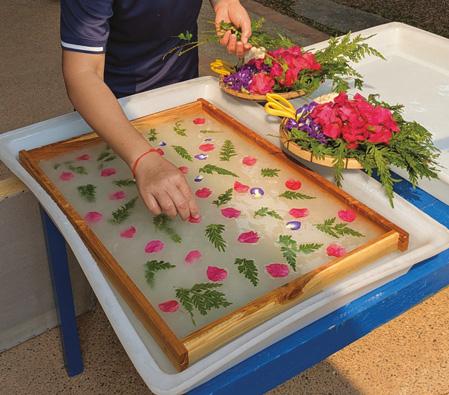
Around 25km north of Luang Prabang, lie the Pak Ou Caves in the side of a steep limestone cliff rising dramatically from the riverbed. Ancient tribes settled in the caves and are believed to be the ancestors of today’s Laotian population. The lower cave, which is visible from the river, is home to as many as 2,500 sculptures made from wood, copper, stone and stick lac, some of which date from the 17th century. About 60 metres up from the river – or 278 steps from the lower cave – lies the upper cave. It’s a short, steep ascent but worth the view of the countryside from up there.
Ban means ‘village’ in Lao and Ban Xang Khong is well-known for making saa (mulberry)
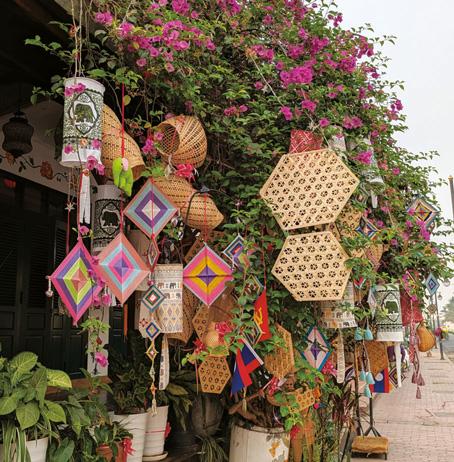
paper. A friendly puppy greets us as we alight on a makeshift dock and ascend 50 steps or so to reach the village where single- and double-storey stone and wooden houses with slanting roofs line the main street along with small handicrafts and souvenir shops. I pop my head into one and watch a local artist put finishing touches to an elephant he’s painted on a massive sheet of saa paper, while elsewhere, smaller freshly made sheets dry in gardens under bright sunshine.
THIS PAGE, CLOCKWISE
FROM TOP: Premier view suite on the upper deck of the boat with a Juliet balcony; handicrafts shop on Main Street in Luang Prabang; sweet coconut dumplings served inside a tender coconut; adding petals and leaves to the raw saa paper sheet.
OPPOSITE PAGE, FROM TOP: A quiet residential lane in Luang Prabang; decorative trays at the morning market in Luang Prabang; the Avani+ is one of only two hotels with a pool in this heritage town.

The Tea House Luang Prabang is a multifaceted business in Ban Xang Khong with a café serving tea, coffee and simple food, an area for saa paper making workshops and a tree-filled garden for tea tastings. Saa paper is made from the bark of the mulberry tree, which is boiled for 48 hours and then pounded to a soft pulp. After watching the demo, I pick up a handful of the pulp and place it on thin metal mesh stretched between a wooden frame, which is immersed in a rectangular basin of water. The trick lies in spreading the pulp evenly to fill the frame so that the final saa paper sheet doesn’t have holes or opaque sections. This is an oddly therapeutic step requiring gentle, circular hand movements through the water and pulp, almost like making a fluffy cloud dissipate. Once the pulp settles against the mesh, flowers and/or leaves are placed artistically across the surface and then pushed under the water, making sure they’re settled against the pulp. At this stage the frame is lifted out of the basin, allowing excess water to drain, before it’s placed in the sun to dry for 24 hours. Your sheet can be packed and sent to your hotel, if you’re staying in Luang Prabang after the cruise.
Before leaving, try the locally made teas here including the rather unusual silkworm poop tea. Silkworm larvae feed largely on mulberry leaves, which are believed to have health benefits according to traditional medicine. Their droppings are removed from the cocoons and
then roasted at 160˚C, a process that changes the chemical structure of the droppings, bringing forth an earthy flavour and an aroma akin to tobacco. If this is too way out for you, opt for the winter blend made from turmeric, orange and cinnamon.
Our next destination Ban Chan Nua is famous for its 400-year-old pottery making tradition. Initially commissioned by the royal Lao court to make clay pots for storing water and fermenting fish, the residents of the village now make an array of everyday and decorative items including terracotta roof tiles, coffee mugs, wind chimes and soup bowls. It’s best to have short nails before this workshop otherwise your piece of pottery is going to get scratched while it’s still on the wheel. The Lao Pottery House is where we spend an hour trying to mold orange clay into recognisable shapes – a skill, I know, I will never master. Firing each piece takes two weeks so participants can choose a free souvenir or buy larger pieces from the on-site shop at the end of the workshop. Or, if you are particularly attached to the piece you create, Keo, the owner, can have it shipped to your home address.
Asri, the cruise manager, ushers everyone off the boat at 8am the next morning, assuring us that seeing Kuang Si Waterfalls without other visitors will be the highlight of our trip. She is not wrong. Surrounded by dense tropical jungle, this three-tiered cascade has pools the colour of turquoise due to the presence of minerals like copper. I let out an embarrassing “Ooooh!” when I spot the first one, only to realise an even more spectacular pool is visible further up the trail.
The main fall drops from a height of 60 metres, tumbling over limestone rocks, before emptying into a series of shallow pools at its base. To the left of the highest cascade is a staircase with 542 steps leading up into the tree canopy. Standing on step number one, my enthusiasm to explore everything gets the better of me. A sweaty 10 minutes later, I make it to the top, where sweeping views of the surrounding mountains are the best reward although the jungle is too thick to see the falls below. The best time to visit Kuang Si Waterfalls is after the monsoon (since the falls tend to become muddy and the pools lose their beautiful colour during the rainy season).
From canapès and drinks at sunset to multicourse lunches and dinners, I was never hungry aboard Bohème. My breakfast of choice is always the traditional Lao breakfast khao piak khao, a creamy porridge made with rice and chicken broth, served with an array of toppings such as spring onions and fried shallots. Ginger, charred onions, lemongrass and kaffir lime leaves give this hearty meal its rich and aromatic
flavour. Pancakes, cereal, French toast, eggs Benedict and omlettes are also available. Chef Vongpasith is a one-man show, keeping our bellies full with meals based on various themes from a farm-to-table dinner featuring beetroot-cured fish (thin marinated strips of fish cured in beetroot and salt) topped with parmesan shavings, mini mozzarella balls, dill honey and fresh rocket, that has a mild sweetness balanced by salty notes; to a Lao lunch with crispy and spicy duck salad, tiger prawns stir-fried with garlic, chilli and Lao Lao (rice whiskey) and deliciously chewy coconut dumplings filled with mung beans sitting atop slivers of tender coconut drizzled with sweet coconut sauce.
The Avani+ enjoys a central location making it the ideal base to explore this unique heritage town. Constructed around a large pool flanked by wide pathways and swathes of lawn, this two-storey hotel has a zen garden vibe and airy, light-filled interiors.

Across the street from the hotel is Luang Prabang’s main thoroughfare lined with buildings constructed in the French Colonial style sitting alongside traditional Lao wooden structures, each home to French bakeries, heritage hotels and guesthouses, cafés, restaurants and clothing stores. Small lanes lead into neat residential areas with flowering frangipani trees and pretty bunting strung across lanes. This thoroughfare springs to life each evening with a night market from 5-10pm. Here, vendors sell a mindboggling array of locally made goods ranging from jungle honey, local jam, organic coffee and tea to ceramics, textiles, handmade bags, artwork and more. The best part about shopping here is none of the vendors try to force visitors to buy their products. After a spot of shopping, I head into a tiny eatery and order fish steamed in banana leaves, fried bamboo shoot stuffed with meat and potato and mango sticky rice – the perfect meal to end the perfect trip.
For more information, visit avanihotels.com and mekongkingdoms.com














All you need to know about the three K-beauty brands recently launched
K-beauty began as a trend aimed at teenagers but has broadened into a global phenomenon with dedicated skincare regimens to achieve ‘glass skin’ and ‘honey skin’ for a healthy, nourished glow, rather than quick fixes and heavy makeup to hide problem areas.
K-Beauty emphasises preventative care and long-term skin health, a philosophy rooted in the Korean cultural emphasis on skincare as a form of self-care and respect for one’s body.
Frudia harnesses the power of fruit extracts to create skincare products that are both effective and refreshing. The brand utilises a unique R VITA W™ (Low Temperature Extraction) technology to preserve the vitamins and antioxidants in fruits, ensuring that the skin receives maximum benefits. Fruit such as pomegranate, blueberry and green grape are rich in antioxidants and vitamins, helping to brighten the complexion, improve skin texture and provide deep hydration. Frudia is known for creating cruelty-free products with lightweight textures and delicious scents using clean ingredients. The brand’s focus on fruit extracts makes it particularly beneficial for individuals with dull or dehydrated skin, offering a boost of radiance and hydration for a healthy, plump glow.

Founded in 2018 by Sarah Choi and Michelle Kwan, Some By Mi quickly gained recognition for its effective solutions for acne-prone and sensitive skin.
The brand’s name, ‘Something By Miracle’, reflects its commitment to delivering transformative results. Its formulations blend natural botanical extracts with advanced scientific research. Key ingredients such as tea tree, centella asiatica, and AHAs, BHAs and


PHAs work together to soothe inflammation, gently exfoliate and promote skin regeneration. This cruelty-free brand’s AHA, BHA, PHA 30 Days Miracle line, which includes a toner, serum and cream, has garnered a cult following for its ability to dramatically improve skin texture and clarity. Some By Mi prioritises clean ingredients and is especially beneficial for individuals with sensitive and oily skin, offering relief from irritation and blemishes while nourishing the skin for a more even complexion.
Drawing inspiration from the beauty rituals of the Joseon Dynasty, the last and longestruling imperial dynasty of Korea, Beauty of Joseon focuses on Hanbang ingredients known for their skin-nourishing properties. Hanbang refers to the use of herbal prescriptions and formulations based on Traditional Korean Medicine. Ingredients such as ginseng, rice bran water and green plum water are carefully selected for their ability to soothe, hydrate and revitalise the skin.
The brand’s cruelty-free products are formulated with a gentle, minimalist approach, avoiding harsh chemicals and focusing on natural ingredients that have been used for centuries making it particularly appealing for those with aging skin. Its Relief Sun: Rice + Probiotics sunscreen, for example, offers broad-spectrum protection while nourishing the skin with rice extract and probiotics.


Quick Japanese nukazuke vegetables 23
Thai corn fritters with sweet chilli
mango sauce 29
Tempura lotus root with togaraashi 33
Piccabelle, lime and tuna ceviche 35
Green olive, fig and tomato bruschetta 35
Cherry tomato and peach salad with balsamic vinaigrette 35
Mixed tomato salad with salmon skin croutons and nori sprinkle 36
Kare pan 55
TikTok spicy Buldak Carbonara noodles 72
Ramen-coated cheese toastie 72
Spicy peanut butter ramen 72
Smoked salmon chawanmushi 75
Bánh bèo with crispy shrimp 77
Sweet and sour sinigang 89
Tom kha gai 89
Onigiri 95
Takoyaki 101
Bánh xèo cua 101
Indonesian sate ayam 102
Jianbing 103
Lace dumplings with dipping sauce 105
Gamja jorim 109
Pajeori (Korean green onion salad) 111
Oi muchim 113
Japchae 113
Yachae jeon 113
Korean potato crispy corndogs 117
Larb with Crunchita lettuce and lotus chips 117
Crispy duck skin and chilli crunch on pancakes 117
Matcha tamago sando 129
Thai coconut cooler
Vietnamese cherry and dark chocolate cloud latte
Strawberry milk with lemon sugar
Sesame jelly coffee with whipped tahini cream
Pansy blossom iced tea with boba
Salted vanilla iced matcha
Laotian fermented chilli sauce
Home-made dashi stock
Home-made furikake
Kimchi fried rice with crispy fried egg
Roasted rhubarb with Sichaun pepper
amok
kare kare
Bún g o xào chay
kway



















